Transportation and the Decarbonisation Challenge State of the World
Navigating the path to a greener tomorrow: Strategies for sustainable transportation and decarbonisation


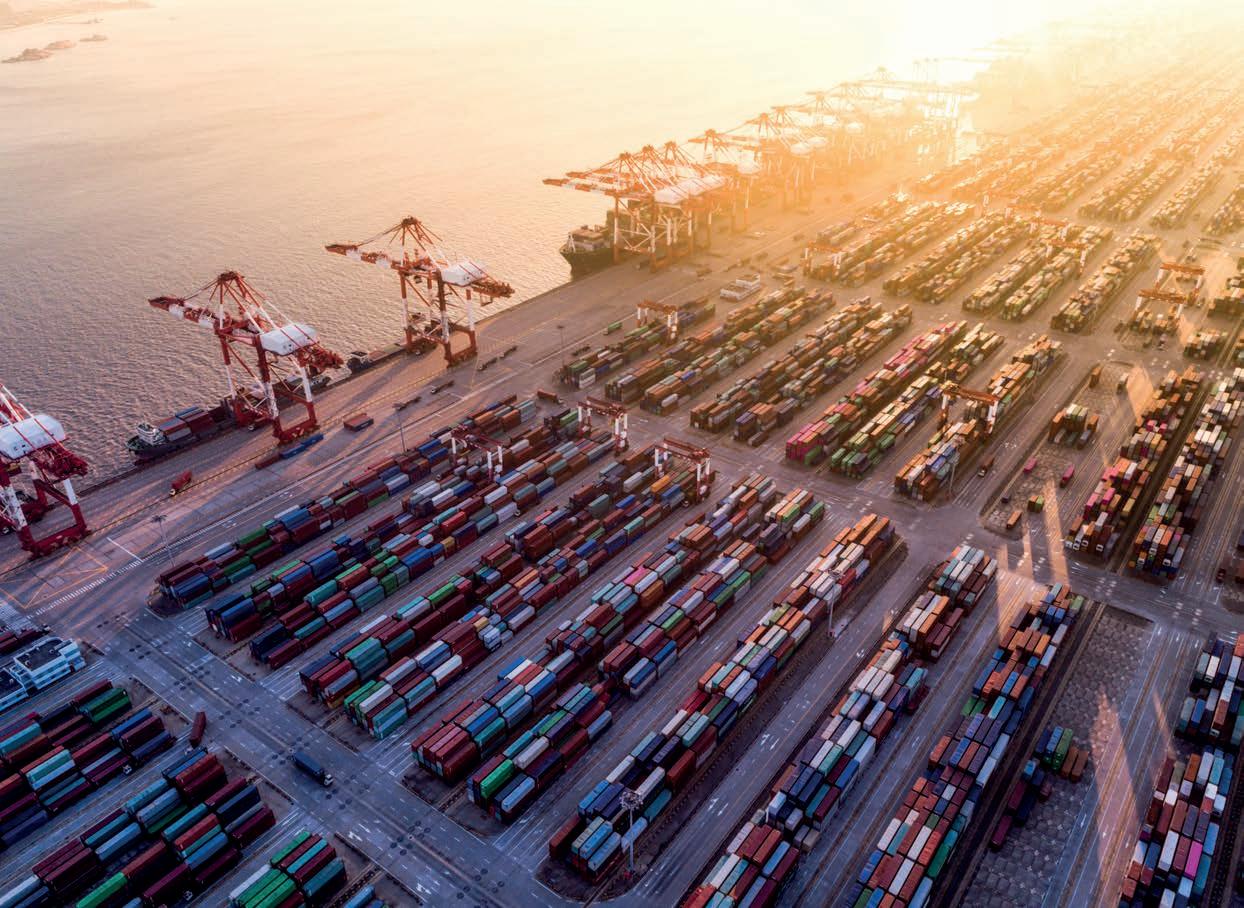

Navigating the path to a greener tomorrow: Strategies for sustainable transportation and decarbonisation



 Catherine Karakatsanis M.E.Sc P.Eng ICD.D FEC FCAE. LL.D President, FIDIC
Catherine Karakatsanis M.E.Sc P.Eng ICD.D FEC FCAE. LL.D President, FIDIC
As FIDIC continues to explore and analyse the key issues that are facing our sector on the path to a truly sustainable future this year’s first State of the World report for 2024, finds the sector at a critical juncture in history. This moment is pivotal, not just in the trajectory of global development and sustainability, but also in our ongoing commitment to addressing the most pressing challenges facing the transportation sector today.
The theme of this report, Tomorrow’s Transportation and the Decarbonisation Challenge, encapsulates the urgency and complexity of the issues we face. As we celebrate over a century of engineering excellence, it becomes increasingly clear that our future hinges on our ability to adapt, innovate and reimagine the way we approach transportation and environmental stewardship.
Transportation, in all its forms, plays a central role in shaping our world. Despite Covid causing short term disruption, global trade and travel will be a significant part of the future. From the bustling ports to the skies above, the choices we make today will reverberate for generations to come. This report delves into the intricate web of challenges and opportunities that define the landscape of sustainable transportation, from aviation to maritime, from policy frameworks to technological innovations.
Just as the ‘war of currents’ revolutionised energy markets in the past, as highlighted in our previous report on energy systems, the decisions we make today have the potential to fundamentally reshape the future of transportation systems worldwide. The shift towards sustainability is not just a moral imperative, it is an economic necessity and a strategic imperative for our planet’s future.
Throughout this report, we pose critical questions and seek thoughtful answers:
• Are our current transportation systems compatible with our aspirations for a sustainable future?
• How can we navigate the complexities of policy, technology and investment to chart a course towards decarbonisation and resilience?
We explore the role of engineering innovations, policy frameworks and cross-sectoral collaborations in driving meaningful change. From sustainable aviation fuels to eco-friendly port infrastructure, from global policy initiatives to local community-driven solutions, we uncover the multifaceted dimensions of tomorrow’s transportation landscape.
As we confront the challenges ahead, we draw inspiration from the UN sustainable development goals (SDGs) and the imperative of achieving net zero emissions. These ambitious targets serve as our guiding star, guiding us towards a future where transportation is not just efficient and accessible but also equitable and environmentally sustainable.
Together, as a sector we will need to explore the pathways to a more sustainable and resilient transportation future. Not to do so will not only pose a threat to meeting the SDGs, net zero but also the potential sustainability of the sector and society as a whole. By aligning policy, engineering expertise and collective action, we can overcome the decarbonisation challenge and build a brighter tomorrow for generations to come.

This comprehensive report on Tomorrow’s Transportation and the Decarbonisation Challenge comes at a pivotal time where we can no longer just discuss the easy options to improve sustainability but have to tackle the difficult challenges. As stewards of innovation, FIDIC, the International Federation of Consulting Engineers, takes pride in shedding light on the pressing need to transform transportation systems to meet global sustainability goals. This report explores the critical role of the aviation, shipping and marine sectors in the fight against climate change, emphasising the importance of engineering innovations and policy interventions in driving sustainability.
The transportation sector is a significant contributor to global greenhouse gas emissions, making it a focal point in the quest to mitigate climate change. This report delves into the advancements in Sustainable Aviation Fuels (SAFs), innovative practices in shipping and marine transportation, eco-friendly port and marine infrastructure and the critical policy frameworks guiding these transformations. While the report primarily explores the intricacies of aviation and marine sectors, it also briefly touches upon the decarbonisation endeavours concerning rail and road transportation.
Addressing the environmental challenges of transportation necessitates a holistic approach that integrates technological advancements, financial mechanisms and robust regulatory frameworks. The interconnected nature of these elements means that progress in one area can significantly impact others. For instance, the development of SAFs requires not only technological innovation but also supportive policies and financial investments. Similarly, the adoption of energy-efficient ship designs hinges on both engineering ingenuity and regulatory support. Increasingly it is also important that such regulatory support is not just national, trans regional but global to effect real change.
An integrated approach ensures that these elements work synergistically, amplifying their collective impact. By aligning technological innovations with financial incentives and regulatory frameworks, we can create a sustainable transportation ecosystem that is resilient, efficient and environmentally friendly. This holistic strategy is essential for achieving the global decarbonisation goals set by international agreements and national policies.
FIDIC is steadfast in its commitment to sustainability and the promotion of sustainable engineering practices. FIDIC’s role in facilitating global dialogue, advocating for supportive policies and fostering cross-sectoral partnerships underscores its dedication to driving meaningful change in the transportation sector.
Through our diverse range of training programmes and courses offered by the FIDIC Academy, which includes comprehensive modules on sustainability, FIDIC ensures engineers and the FIDIC community are equipped with the necessary skills and insights to address emerging challenges. Our flagship events, such as the Global Leadership Forum (GLF) Summit and the annual Global Infrastructure Conference, provide pivotal platforms for knowledge exchange and collaboration. These gatherings bring together industry leaders, policymakers and experts to discuss and advance sustainable engineering practices. Additionally, FIDIC’s ongoing advocacy for supportive policies creates an enabling environment that fosters innovation and progress in the engineering sector.
FIDIC’s call to action is clear - engineers, policymakers, industry leaders and stakeholders must work together to advance sustainable transportation solutions. By leveraging collective expertise and resources, the engineering community can develop and implement strategies that significantly reduce carbon emissions and promote environmental sustainability.
The ongoing need for innovation, collaboration and policy advocacy
Innovation, collaboration and policy advocacy remain the cornerstones of achieving sustainable transportation. Continuous innovation is essential for developing new technologies and improving existing ones. From hydrogen-powered vehicles to electric propulsion systems, technological advancements are driving the transition towards greener transportation modes.
Collaboration across sectors and industries is equally important. Cross-sectoral partnerships enable the sharing of knowledge, resources and best practices, fostering a collaborative approach to sustainability. Policy, regulation, legislation and advocacy plays a crucial role in creating the frameworks and financial incentives needed to support sustainable transportation. FIDIC’s engagement with international organisations, governments and industry bodies ensure that the engineering community’s voice is heard in policy discussions. Advocacy for consistent and supportive policies is vital for enabling the large-scale adoption of sustainable technologies and practices.
The road ahead is challenging, but the potential for positive impact is immense. The transportation sector’s transition to sustainability is not just a necessity, it is an opportunity to innovate, collaborate and lead by example.
As we move forward, the whole infrastructure sector must embrace the imperative for an integrated approach, support ongoing innovation, foster collaboration and advocate for policies that drive sustainable transportation.
Key highlights of the report:
Overview of transportation’s global impact on climate change:
• The report provides an in-depth analysis of the transportation sector’s contributions to global carbon emissions, underscoring the urgent need for sustainable solutions.
Importance of the aviation, shipping and marine sectors in emissions:
• We explore the substantial impact these sectors have on emissions and the unique challenges they face in transitioning to greener alternatives.
The role of engineering innovations and policy in sustainability:
• The report highlights the critical role of engineering advancements and policy frameworks in promoting sustainable practices across transportation modes. Case studies illustrate how innovative technologies and supportive policies can drive meaningful change.
FIDIC’s commitment to driving change through this report:
• FIDIC’s dedication to sustainability is evident in its proactive initiatives, such as the FIDIC Academy’s educational programs, the GLF Summit and advocacy for supportive policies.
Recommendations:
The entire FIDIC community, including engineers, policymakers, industry leaders and stakeholders, should integrate sustainable practices into every phase of transportation projects. This includes adopting advanced biofuel technologies, synthetic fuels and energy-efficient designs to reduce carbon emissions across aviation, shipping, and marine sectors.
Emphasise the importance of leveraging cutting-edge technologies such as digitalisation, IoT, AI and renewable energy solutions to enhance operational efficiency and sustainability. All members of the FIDIC community should advocate for and implement these innovative solutions.
The FIDIC community should work closely with policymakers to create regulatory frameworks that include promoting policies that incentivise the use of sustainable aviation fuels, electrification in shipping and the development of eco-friendly port infrastructure. Whilst some of these may be transitional there will be other that will be enduring post 2050. No action is more dangerous than transitional action.
Collaboration across sectors is crucial for achieving global decarbonisation goals. The FIDIC community is called to engage in partnerships with government bodies, industry stakeholders, academic institutions and non-governmental organisations to share knowledge, resources and best practices in sustainability.
5
To drive the transition towards sustainable transportation, a global initiative is needed to create a stable environment for developing and implementing transitional and future measures. This effort should focus on equipping both new and existing engineers with the necessary skills and knowledge. Training and educational initiatives must prioritize continuous learning and professional development through courses, webinars, and workshops focused on sustainability.

/Charting sustainable transportation - an overview
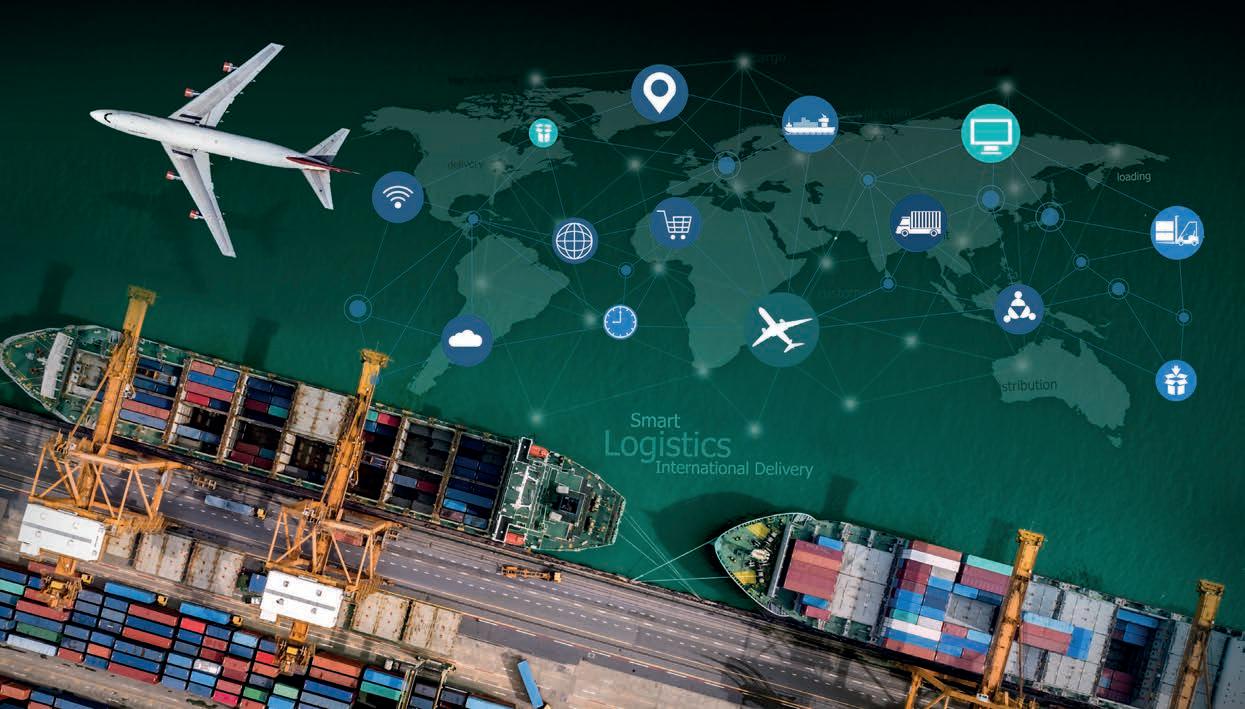
A leading contributor to global emissions in the global battle against climate change, transportation emerges as a significant contributor to carbon dioxide emissions, with its impact reverberating across aviation, shipping and marine sectors. The exponential growth in global trade and travel has propelled these industries to unprecedented levels, amplifying their carbon footprint and exacerbating the climate crisis.
The high-flying emitter
The aviation industry, synonymous with rapid globalisation and intercontinental connectivity, stands as a major emitter of greenhouse gases. From commercial airliners ferrying passengers across vast distances, to freight carriers transporting goods worldwide , aviation activities release substantial quantities of carbon dioxide and other pollutants into the atmosphere. Despite advancements in aircraft efficiency and the emergence of sustainable aviation fuels, the relentless expansion of air travel continues to drive emissions upwards, posing a formidable challenge in the quest for climate neutrality.
Navigating through emission challenges
Similarly, the shipping and maritime sectors play a pivotal role in global trade, facilitating the movement of goods across oceans and continents. The reliance on traditional fossil fuels and outdated propulsion systems, however, has led to significant emissions of carbon dioxide, sulphur oxides and nitrogen oxides. From container vessels laden with cargo to tanker ships transporting oil and gas, maritime activities contribute substantially to atmospheric pollution, marine degradation and climate change. According to the United Nations Conference on Trade and Development (UNCTAD), the average annual growth rate of maritime trade volume has been around 3% to 4% and expected to grow more in the coming decade. As the demand for maritime transportation grows, so too does the imperative to adopt cleaner technologies, improve fuel efficiency and reduce emissions across the shipping industry.
Sailing towards sustainability
Beyond shipping, marine transportation encompasses a diverse array of activities, including fishing, tourism and recreational boating, all of which impact the environment to varying degrees. Whether it’s cruise ships traversing pristine waters or fishing fleets harvesting marine resources, these activities release greenhouse gases and pollutants, further exacerbating the ecological strain on oceans and coastal regions. The challenge lies in balancing the economic benefits of marine transportation with the imperative to protect fragile marine ecosystems, mitigate pollution and combat climate change.
Towards sustainable transportation
Transportation, like construction continues to be a critical frontier in the fight against climate change, concerted efforts are underway to transition towards more sustainable practices and technologies. From investing in renewable energy sources to promoting energy-efficient transportation systems, stakeholders across the aviation, shipping and marine sectors are exploring innovative solutions to reduce emissions, minimise environmental impact and foster resilience in the face of a changing climate. By embracing collaboration, innovation and policy reform, we can chart a course towards a more sustainable transportation future - one that preserves the planet for future generations while ensuring the seamless movement of people and goods around the globe.
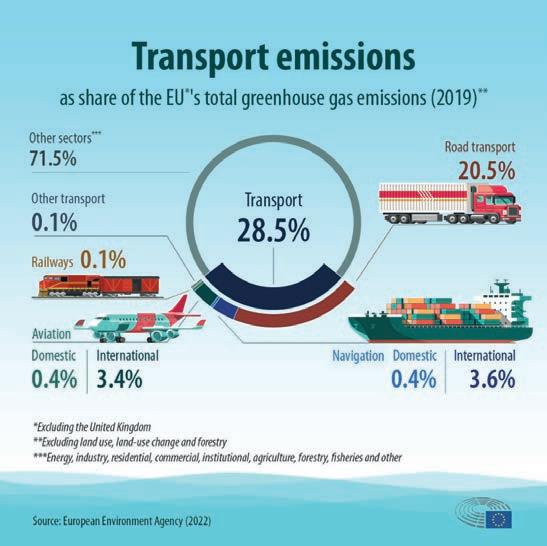
As discussed above, in the panorama of global emissions, certain sectors emerge as pivotal battlegrounds in the fight against climate change. Among these, aviation, shipping and marine transportation stand out as formidable challenges , their influence reverberating far beyond their immediate spheres of operation. Understanding why these sectors demand urgent attention is crucial for grasping the broader implications of climate action and charting a sustainable path forward.
Aviation’s significance in the emissions landscape is underscored by its unique blend of ubiquity and impact. The sector’s rapid expansion, which projects a doubling of air traffic in the coming decades, has propelled it to the forefront of climate discourse. This activity in coming decades, amplifying the sector’s carbon footprint and exacerbate its environmental footprint if no action is taken. Addressing aviation emissions is thus imperative to curbing overall greenhouse gas levels and mitigating the sector’s disproportionate contribution to climate change.
Shipping, as the lifeblood of global commerce, plays a pivotal role in shaping the interconnectedness of our modern world. The sheer volume of goods transported by sea underscores the sector’s significance in the emissions equation. While shipping’s share of global emissions may appear modest, its long-term impact is profound. The reliance on fossil fuels, coupled with the sector’s projected growth, necessitates urgent action to curb emissions and steer maritime trade toward sustainability. Moreover, the environmental consequences of shipping extend beyond emissions, encompassing issues such as marine pollution, habitat degradation and invasive species introduction. Addressing these challenges is essential to safeguarding the health of our oceans and ensuring the resilience of marine ecosystems.
Marine transportation: The nexus of connectivity
Marine transportation, encompassing a diverse array of vessels and activities, occupies a unique position at the intersection of commerce, travel and resource extraction. From ferries and cruise ships to fishing fleets and offshore platforms, the sector exerts a profound influence on coastal communities and marine ecosystems. As the pressures on marine ecosystems intensify, addressing the environmental footprint of marine transportation becomes increasingly urgent. Sustainable practices and innovative technologies offer pathways to mitigate these impacts and ensure the long-term viability of marine transportation.
Addressing the emissions and environmental impacts of aviation, shipping and marine transportation is paramount to achieving global climate goals and safeguarding the health of our planet. By targeting these sectors, we can catalyse transformative change across interconnected systems, fostering a more sustainable and resilient future for generations to come.
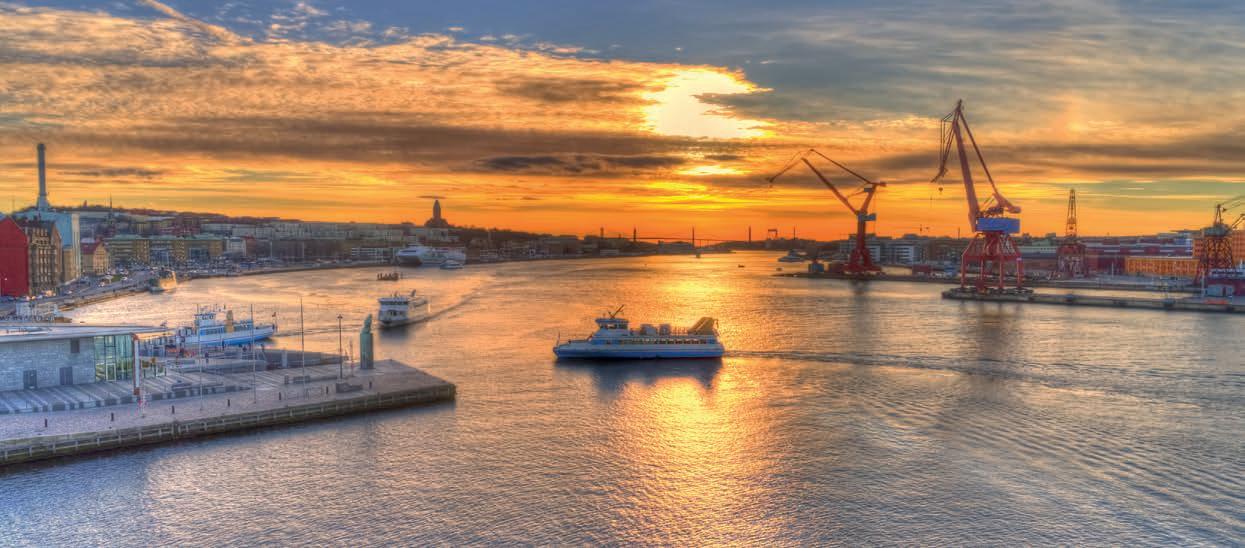
The synergy between technological advancements and regulatory frameworks forms the backbone of efforts to decarbonise transportation, driving the sector towards a more sustainable and resilient future. This next section delves into the pivotal role that engineering innovations and policy play in fostering sustainability, with a particular focus on marine and aviation in the transportation industry, and underscores FIDIC’s commitment to leading this transformative journey.
Engineering innovations are at the heart of the transition towards sustainable transportation. These innovations span a broad spectrum, from advancements in vehicle technology to the development of smart infrastructure, all aimed at reducing carbon emissions and enhancing efficiency.
One of the most significant advancements in transportation engineering is the development and deployment of electric vehicles (EVs). EVs represent a paradigm shift in the automotive industry, offering a cleaner alternative to traditional internal combustion engine vehicles. The proliferation of EVs is supported by improvements in battery technology, which have increased energy density, reduced costs and extended vehicle range.
Similarly, the aviation industry is witnessing groundbreaking innovations aimed at reducing its environmental footprint. The development of sustainable aviation fuels (SAFs), which are derived from renewable resources such as biomass, offers a promising pathway to decarbonise air travel. Airlines like SpiceJet in India are leading the charge by integrating SAFs into their operations, demonstrating the potential for significant emissions reductions.
This also has encouraged the exploration of electric and hybrid-electric aircraft by companies such as Airbus and Boeing represents a forward-thinking approach to sustainable aviation. These examples will be delved into in more detail in later chapters in this report.
In the maritime sector, engineering innovations are driving the adoption of cleaner fuels and more efficient ship designs. The transition to liquefied natural gas (LNG) as a marine fuel, coupled with the development of electrified propulsion systems, is helping to reduce the carbon intensity of shipping.
The Port of Singapore, for instance, has implemented green initiatives that include the deployment of LNG bunkering facilities and the promotion of energy-efficient vessel operations. This is another example that will be explored in detail in later chapters.
While engineering innovations provide the technological foundation for sustainable transportation, effective policy frameworks are essential to steer these innovations towards impactful outcomes. Policies and regulations create the enabling environment that encourages the adoption of sustainable practices, sets industry standards and drives investment in green technologies.
Carbon pricing mechanisms, such as carbon taxes and cap-and-trade systems, are powerful policy tools that incentivise emissions reductions by assigning a cost to carbon emissions. The European Union Emissions Trading System (EU ETS) is a prominent example, setting a cap on the total level of greenhouse gas emissions and allowing industries to buy and sell emission allowances. This market-based approach provides financial incentives for companies to invest in low-carbon technologies and improve their environmental performance. Increasingly areas around the globe are looking at such mechanisms and not only how they can encourage positive behaviour but also fund innovation and the shift towards a truly sustainable net zero future.
Renewable energy mandates and subsidies from levies such as ETS are another critical component of policy frameworks that support sustainable transportation. By setting targets for renewable energy use and providing financial incentives, governments can accelerate the transition to cleaner energy sources. For example, the United States’ Renewable Fuel Standard (RFS) mandates the blending of renewable fuels with gasoline, promoting the use of biofuels and reducing reliance on fossil fuels.
Furthermore, regulatory standards for vehicle emissions and fuel efficiency play a crucial role in shaping industry practices. The International Maritime Organization’s (IMO) sulphur cap, which limits the sulphur content in marine fuels, has driven the shipping industry to adopt cleaner fuels and emissions control technologies. Similarly, the International Civil Aviation Organization’s (ICAO) Carbon Offsetting and Reduction Scheme for International Aviation (CORSIA) aims to stabilise carbon emissions from international aviation at 2020 levels by requiring airlines to offset their emissions growth through the purchase of carbon credits .
Exemplifying the synergy of engineering and policy in aviation and marine sectors
The transformative potential of engineering innovations and policy interventions is vividly illustrated through real-world examples in the aviation and marine sectors. Later in this report we will discuss case studies in details but detailed below are some of the topics that will be discussed. These case studies demonstrate how the synergy between cutting-edge technology and effective policy can drive significant sustainability advancements.
The development and deployment of SAFs offer a compelling example of how engineering innovation, supported by policy, can lead to substantial emissions reductions in the aviation industry. SAFs are produced from renewable resources such as biomass, waste oils and agricultural residues and can significantly lower the carbon footprint of air travel.
A notable case is the collaboration between KLM Royal Dutch Airlines and SkyNRG, a pioneer in sustainable aviation fuel production. With support from the Dutch government, this partnership has enabled KLM to operate regular flights using SAFs, demonstrating the feasibility and environmental benefits of alternative fuels. Policies such as the European Union’s Renewable Energy Directive (RED II) have played a crucial role in promoting the use of SAFs by mandating higher targets for renewable energy in transport, including aviation.
The maritime sector has seen significant strides in sustainability through engineering innovations and supportive policies. The adoption of Liquefied Natural Gas (LNG) as a marine fuel and the implementation of energy-efficient ship designs are prime examples of how technology and policy can converge to reduce emissions.
The Port of Rotterdam, Europe’s largest port, has been at the forefront of green shipping initiatives. The port’s LNG bunkering infrastructure enables ships to refuel with LNG, a cleaner alternative to traditional marine fuels. This initiative is supported by the European Union’s Alternative Fuels Infrastructure Directive, which aims to establish a comprehensive network of refuelling stations for alternative fuels, including LNG, across Europe.
Additionally, the Energy Efficiency Design Index (EEDI) set by the International Maritime Organization (IMO) mandates that new ships meet specific energy efficiency standards, encouraging the development of more efficient vessel designs. One example is the use of air lubrication systems, which reduce friction between the hull and water, thereby lowering fuel consumption and emissions. Japanese shipping company NYK Line has implemented this technology on several of its vessels, achieving significant energy savings and emission reductions.
In the marine transportation sector, hybrid and electric propulsion systems for ferries showcase the potential of engineering innovation combined with supportive policy frameworks. These systems reduce reliance on fossil fuels and lower greenhouse gas emissions, contributing to cleaner and more sustainable marine transportation.
The Norwegian ferry industry provides a compelling example of this synergy. Norway has implemented stringent emissions regulations and offers financial incentives for the adoption of low-emission technologies. The result is a growing fleet of electric and hybrid ferries, such as the MF Ampere, the world’s first all-electric car ferry. The MF Ampere, operated by Norled, uses battery technology developed by Siemens and has significantly reduced CO2 emissions compared to traditional diesel-powered ferries. This initiative aligns with Norway’s National Transport Plan, which aims to achieve zero-emission maritime transport by 2050.


In the quest to decarbonise aviation, the development of SAFs is a critical frontier. Biofuel technologies and synthetic fuels represent two promising avenues that have the potential to significantly reduce the carbon footprint of air travel. This chapter delves into the latest advancements in these technologies, highlighting their potential, challenges and real-world applications.
Biofuel technologies: Harnessing nature’s potential
Biofuels, derived from organic materials, are emerging as a viable alternative to conventional jet fuels. These fuels are produced from various feedstocks, including agricultural residues, waste oils and non-food crops. The advantage of biofuels lies in their ability to recycle carbon from the atmosphere, thereby achieving a net reduction in greenhouse gas emissions compared to fossil fuels.
One of the most significant advancements in biofuel technology is the development of Hydroprocessed Esters and Fatty Acids (HEFA) fuels. HEFA fuels are produced through the hydroprocessing of renewable lipids, such as vegetable oils and animal fats. This process removes oxygen from the feedstock, resulting in a fuel that is chemically similar to traditional jet fuel and can be used in existing aircraft engines without modification.
A real-world example of HEFA fuel adoption is by United Airlines, which has been operating flights using a blend of traditional jet fuel and HEFA biofuel produced by World Energy. This initiative is part of United’s broader commitment to reduce its greenhouse gas emissions by 50% by 2050. According to the airline, the use of HEFA biofuel can reduce lifecycle greenhouse gas emissions by up to 80% compared to conventional jet fuel.1
Another promising biofuel technology is Alcohol-to-Jet (ATJ) fuel. ATJ fuels are produced by converting alcohols, such as ethanol or butanol, into jet fuel through a series of chemical reactions. LanzaTech, a leading sustainable fuels company, has developed a proprietary process to produce ATJ fuel from industrial waste gases.
In partnership with Virgin Atlantic, LanzaTech successfully demonstrated the use of ATJ fuel on a commercial flight from Orlando to London in 2018. This milestone flight showcased the potential of ATJ fuel to reduce aviation emissions and highlighted the importance of industrial partnerships in scaling sustainable fuel technologies.

Synthetic fuels, also known as e-fuels, are another promising avenue for sustainable aviation. These fuels are produced through the synthesis of hydrogen and carbon dioxide, using renewable energy sources such as wind, solar or hydropower. The resulting fuel is a drop-in replacement for conventional jet fuel, offering the same performance characteristics with a significantly lower carbon footprint.
One of the key advancements in synthetic fuel technology is the development of Power-to-Liquid (PtL) processes. PtL technology involves the electrolysis of water to produce hydrogen, which is then combined with captured carbon dioxide to create synthetic hydrocarbons. This process not only produces sustainable fuel but also offers a way to utilise excess renewable energy and mitigate carbon emissions from industrial sources.
A notable example of synthetic fuel development is the partnership between the German research organisation Fraunhofer and the industrial gas company Linde. Together, they have developed a PtL pilot plant that produces synthetic jet fuel using renewable energy and captured CO2. This pilot project demonstrates the feasibility of synthetic fuel production and paves the way for larger-scale deployment.2
While the advancements in biofuel and synthetic fuel technologies are promising, several challenges remain. The production costs of SAFs are currently higher than those of conventional jet fuel, making widespread adoption economically challenging. Additionally, the availability of sustainable feedstocks for biofuels and the scalability of synthetic fuel production are critical factors that need to be addressed.
The opportunities, however, are substantial. Policy support, such as the European Union’s Renewable Energy Directive (RED II) and the US Renewable Fuel Standard (RFS), provides incentives for the production and use of SAFs. Furthermore, technological advancements and economies of scale are expected to drive down costs over time, making SAFs more competitive with traditional jet fuels.
The advancements in biofuel technologies and synthetic fuels represent a significant step forward in the quest to decarbonise aviation. By harnessing the potential of these sustainable fuels, the aviation industry can achieve substantial reductions in greenhouse gas emissions and contribute to the global fight against climate change. With continued innovation, supportive policies and collaborative efforts, the vision of sustainable aviation is within reach, promising a cleaner and more sustainable future for air travel.


The adoption of SAFs marks a transformative shift in the aviation industry’s journey towards sustainability. Airlines across the globe are increasingly recognising the potential of SAFs to reduce their carbon footprint and contribute to global climate goals. This chapter explores notable case studies of airlines that have pioneered the use of SAFs, with a special focus on India’s SpiceJet, highlighting their efforts, achievements and the impact of these initiatives.

SpiceJet: Leading the charge in India
SpiceJet, one of India’s leading low-cost carriers, has taken significant strides in embracing SAFs, setting a commendable example for the aviation industry in the region. In August 2018, SpiceJet made history by operating India’s first biofuel-powered flight. The flight, which travelled from Dehradun to Delhi, used a blend of 75% aviation turbine fuel and 25% biofuel derived from the Jatropha plant. This pioneering initiative was a collaborative effort involving the Indian Institute of Petroleum, Dehradun, and several industry partners.3
The biofuel used in SpiceJet’s flight was sourced from the Jatropha plant, which is known for its high oil content and ability to grow on marginal lands, making it a sustainable feedstock. The successful demonstration of this biofuel-powered flight highlighted the potential for scaling up the use of SAFs in India’s aviation sector. According to SpiceJet, the use of biofuel resulted in a 15% reduction in carbon emissions for the flight, showcasing the environmental benefits of SAF adoption.
Following this milestone, SpiceJet has continued to explore opportunities for integrating SAFs into its operations. The airline’s commitment to sustainability is reflected in its strategic vision and partnerships aimed at advancing biofuel research and development. By setting a precedent for other Indian airlines, SpiceJet is playing a crucial role in driving the adoption of SAFs in the region.
United Airlines has been a frontrunner in the adoption of SAFs. In 2016, United became the first US airline to use SAFs in regular operations. The airline partnered with World Energy to use SAFs produced from agricultural residues and waste oils. United Airlines has since operated numerous flights using a blend of traditional jet fuel and SAFs, achieving substantial reductions in carbon emissions. In 2021, United Airlines announced a groundbreaking partnership with Fulcrum BioEnergy to purchase up to 900 million gallons of SAF over 20 years, reinforcing its long-term commitment to sustainability.4

Lufthansa, a major European carrier, has also been actively involved in SAF adoption. The airline’s «Pure Sky» project, launched in 2011, focused on integrating SAFs into its operations. Lufthansa conducted a six-month trial using biofuel produced from Jatropha, camelina and animal fats on its flights between Frankfurt and Hamburg. The trial demonstrated a significant reduction in carbon emissions and provided valuable data on the operational feasibility of SAFs. Lufthansa’s continued investments in SAF research and partnerships with biofuel producers underscore its dedication to sustainable aviation.5
Qantas, the flagship carrier of Australia, has made notable progress in SAF adoption through its «Fly Carbon Neutral» programme. In 2018, Qantas operated the first biofuel flight between Australia and the United States, using a blend of SAFs derived from mustard seed. The flight achieved a 7% reduction in carbon emissions compared to traditional jet fuel. Qantas has set ambitious targets to increase its use of SAFs and reduce its carbon footprint, aligning with Australia’s broader climate goals.
The adoption of SAFs by airlines worldwide has far-reaching implications for the aviation industry and the environment. According to the International Air Transport Association, SAFs can reduce lifecycle carbon emissions by up to 80% compared to conventional jet fuel. This significant reduction in emissions is crucial for the aviation industry, which is responsible for approximately 2-3% of global carbon dioxide emissions.6
SAFs also offer additional environmental benefits, including reduced particulate matter and sulphur emissions, which contribute to improved air quality and public health. Moreover, the production of SAFs from sustainable feedstocks, such as agricultural residues and waste oils, supports circular economy principles and promotes sustainable agriculture.
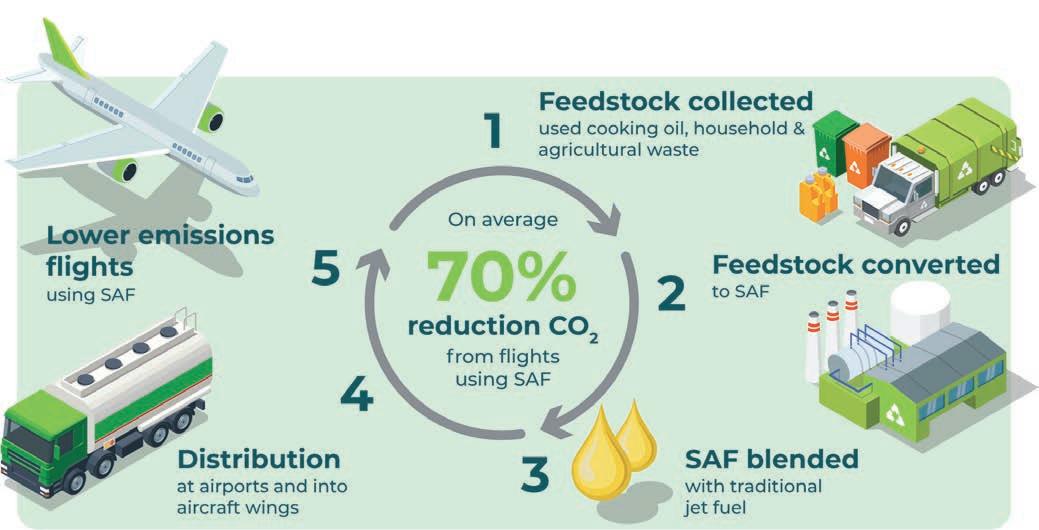
While the adoption of SAFs presents numerous benefits, several challenges must be addressed to achieve widespread implementation. The production costs of SAFs are currently higher than those of conventional jet fuel, primarily due to limited feedstock availability and production scale . Ongoing research and development efforts, however, along with supportive policies and incentives, are expected to drive down costs and enhance the economic viability of SAFs.
Policy support is critical to accelerating SAF adoption. Governments and regulatory bodies play a vital role in creating a favourable environment for SAF production and use through measures such as tax incentives, subsidies, and mandates. The European Union’s Renewable Energy Directive and the US Renewable Fuel Standard are examples of policies that have successfully promoted SAF adoption.
The adoption of SAFs by airlines such as SpiceJet, United Airlines, Lufthansa and Qantas highlights the transformative potential of sustainable aviation fuels in reducing the carbon footprint of air travel. These case studies underscore the importance of innovation, collaboration and policy support in advancing SAF adoption. As the aviation industry continues to navigate the decarbonisation challenge, the integration of SAFs into regular operations represents a critical step towards a more sustainable and resilient future for air travel. Through continued efforts and collective action, the vision of sustainable aviation is within reach, promising a cleaner and greener future for the global aviation industry.
As the aviation industry takes flight on its journey towards sustainability, it encounters a myriad of challenges. These obstacles, spanning technological, economic and regulatory domains, present significant hurdles that must be overcome to achieve widespread adoption of SAFs and other green innovations.
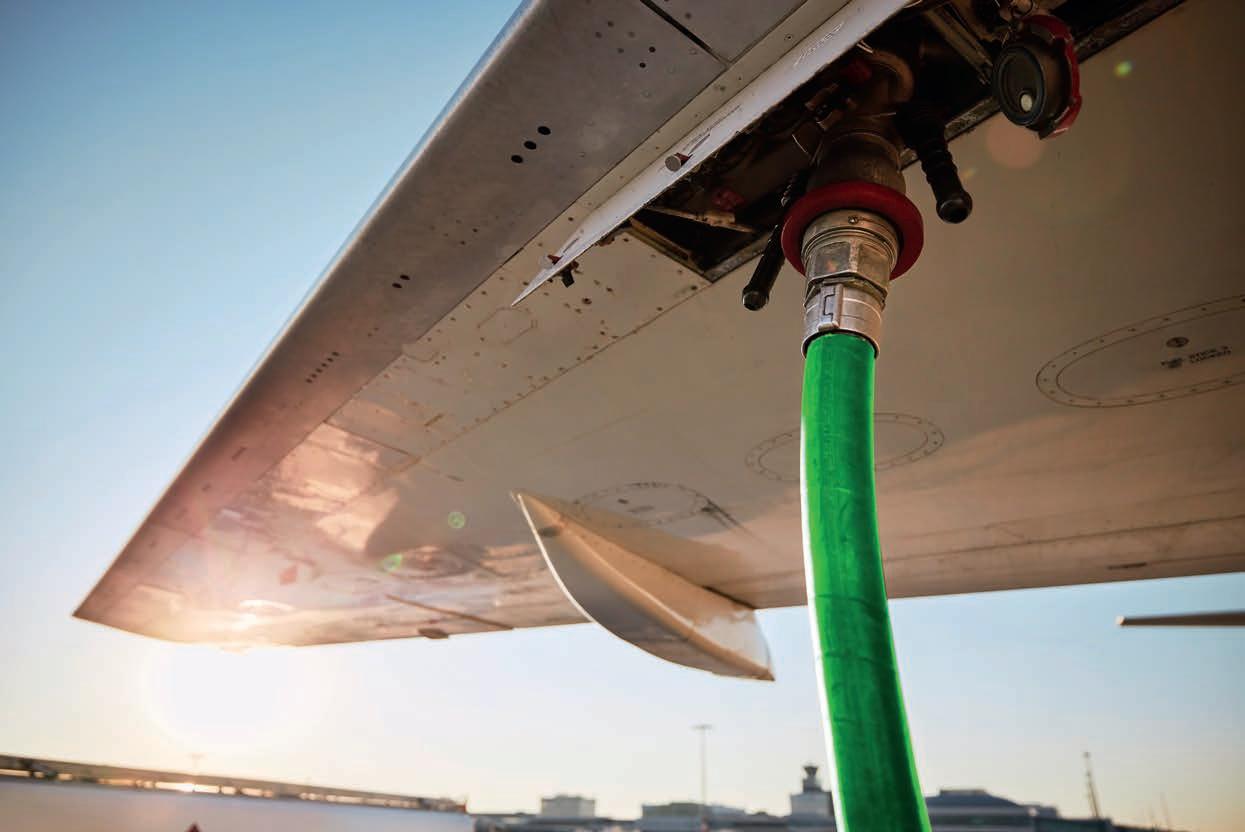
One of the foremost technological challenges in implementing SAFs is achieving production scalability and efficiency. Current production methods for biofuels and synthetic fuels are not yet capable of meeting the vast fuel demands of the global aviation industry. For instance, the process of producing HEFA fuels, which involves hydroprocessing renewable lipids, requires significant energy and resources. Scaling up this production to a level that can supply major airlines consistently is a daunting task.
The availability and sustainability of feedstocks for biofuel production are critical concerns. Feedstocks such as agricultural residues, waste oils and non-food crops are essential for producing biofuels, but their supply is limited and subject to competition from other industries. Additionally, the cultivation of feedstocks must be managed sustainably to avoid negative impacts on food security and land use. For example, the large-scale cultivation of Jatropha, a promising biofuel feedstock, has raised concerns about its potential to displace food crops and degrade land.
The technological maturity of SAF production processes varies, with some methods still in experimental stages. ATJ fuel production, which converts alcohols into jet fuel, has shown promise but requires further refinement to enhance efficiency and reduce costs. Similarly, the production of synthetic fuels through PtL processes, which involve the synthesis of hydrogen and carbon dioxide, is in its infancy and faces challenges related to energy input and conversion efficiency.
The integration of SAFs into existing aviation infrastructure poses another technological challenge. While some SAFs can be used as drop-in fuels, compatible with current aircraft engines and fuelling systems, others may require modifications to infrastructure and equipment. For instance, the storage and distribution of LNG for aviation would necessitate significant upgrades to fuelling infrastructure at airports.
The high production costs of SAFs remain a significant barrier to their widespread adoption. Compared to conventional jet fuel, SAFs are considerably more expensive due to the complexities of their production processes and the costs associated with feedstock procurement. For example, the production cost of HEFA fuels is currently estimated to be two to three times higher than that of conventional jet fuel. This price disparity makes it challenging for airlines to adopt SAFs without substantial financial incentives or regulatory mandates.
The biofuel market is subject to volatility in feedstock prices and supply chain disruptions, which can impact the stability of SAF production and pricing. Factors such as crop yield variations, geopolitical events, and changes in agricultural policies can lead to fluctuations in feedstock availability and costs. This volatility creates uncertainty for airlines and biofuel producers, hindering long-term planning and investment.
Securing investment and financing for SAF production facilities and infrastructure is another economic challenge. The high capital expenditure required to build and scale up biofuel refineries and synthetic fuel plants can deter investors, particularly in the absence of clear policy signals and financial incentives. Moreover, the nascent nature of some SAF technologies means that they may be perceived as high-risk investments.
The competitiveness of SAFs with conventional jet fuels is influenced by various economic factors, including subsidies, tax incentives and carbon pricing mechanisms. While some governments have introduced policies to support SAF adoption, such as tax credits and grants, the level of support varies globally. In regions where fossil fuels are heavily subsidised, SAFs struggle to compete on price, impeding their market penetration.

The fragmented nature of global aviation policies presents a significant regulatory challenge. Different countries and regions have varying regulations and standards for SAF production, certification and usage. This lack of harmonisation creates complexities for airlines operating internationally, as they must navigate a patchwork of policies and compliance requirements. For instance, while the European Union has implemented RED II to promote SAFs, other regions may lack similar frameworks, leading to inconsistent adoption.
The certification process for SAFs is rigorous and time-consuming, involving stringent testing and approval by aviation regulatory bodies such as the International Civil Aviation Organization (ICAO) and national aviation authorities. Ensuring that SAFs meet the required safety and performance standards is essential, but the lengthy certification process can delay the commercialisation and scaling up of new fuel technologies.
Accurate carbon accounting and the establishment of sustainability criteria for SAFs are crucial for ensuring their environmental benefits. Regulatory frameworks must define clear criteria for lifecycle greenhouse gas emissions, feedstock sustainability and land-use impacts. Developing and implementing these criteria, however, is complex and requires robust monitoring and verification systems. Ensuring compliance with sustainability standards adds to the regulatory burden on SAF producers and airlines.
The global nature of the aviation industry necessitates international cooperation and agreements to promote SAF adoption and address climate change effectively. Initiatives such as the ICAO’s CORSIA aim to create a unified framework for reducing aviation emissions. Achieving consensus among nations on regulatory measures such as carbon pricing and market-based mechanisms is challenging and requires sustained diplomatic efforts.

Innovations
As the aviation industry grapples with the urgent need to reduce its carbon footprint, the scalability of SAFs emerges as a beacon of hope. Innovations across the technological, economic and regulatory landscapes are unlocking new opportunities to expand SAF production and adoption. Below, we explore the key innovations driving SAF scalability, highlighting their potential to transform the aviation sector and accelerate the transition to a sustainable future.
Technological innovations: Pioneering new frontiers
1. Advanced biofuel production techniques

Technological advancements in biofuel production are crucial for scaling up SAFs. Innovations such as HEFA, AtJ fuel, and Fischer-Tropsch synthesis are at the forefront of this revolution.7
• HEFA: HEFA fuels, derived from renewable lipids like vegetable oils and animal fats, offer a promising pathway for SAF scalability. The hydroprocessing technology used in HEFA production is well-established and can be integrated into existing refineries, facilitating large-scale production.
Companies like Neste and World Energy are leading the charge, with Neste’s refinery in Finland capable of producing over 100,000 tons of renewable jet fuel annually.
ATJ: ATJ fuels, produced by converting alcohols such as ethanol and butanol into jet fuel, represent another scalable solution.
LanzaTech’s innovative process, which utilises industrial waste gases to produce ethanol, is a game-changer. By partnering with airlines like Virgin Atlantic, LanzaTech has demonstrated the feasibility of ATJ fuels, paving the way for broader adoption.
Fischer-Tropsch Synthesis: The Fischer-Tropsch process converts syngas (a mixture of hydrogen and carbon monoxide) into liquid hydrocarbons. This technology can utilize a variety of feedstocks, including biomass, municipal solid waste, and even captured CO2, making it highly versatile.
Shell’s Pearl GTL plant in Qatar is one of the largest facilities using Fischer-Tropsch synthesis, showcasing the potential for large-scale SAF production.
2. Feedstock diversification and sustainability
Expanding the range of feedstocks for SAF production is critical for scalability. Innovations in feedstock development are opening new avenues for sustainable and abundant sources.8
• Algae-based biofuels: Algae have emerged as a promising feedstock due to their high oil content and rapid growth rates.
Companies like Solazyme (now TerraVia) have pioneered the use of microalgae to produce biofuels, demonstrating significant potential for scalability. Algae cultivation does not compete with food crops for land and water, making it a sustainable option.
• Cellulosic Biomass: The use of non-food biomass, such as agricultural residues, forestry waste, and dedicated energy crops, offers another sustainable feedstock source. Technologies like enzymatic hydrolysis and pyrolysis are advancing the conversion of cellulosic biomass into biofuels.
Companies like Abengoa Bioenergy and POET-DSM are leading efforts to commercialise cellulosic biofuel production, enhancing the scalability of SAFs.
3. Synthetic fuels and power-to-liquid technologies
• Synthetic fuels, produced through the synthesis of hydrogen and carbon dioxide using renewable energy, are a promising pathway for scalable SAF production.
PtL Technologies: Power-to-Liquid technologies, which convert renewable electricity into liquid fuels, are gaining traction. The PtL process involves electrolysis of water to produce hydrogen, which is then combined with captured CO2 to create synthetic hydrocarbons. Sunfire GmbH, a leading technology provider, has developed PtL plants that demonstrate the potential for scalable synthetic fuel production. This technology not only provides a sustainable fuel source but also offers a way to utilise excess renewable energy and mitigate CO2 emissions.9
Economic innovations: Making SAFs competitive
Economies of scale and cost reduction
Achieving economies of scale is essential for reducing the production costs of SAFs and making them competitive with conventional jet fuels.
• Scaling Up Production Facilities: Building larger production facilities and integrating advanced technologies can drive down costs through economies of scale.
Neste’s expansion of its Singapore refinery, which aims to double its renewable jet fuel production capacity, is a prime example of how scaling up can enhance economic viability.
• Process Optimisation: Continuous improvement and optimisation of production processes can significantly reduce costs.
For instance, LanzaTech’s advancements in gas fermentation technology have lowered production costs, making ATJ fuels more economically feasible. Process optimisation efforts focus on improving yield, reducing energy consumption and minimising waste.10
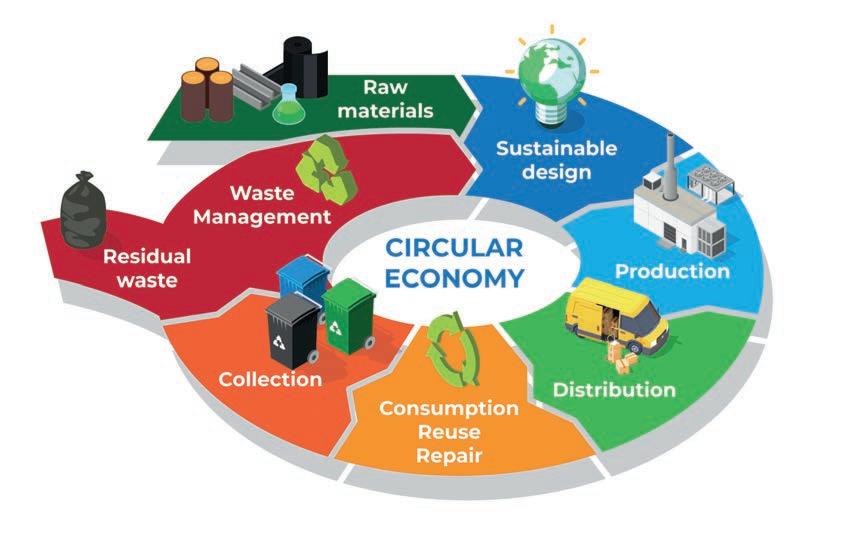

Financial incentives and market-based mechanisms
Financial incentives and market-based mechanisms play a crucial role in supporting the economic viability of SAFs.
• Gover nment subsidies and tax credits : Government policies that provide subsidies, tax credits, and grants for SAF production and adoption are vital for driving investment. The US Renewable Fuel Standard and the European Union’s Renewable Energy Directive are examples of policies that incentivise SAF production through financial support and regulatory mandates.
• Carbon pricing and emissions trading: Implementing carbon pricing mechanisms, such as carbon taxes and emissions trading systems, creates a market for accounting for negative impacts and so a financial incentive for airlines to adopt SAFs. The International Civil Aviation Organization’s CORSIA scheme aims to stabilise aviation emissions at 2020 levels by requiring airlines to offset their emissions growth through the purchase of carbon credits. This market-based approach encourages investment in SAFs and other emissions-reducing technologies.
Regulatory innovations: Creating an enabling environment
Harmonised standards and certification
Establishing harmonised standards and streamlined certification processes is essential for accelerating SAF adoption.
• Inter national standards: The development of international standards for SAF production, sustainability criteria and lifecycle emissions is critical for ensuring consistency and reliability.
The Roundtable on Sustainable Biomaterials and the International Civil Aviation Organization have established guidelines for SAF certification, promoting global harmonisation.
• Streamlined certification processes: Simplifying and expediting the certification process for new SAF technologies can accelerate market entry and scaling.
The ASTM International, which sets standards for aviation fuels, has approved multiple pathways for SAF production, including HEFA, ATJ and Fischer-Tropsch fuels. Streamlined certification processes reduce barriers to entry for new SAF producers and technologies.11
Long-term policy support and collaboration
Long-term policy support and collaboration between governments, industry stakeholders and research institutions are essential for sustaining SAF development and scaling.
• Policy stability: Stable and long-term policy frameworks provide certainty for investors and fuel producers. Governments must commit to sustained support for SAF initiatives, ensuring that policies remain consistent and predictable over time.
The European Green Deal, which aims to make Europe the first climate-neutral continent by 2050, includes ambitious targets for sustainable aviation, providing a clear policy direction for the industry.
• Public-private partnerships: Collaborative efforts between public and private sectors can drive innovation and scaling. Public-private partnerships leverage the strengths of both sectors, combining public funding and policy support with private sector expertise and investment.
The Clean Skies for Tomorrow initiative, launched by the World Economic Forum, brings together stakeholders from the aviation industry, government and academia to accelerate SAF development and adoption.12
/Shipping and Marine Transportation – sailing to a sustainable future

Adoption of LNG and electrification in shipping for reduced emissions
The shipping industry, a vital component of global trade, faces increasing pressure to reduce its environmental footprint. The adoption of Liquefied Natural Gas and electrification in shipping has emerged as pivotal strategies for reducing emissions and promoting sustainability. This chapter delves into the technological advancements, implementation strategies, and real-world examples of how LNG and electrification are transforming the shipping industry.
Liquefied Natural Gas as a marine fuel
Benefits of LNG
LNG offers several advantages over traditional marine fuels, primarily due to its lower carbon content and cleaner combustion process. When used as a marine fuel, LNG can reduce carbon dioxide (CO2) emissions by up to 25%, nitrogen oxides (NOx) by up to 85%, and sulphur oxides (SOx) and particulate matter by nearly 100%. These reductions are significant, given the stringent regulations imposed by the International Maritime Organization (IMO), such as the 2020 global sulphur cap, which limits sulphur content in marine fuels to 0.5%.13

Technological advancements have been crucial in making LNG a viable alternative to traditional marine fuels. Innovations in LNG storage and handling, engine technology and bunkering infrastructure have facilitated its adoption.
• LNG storage and handling: The development of cryogenic tanks capable of storing LNG at extremely low temperatures has enabled its safe and efficient use on ships.
Companies like Wärtsilä and MAN Energy Solutions have pioneered the design and manufacture of these tanks, ensuring they meet the highest safety standards.
• Engine technology: Dual-fuel engines, which can operate on both LNG and conventional marine fuels, provide flexibility and reliability.
These engines, developed by companies such as Rolls-Royce and Caterpillar, allow ships to switch between fuel types based on availability and cost, without compromising performance.
• Bunkering infrastructure: The establishment of LNG bunkering facilities in major ports worldwide has been critical to its adoption.
Ports such as Rotterdam, Singapore and Jacksonville have invested in LNG bunkering infrastructure, making LNG more accessible to shipping companies.
Several shipping companies have successfully integrated LNG into their operations, demonstrating its feasibility and benefits.
CMA CGM: The French shipping giant CMA CGM has been at the forefront of LNG adoption. In 2020, the company launched the world’s largest LNG-powered container ship, the CMA CGM Jacques Saadé. This vessel, with a capacity of 23,000 TEUs, showcases the potential of LNG to significantly reduce emissions in large-scale maritime operations. CMA CGM plans to have a fleet of 26 LNG-powered vessels by 2022, underscoring its commitment to sustainability.14
Stena Line: Stena Line, one of the world’s largest ferry operators, has also embraced LNG. The company’s ferry, Stena Germanica, was retrofitted to run on LNG in 2015. This conversion resulted in a 20% reduction in CO2 emissions and a substantial decrease in NOx and SOx emissions. Stena Line’s experience demonstrates the feasibility of converting existing vessels to LNG, providing a pathway for other operators to follow.15
Advantages
Electrification in shipping, particularly through the use of battery-electric and hybrid propulsion systems, offers another pathway to zero-emission maritime operations. Electric propulsion eliminates emissions of CO2, NOx, SOx and particulate matter, contributing to cleaner air and reduced environmental impact.
Technological innovations in electrification
Technological innovations have driven the development and adoption of electric propulsion systems in the maritime industry.
• Battery technology: Advances in battery technology, including higher energy density and improved safety, have made electric propulsion more viable. Lithium-ion batteries, in particular, are widely used due to their high efficiency and long lifecycle.
Companies like Corvus Energy and Siemens are leading the development of maritime batteries, ensuring they meet the rigorous demands of marine environments.
• Hybrid propulsion systems: Hybrid propulsion systems, which combine battery power with traditional diesel engines or LNG, offer a flexible and efficient solution. These systems allow vessels to operate on battery power in sensitive areas, such as ports and coastal regions and switch to traditional fuels for longer voyages. Hybrid systems are particularly beneficial for ferries and short-sea shipping, where frequent stops and starts are common.
• Charging infrastructure: The development of shore-side charging infrastructure is essential for the widespread adoption of electric vessels. Ports are investing in high-capacity charging stations to support electric and hybrid vessels.
For example, the Port of Long Beach in California has installed shore-side power connections, allowing ships to plug in and reduce emissions while docked.
Case studies of electrification
Several pioneering projects highlight the potential of electrification in shipping.
Ellen E-Ferry: The Ellen E-Ferry, operating in Denmark, is one of the world’s largest fully electric ferries. Powered by a 4.3 MWh battery pack, the ferry can travel up to 22 nautical miles on a single charge, significantly reducing emissions compared to diesel-powered ferries. The Ellen E-Ferry project, supported by the European Union’s Horizon 2020 programme, showcases the viability of large-scale electric propulsion in maritime operations.16
Yara Birkeland: The Yara Birkeland, set to become the world’s first autonomous and fully electric container ship, represents a groundbreaking step in maritime electrification. Developed by Yara International and Kongsberg Maritime, the vessel is designed to reduce CO2 emissions by 678 tons annually by replacing truck transport with electric shipping. The Yara Birkeland’s maiden voyage is anticipated to revolutionise short-sea shipping, demonstrating the potential for zero-emission logistics.17
Economic and environmental impact
Economic benefits
The adoption of LNG and electrification in shipping presents several economic benefits, despite the initial investment costs. Over the long term, these technologies can lead to significant savings in fuel costs and maintenance expenses. For instance, LNG is often cheaper than low-sulphur marine fuel, and electric propulsion systems have fewer moving parts, reducing maintenance needs and costs.
Environmental impact
The environmental benefits of adopting LNG and electrification in shipping are substantial. By reducing emissions of greenhouse gases and pollutants, these technologies contribute to cleaner air and healthier marine ecosystems. According to the International Council on Clean Transportation, widespread adoption of LNG and electrification could reduce the shipping industry’s CO2 emissions by up to 15% by 2030, significantly contributing to global climate goals.
Regulatory support and policy initiatives
International Maritime Organization (IMO) regulations
The IMO has implemented several regulations to encourage the adoption of cleaner technologies in shipping. The 2020 global sulphur cap, which limits sulphur content in marine fuels to 0.5%, has been a significant driver for LNG adoption. Additionally, the IMO’s initial strategy on the reduction of GHG emissions aims to reduce total annual GHG emissions from international shipping by at least 50% by 2050 compared to 2008 levels.
National and regional initiatives
National and regional governments are also playing a crucial role in promoting LNG and electrification in shipping. The European Union’s Green Deal includes targets for reducing maritime emissions and supports initiatives such as the development of LNG bunkering infrastructure and electric propulsion systems. Similarly, the United States’ Clean Ports Programme provides funding for the electrification of port operations and the adoption of LNG.
The Port of Singapore, one of the busiest and most strategically important ports in the world, has emerged as a leader in green maritime practices. The port’s comprehensive approach to sustainability encompasses a range of innovative initiatives designed to reduce emissions, enhance energy efficiency, and protect marine biodiversity. This part of the report delves into the Port of Singapore’s green initiatives, highlighting key projects, technological advancements and the port’s commitment to environmental stewardship.
The Port of Singapore, managed by the Maritime and Port Authority of Singapore, handles over 37.5 million Twenty-foot Equivalent Units annually, making it one of the largest container ports globally. Despite its immense scale, the port has made sustainability a core priority, driven by the recognition that environmental stewardship is essential for long-term operational viability and global competitiveness.
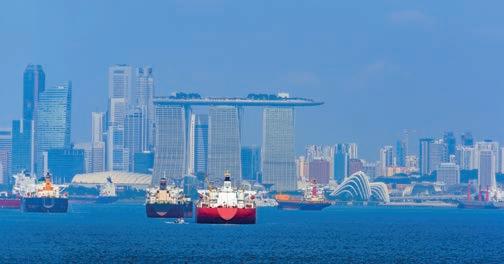
Launched in 2011, the Green Port Programme (GPP) is a cornerstone of Singapore’s maritime sustainability strategy. The GPP incentivises shipping companies to adopt environmentally friendly practices by offering fee reductions for vessels that exceed regulatory requirements for emissions and fuel efficiency.
• Emission reductions: Under the GPP, vessels that use approved scrubbers or alternative fuels such as LNG to reduce sulphur emissions can receive up to a 25% reduction in port dues. This initiative aligns with the IMO’s 2020 global sulphur cap, which mandates a significant reduction in sulphur content in marine fuels.18
• Energy efficiency: The programme also rewards ships that meet or surpass the IMO’s Energy Efficiency Design Index standards. These standards aim to improve the energy efficiency of new ships through design innovations. Ships that achieve high energy efficiency scores benefit from lower port fees, incentivizing the adoption of greener technologies.
The Port of Singapore has invested heavily in developing LNG bunkering infrastructure, positioning itself as a leading LNG bunkering hub in Asia. LNG, a cleaner alternative to traditional marine fuels, significantly reduces emissions of sulphur oxides, nitrogen oxides and particulate matter.
• LNG bunkering facilities: Singapore’s LNG bunkering infrastructure includes state-of-the-art facilities capable of supplying LNG to a wide range of vessels. The SLNG Terminal on Jurong Island, operational since 2013, serves as a critical node for LNG imports and storage, supporting the port’s bunkering operations.
• Bunkering standards: To ensure the safety and efficiency of LNG bunkering, the MPA has developed comprehensive standards and guidelines in collaboration with industry stakeholders. These standards cover various aspects of LNG bunkering, including safety protocols, technical specifications, and operational procedures. The MPA’s efforts have positioned Singapore as a model for safe and reliable LNG bunkering.
The Port of Singapore has implemented numerous measures to enhance the energy efficiency of its operations, reducing the port’s overall carbon footprint.
• Automated guided vehicles (AGVs): The port has deployed a fleet of AGVs to transport containers within the terminal. These electric vehicles, powered by lithium-ion batteries, are more energy-efficient and produce zero tailpipe emissions compared to conventional diesel-powered vehicles. The AGVs are equipped with advanced navigation systems, allowing for precise and efficient container handling. The evolution of AI and new technologies could see such systems make another significant shift in efficiency and sustainability going forward.
• Green berths: The port has invested in the development of «green berths,» which are equipped with shore power facilities. Shore power allows vessels to plug into the local electrical grid while docked, reducing the need for auxiliary engines and cutting emissions. This initiative aligns with Singapore’s broader efforts to reduce emissions from ships at berth and improve air quality in the port area.
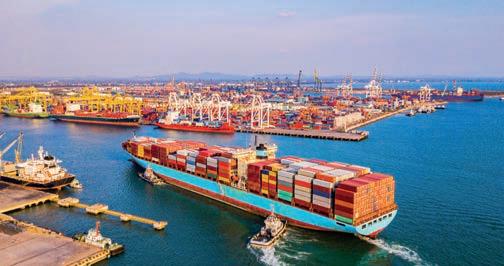
• Energy management systems: The port has implemented sophisticated energy management systems to monitor and optimise energy consumption across its facilities. These systems use real-time data analytics to identify energy-saving opportunities, streamline operations, and reduce wastage.
Marine biodiversity conservation
Recognising the importance of preserving marine biodiversity, the Port of Singapore has undertaken several initiatives to protect and enhance the marine ecosystem in its vicinity.
• Coral relocation and restoration: In collaboration with the National Parks Board and academic institutions, the MPA has conducted coral relocation and restoration projects. These projects involve relocating corals from areas impacted by port development to designated marine parks, where they can thrive and contribute to biodiversity.
• Marine habitat enhancement: The port has also implemented measures to enhance marine habitats, such as installing artificial reefs and creating seagrass meadows. These habitats provide shelter and feeding grounds for marine life, supporting biodiversity and ecological resilience.
The Port of Singapore actively invests in R&D to drive innovation and sustainability in maritime operations.
• Joint R&D projects: The MPA collaborates with research institutions, universities, and industry partners on various R&D projects focused on green technologies and sustainable practices. These projects explore cutting-edge solutions such as autonomous shipping, renewable energy integration and advanced emission control technologies.
• Maritime GreenFuture Fund: To support the development and adoption of green technologies, the MPA established the Maritime GreenFuture Fund. This fund provides financial support for innovative projects that enhance environmental sustainability in the maritime sector. The fund has supported numerous initiatives, including the development of hybrid propulsion systems and energy-efficient port equipment.
Public awareness and stakeholder engagement
The Port of Singapore recognises the importance of raising public awareness and engaging stakeholders in its sustainability efforts.
• Green Awareness Programme: The port’s Green Awareness Programme educates port workers, shipping companies, and the broader community about the importance of environmental sustainability. The programme includes workshops, seminars, and outreach activities that promote best practices and highlight the port’s green initiatives.
• Stakeholder collaboration: The MPA actively engages with stakeholders through forums, working groups and partnerships. By fostering collaboration and dialogue, the port ensures that its sustainability efforts are aligned with industry needs and community expectations.
The Port of Singapore’s green initiatives exemplify its commitment to environmental stewardship and sustainable maritime operations. Through the Green Port Programme, investment in LNG bunkering infrastructure, energy-efficient port operations, marine biodiversity conservation and R&D for sustainability, the port has set a high standard for green practices in the maritime industry. These efforts not only reduce emissions and enhance energy efficiency but also demonstrate the port’s leadership in driving the global transition towards sustainable shipping. As a model for other ports worldwide, the Port of Singapore’s initiatives highlight the critical role of innovation, collaboration and strategic investment in achieving a sustainable future for the maritime sector.
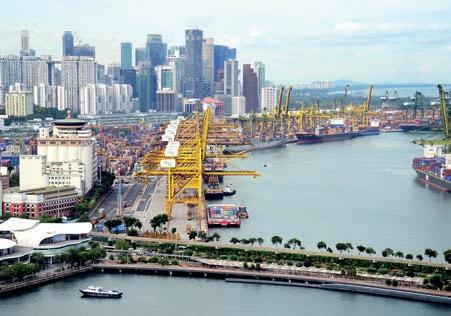
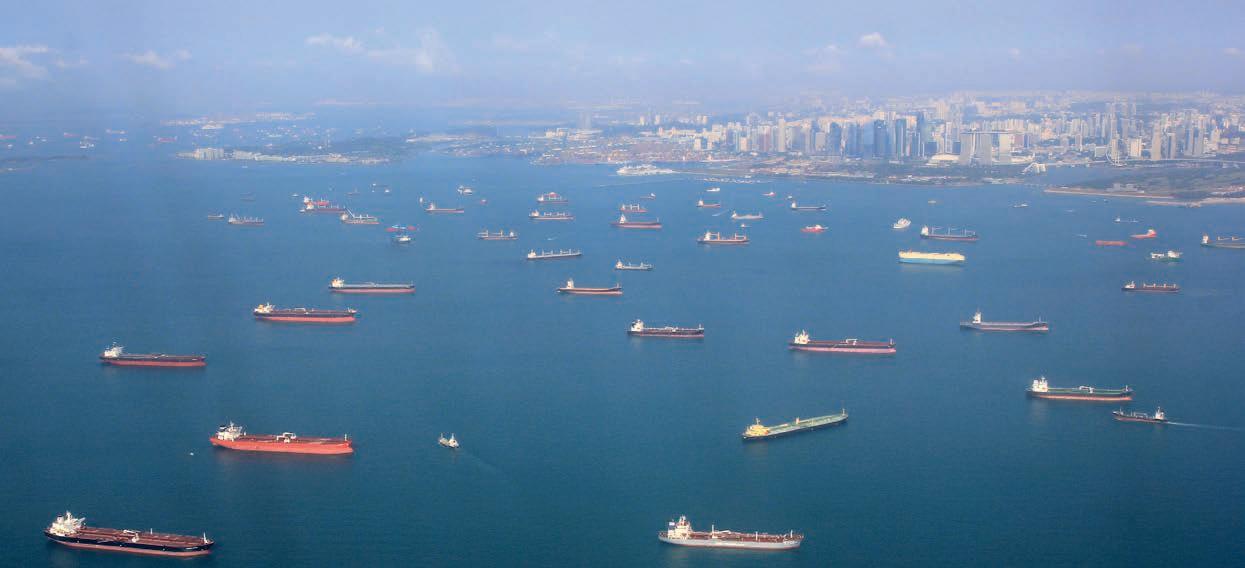
The shipping industry is undergoing a transformative shift towards energy efficiency, driven by the need to remain competitive and reduce cost as well as the growing importance and imperative to reduce greenhouse gas emissions and comply with stringent environmental regulations.
Design innovations and operational strategies are at the forefront of this movement, enabling ships to consume less fuel, emit fewer pollutants and operate more sustainably. This chapter explores the cutting-edge design innovations and operational strategies that are revolutionising the maritime sector, supported by real-world examples and statistical insights.
Hull design and hydrodynamics
The design of a ship’s hull plays a crucial role in determining its energy efficiency. Advances in hull design and hydrodynamics have led to the development of more streamlined and hydrodynamically efficient vessels.
• Optimized hull shapes: Modern hull designs focus on reducing water resistance and improving flow dynamics. The use of bulbous bows, for instance, has become prevalent in reducing wave resistance. A bulbous bow modifies the way water flows around the hull, reducing drag and improving fuel efficiency by up to 15%.
• Air lubrication systems: Air lubrication systems involve injecting a layer of air bubbles along the hull’s surface to reduce friction between the hull and water. This technology can decrease fuel consumption by 8-10%. The M/V Tharsis, a Dutch cargo ship, utilises an air lubrication system that has demonstrated significant energy savings during its operations.
• Hull coatings: Advanced hull coatings, such as silicone-based and nano-coatings, reduce biofouling, which occurs when marine organisms attach to the hull. Biofouling increases drag and fuel consumption. These coatings create a smooth, slippery surface that minimises biofouling, leading to improved fuel efficiency. According to the IMO, such coatings can result in fuel savings of up to 5%.19
Innovations in propulsion systems have significantly contributed to the energy efficiency of ships.
• Hybrid propulsion: Hybrid propulsion systems combine traditional internal combustion engines with electric propulsion. These systems optimise fuel consumption by allowing ships to switch between diesel and electric power based on operational needs.
The MS Roald Amundsen, a hybrid-powered expedition cruise ship operated by Hurtigruten, uses battery packs to supplement its diesel engines, reducing emissions and fuel consumption.

• Wind-assisted propulsion: Wind-assisted propulsion technologies, such as rotor sails and kites, harness wind power to supplement a ship’s main engines. Rotor sails, also known as Flettner rotors, are large spinning cylinders installed on a ship’s deck that create lift and reduce fuel consumption.
The MV Afros, a bulk carrier equipped with four rotor sails, has achieved fuel savings of up to 12%.
• Fuel cells: Fuel cells generate electricity through a chemical reaction between hydrogen and oxygen, producing only water and heat as byproducts. Fuel cells offer a clean and efficient alternative to traditional diesel engines.
The Viking Lady, an offshore supply vessel, was one of the first commercial ships to be equipped with a fuel cell system, demonstrating the feasibility of this technology in maritime applications.20
The use of lightweight materials in ship construction can significantly reduce a vessel’s weight, leading to improved fuel efficiency.
• Composite materials: Composite materials, such as carbon fibre and fibreglass, are increasingly being used in shipbuilding due to their high strength-to-weight ratio. These materials are particularly advantageous for high-speed vessels and ferries, where weight reduction is critical.
The MSC Seaside, a cruise ship built with composite materials in its superstructure, benefits from reduced weight and improved stability, contributing to lower fuel consumption.
• Aluminium alloys: Aluminium alloys offer a lightweight alternative to traditional steel hulls. Although aluminium is more expensive, its use can result in significant weight savings and enhanced fuel efficiency.
The Incat Tasmania-built high-speed ferry Francisco, which operates between Argentina and Uruguay, uses an aluminium hull to achieve higher speeds and lower fuel consumption.
Slow steaming
Slow steaming involves operating ships at lower speeds to reduce fuel consumption and emissions. This strategy has gained widespread acceptance in the shipping industry due to its significant environmental and economic benefits.
• Fuel savings: By reducing a ship’s speed, fuel consumption can be reduced by up to 30%. For example, Maersk Line, one of the world’s largest container shipping companies, has implemented slow steaming across its fleet, achieving substantial fuel savings and emissions reductions.
• Emissions reduction: Slow steaming not only saves fuel but also reduces emissions of CO2, NOx, and SOx. According to a study by the IMO, a 10% reduction in speed can lead to a 19% reduction in CO2 emissions.21
Route optimisation involves using advanced software and real-time data to determine the most efficient routes for ships, minimising fuel consumption and transit times.
• Weather routing: Weather routing systems analyse weather conditions, ocean currents, and sea state to identify the safest and most fuel-efficient routes. These systems help ships avoid adverse weather, reduce fuel consumption and enhance safety.
For instance, the European Space Agency’s project «Bluebelt» uses satellite data to provide real-time routing information to ships, optimizing their routes and reducing fuel use.
• Just-in-time arrival: Just-in-time arrival strategies involve coordinating a ship’s arrival time with port availability to minimise idle time at anchor. By adjusting speed to ensure timely arrival, ships can reduce fuel consumption and emissions.
The Port of Rotterdam has implemented a just-in-time arrival programme, resulting in significant fuel savings and reduced emissions for participating vessels.
Energy management systems (EMS) enable ships to monitor and optimise their energy use, improving overall efficiency.
• Real-time monitoring: EMS systems collect real-time data on a ship’s energy consumption, engine performance, and operational parameters. This data is analysed to identify inefficiencies and recommend corrective actions.
The MSC Cruises fleet uses an advanced EMS to monitor and optimise energy use, resulting in significant energy savings.
• Automated control systems: Automated control systems adjust engine settings, propulsion systems and auxiliary equipment to optimise energy use. These systems ensure that a ship operates at peak efficiency under varying conditions.
The Norwegian ferry operator Fjord1 uses automated control systems to enhance the energy efficiency of its electric and hybrid ferries.22

The adoption of energy-efficient ship designs and operational strategies has already demonstrated significant benefits in reducing fuel consumption and emissions.
• CO2 emissions reduction: According to the IMO, the global shipping industry emitted approximately 940 million tonnes of CO2 in 2018, accounting for about 2.5% of global greenhouse gas emissions. By adopting energy-efficient designs and operational strategies, the industry could reduce its CO2 emissions by up to 50% by 2050.
• Economic savings: The financial benefits of improved energy efficiency are substantial. A study by the International Council on Clean Transportation estimates that adopting energy-efficient technologies and practices could save the shipping industry up to $70bn in annual fuel costs by 2050.
Maersk Line’s commitment to energy efficiency has led to remarkable results. Between 2007 and 2020, the company reduced its CO2 emissions per container shipped by more than 40%, primarily through slow steaming, hull modifications and operational improvements.
Design innovations and operational strategies are transforming the shipping industry, driving significant improvements in energy efficiency and environmental performance. By embracing advanced hull designs, hybrid propulsion systems, lightweight materials and optimised operational practices, the maritime sector can achieve substantial reductions in fuel consumption and emissions. FIDIC’s commitment to promoting energy efficiency through advocacy, knowledge sharing, and collaboration is essential in this journey. As the shipping industry navigates the challenges and opportunities of the 21st century, these innovations and strategies will play a critical role in shaping a sustainable and resilient future.
Role of digitalisation in enhancing operational sustainability
In the quest for sustainability, the maritime industry is increasingly turning to digitalisation as a transformative tool. Digital technologies offer unprecedented opportunities to enhance operational efficiency, reduce environmental impact, and foster innovation.
This section explores the role of digitalisation in maritime operations, highlighting key technologies, their applications and the tangible benefits they bring to the sector. By delving into real-world examples and providing statistical insights, we underscore how digitalisation is revolutionising the shipping industry and driving it towards a more sustainable future.
Digitalisation refers to the integration of digital technologies into all aspects of business and operational processes. In the maritime sector this encompasses a wide range of technologies, including the Internet of Things (IoT), big data analytics, artificial intelligence (AI), blockchain and advanced software solutions. These technologies collectively enable ships and ports to operate more efficiently, reduce emissions and improve overall sustainability.
The IoT involves connecting physical devices to the internet, allowing them to collect and exchange data. In maritime operations, IoT enables real-time monitoring and management of various ship and port functions.
• Smart ships: IoT sensors installed on ships collect data on engine performance, fuel consumption, weather conditions and cargo status. This data is transmitted in real-time to shore-based control centres, where it is analysed to optimise operations.
For example, the Japanese shipping company NYK Line has developed a digital twin of its vessels, using IoT data to create a virtual replica that simulates and optimises ship performance. This technology has helped NYK Line reduce fuel consumption by 2-4% and cut CO2 emissions accordingly.23
• Smart ports: IoT technology is also transforming port operations. Smart ports use IoT devices to monitor and manage cargo handling, berth allocation and equipment maintenance.
The Port of Rotterdam, one of the world’s busiest ports, has implemented IoT-enabled systems to streamline operations and reduce energy consumption. By using IoT data to optimise crane operations and terminal logistics, the port has achieved a 10% reduction in energy use and a corresponding decrease in emissions.
Big data analytics involves processing and analysing large volumes of data to uncover patterns, trends and insights. In the maritime industry, big data analytics is crucial for optimising operations and enhancing sustainability.
• Predictive maintenance: Big data analytics enables predictive maintenance by analysing data from shipboard sensors to identify potential equipment failures before they occur. This proactive approach reduces downtime, lowers maintenance costs and extends the lifespan of equipment.
Maersk, a global leader in container shipping, has implemented predictive maintenance solutions across its fleet. By analysing data from over 200 sensors on each vessel, Maersk has reduced maintenance costs by 10-15% and improved operational reliability.24
• Voyage optimisation: Big data analytics is also used to optimise voyage planning and routing. By analysing historical and real-time data on weather conditions, ocean currents, and vessel performance, shipping companies can determine the most fuel-efficient routes.
The Finnish company Wärtsilä offers a voyage optimisation platform that has been shown to reduce fuel consumption by up to 10%, significantly cutting emissions.
Artificial intelligence (AI)
AI technologies, including machine learning and neural networks, are revolutionising maritime operations by enabling more intelligent decision-making and automation.
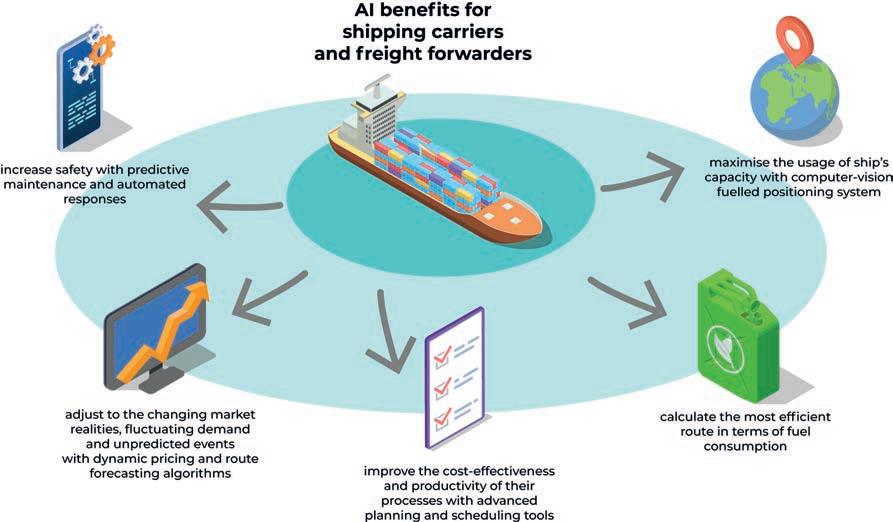
• Autonomous shipping: AI is at the heart of autonomous shipping initiatives, which aim to reduce human error, improve safety and enhance efficiency.
The Yara Birkeland, developed by Yara International and Kongsberg Maritime, is set to become the world’s first fully autonomous and zero-emission container ship. The vessel uses AI to navigate, monitor surroundings, and make operational decisions, reducing the need for crew and cutting emissions by eliminating inefficiencies.
• AI-driven optimisation: AI algorithms are also used to optimise fuel consumption and emissions.
For example, the AI-based system developed by Nautilus Labs uses machine learning to predict fuel usage and recommend optimal operating conditions for ships. This system has helped shipping companies achieve fuel savings of 5-10%, contributing to lower emissions and greater sustainability.25
Blockchain technology, known for its secure and transparent nature, is being leveraged to enhance sustainability in the maritime industry by improving traceability, reducing fraud and streamlining processes.
• Supply chain transparency: Blockchain provides an immutable record of transactions and movements within the supply chain, enhancing transparency and accountability.
The IBM-Maersk platform, TradeLens, uses blockchain to track cargo movements and documentations, reducing paperwork and administrative errors. By providing a single source of truth, TradeLens enhances efficiency and reduces the environmental impact associated with traditional documentation processes.
• Emission tracking: Blockchain is also being used to track and verify emissions data. By recording emission data on a blockchain, shipping companies can ensure accurate reporting and compliance with environmental regulations.
The Energy Web Foundation, in collaboration with blockchain technology firm R3, has developed a blockchain-based system to track and trade renewable energy credits, promoting cleaner energy use in maritime operations.

The adoption of digital technologies in the maritime industry has already demonstrated significant benefits in terms of operational efficiency and sustainability.
• Fuel efficiency: According to a report by the IMO, the implementation of digital technologies such as IoT, big data analytics and AI can lead to a 20-30% improvement in fuel efficiency. This reduction in fuel consumption translates to substantial cost savings and a significant decrease in greenhouse gas emissions.
• Operational efficiency: Digitalisation enhances operational efficiency by streamlining processes, reducing downtime, and improving asset utilisation. The Port of Hamburg’s smart port initiative, which integrates IoT and big data analytics, has resulted in a 25% increase in terminal productivity and a 15% reduction in truck turnaround times.
• Emissions reduction: The use of digital technologies contributes to lower emissions by optimising fuel use, improving maintenance practices and enabling cleaner operations. The European Maritime Safety Agency estimates that digitalisation could help the maritime industry reduce CO2 emissions by up to 40% by 2050, aligning with global climate goals.26
As can be seen from the above, digitalisation is transforming the maritime industry, driving significant improvements in operational efficiency and sustainability. Engineers will be vital in ensuring the wider use and implementation of such technologies in engineering solutions, as the maritime industry navigates the challenges and opportunities of the digital age. Such innovations will play a critical role in shaping a sustainable and resilient future for global shipping.
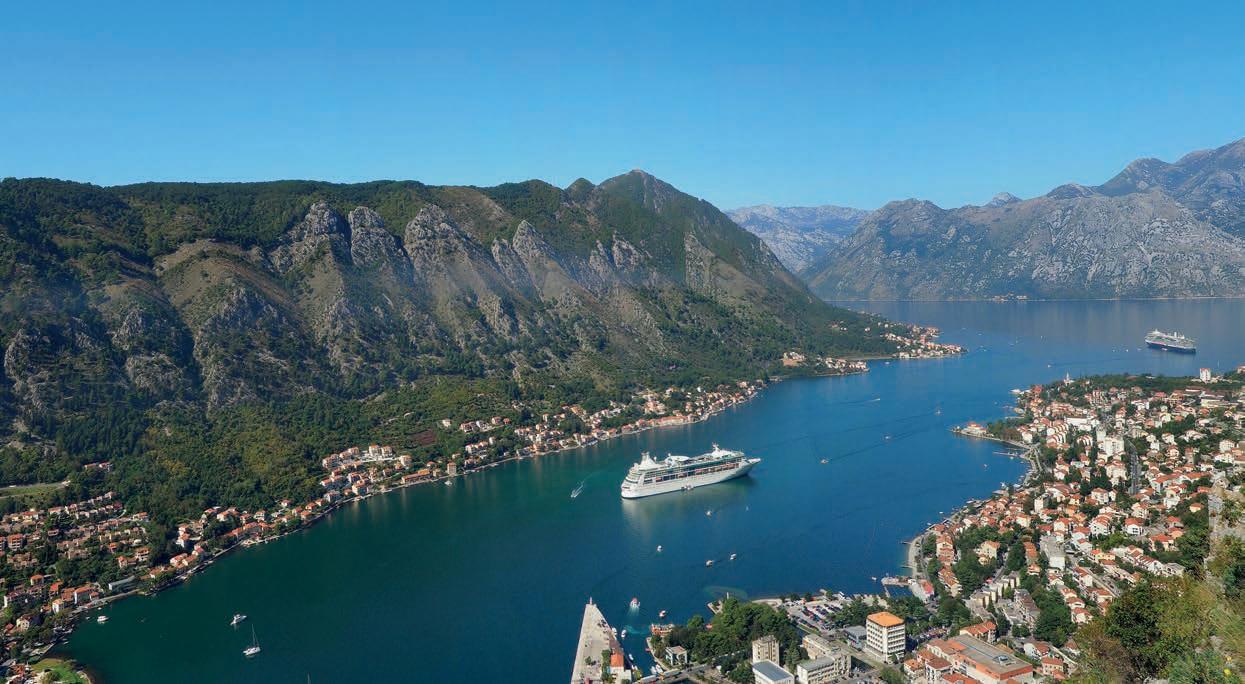
/Ports and marine infrastructure – An eco-friendly way forward
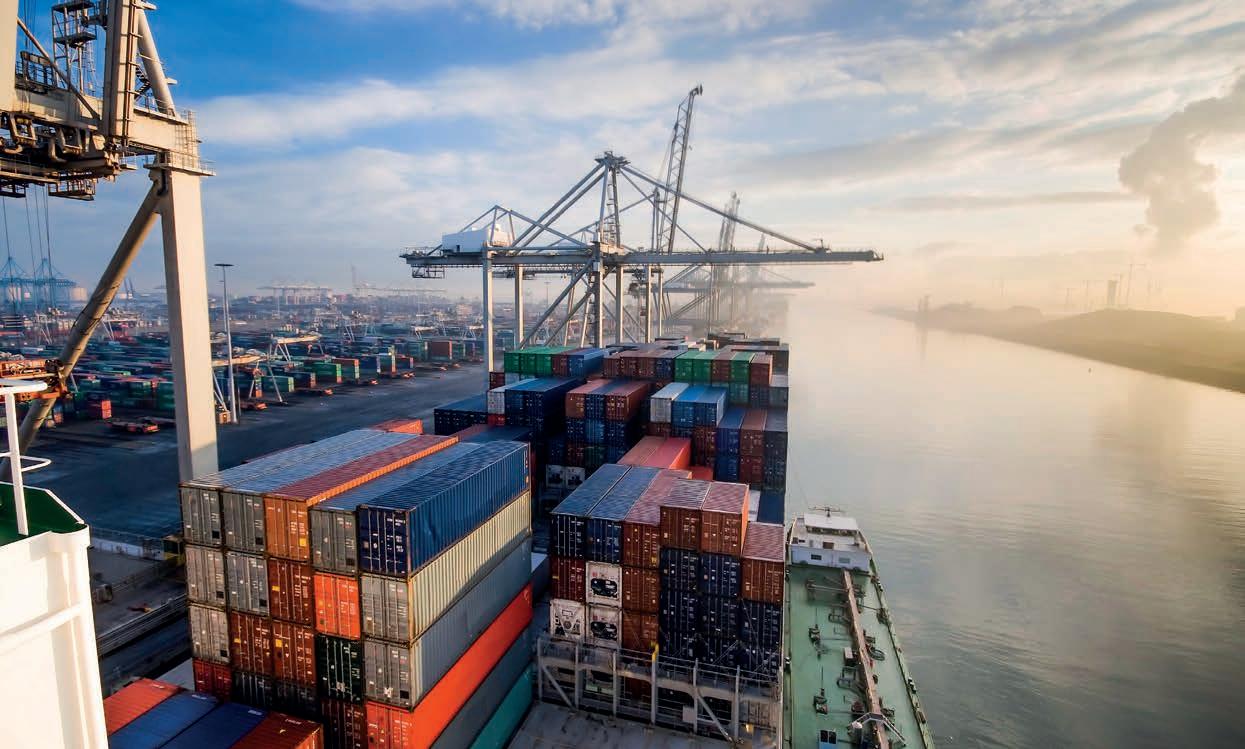
Sustainable development practices in global ports: Sri Lanka’s Colombo Port’s green initiatives
As global trade continues to expand, ports around the world are faced with the challenge of balancing growth with environmental stewardship. Sustainable development practices have become integral to the operations of many leading ports, with a focus on reducing emissions, conserving resources and protecting marine ecosystems. Sri Lanka’s Colombo Port is a notable example of a port that has embraced green initiatives to drive sustainability. This section explores the sustainable development practices implemented at Colombo Port, highlighting the key initiatives, their impact and the broader implications for global port operations.
The importance of sustainable development in ports
Ports are critical nodes in the global supply chain, facilitating the movement of goods and contributing significantly to economic growth. Port activities, however, also have substantial environmental impacts, including air and water pollution, habitat destruction and greenhouse gas emissions. Sustainable development practices in ports aim to mitigate these impacts by integrating environmental, economic, and social considerations into port planning and operations. By adopting sustainable practices, ports can enhance their operational efficiency, comply with environmental regulations and contribute to broader sustainability goals.
Colombo Port, located on the southwestern shores of Sri Lanka, is one of the busiest ports in South Asia. Managed by the Sri Lanka Ports Authority (SLPA), Colombo Port has implemented a range of green initiatives aimed at reducing its environmental footprint and promoting sustainable development.
Energy efficiency and renewable energy integration
One of the primary focuses of Colombo Port’s sustainability strategy is improving energy efficiency and integrating renewable energy sources.
• Energy-efficient infrastructure: Colombo Port has invested in energy-efficient infrastructure, including the installation of LED lighting systems across the port premises. These systems consume significantly less energy compared to conventional lighting, reducing the port’s overall energy consumption and carbon footprint. According to the SLPA, the transition to LED lighting has resulted in a 40% reduction in energy use for lighting.
• Solar power projects: In a bid to harness renewable energy, Colombo Port has launched several solar power projects. Solar panels have been installed on the rooftops of port buildings, generating clean energy to power port operations. The port’s solar power initiative is part of a broader national effort to increase the share of renewable energy in Sri Lanka’s energy mix. As of 2021, Colombo Port’s solar installations have a capacity of over 1 MW, contributing to the port’s energy needs and reducing reliance on fossil fuels.
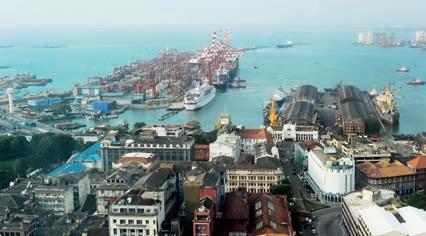
Reducing emissions from port operations is a key component of Colombo Port’s sustainability agenda. The port has implemented various measures to cut emissions from both stationary and mobile sources.
• Shore power systems: To reduce emissions from ships docked at the port, Colombo Port has introduced shore power systems, also known as cold ironing. These systems allow vessels to plug into the local electrical grid and shut down their auxiliary engines while at berth. By using shore power, ships can significantly reduce emissions of CO2, NOx, and SOx.
The SLPA reports that shore power systems have the potential to reduce emissions from docked ships by up to 90%.

• Greenhouse gas monitoring: Colombo Port has established a comprehensive greenhouse gas (GHG) monitoring system to track and manage emissions. The system collects data on fuel consumption, equipment usage, and other activities that contribute to GHG emissions. This data is used to identify emission hotspots and develop targeted strategies for emission reduction. The port’s GHG monitoring efforts align with international frameworks such as the IMO’s GHG strategy, which aims to reduce emissions from shipping by at least 50% by 2050 compared to 2008 levels.
Effective waste management and pollution control are essential for maintaining the environmental health of port areas and surrounding marine ecosystems.
• Waste reduction programmes: Colombo Port has implemented programmes to reduce waste generation and promote recycling. Waste segregation systems have been installed throughout the port, enabling the separation of recyclable and non-recyclable materials. The port also collaborates with local recycling facilities to ensure that recyclable waste is processed and reused. These efforts have significantly reduced the amount of waste sent to landfills, contributing to a cleaner port environment.
• Pollution control measures: To prevent water pollution, Colombo Port has established strict regulations for the handling and disposal of hazardous materials. The port has invested in modern pollution control equipment, including oil spill response kits and containment booms, to address potential spills and leaks. Additionally, regular water quality monitoring is conducted to detect and mitigate any pollution incidents. These measures ensure that port operations do not compromise the health of marine ecosystems.
Colombo Port recognises the importance of preserving biodiversity and protecting critical habitats within and around port areas.
• Mangrove restoration projects: Mangroves play a vital role in coastal ecosystems, providing habitat for marine life, protecting shorelines from erosion, and sequestering carbon. Colombo Port has initiated mangrove restoration projects to rehabilitate degraded mangrove areas near the port. These projects involve planting mangrove saplings, monitoring growth and protecting restored areas from human disturbances. The SLPA has partnered with

local environmental organisations to implement these projects, ensuring community involvement and long-term sustainability.
• Marine protected areas: To safeguard marine biodiversity, Colombo Port has designated certain areas as marine protected zones. These zones restrict activities that could harm marine life, such as dredging and construction. The port also conducts regular biodiversity assessments to monitor the health of marine species and habitats. By establishing marine protected areas, Colombo Port contributes to the conservation of marine biodiversity and enhances the resilience of coastal ecosystems.
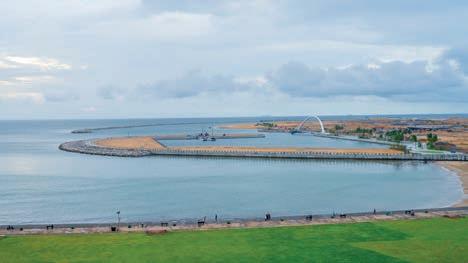
Engaging with local communities and raising awareness about sustainability are integral to Colombo Port’s green initiatives.
• Community outreach programmes: Colombo Port conducts community outreach programmes to educate local residents about the importance of environmental conservation and sustainable practices. These programmes include workshops, seminars and interactive sessions that cover topics such as waste management, energy conservation and biodiversity protection. By fostering a culture of sustainability, the port aims to inspire community members to adopt eco-friendly practices in their daily lives.
• Environmental education for schools: The port collaborates with local schools to incorporate environmental education into the curriculum. Educational materials, field trips and hands-on activities are provided to students to enhance their understanding of environmental issues and the role of ports in sustainability. These initiatives help to nurture the next generation of environmental stewards and build a foundation for long-term sustainability.
The global context: Lessons from Colombo Port
Colombo Port’s sustainable development practices offer valuable lessons for ports around the world. By integrating energy efficiency, emissions reduction, waste management, biodiversity conservation and community engagement into their operations, ports can achieve significant environmental benefits while maintaining economic competitiveness.
The green initiatives implemented at Colombo Port demonstrate that sustainable practices can be both replicable and scalable. Ports of varying sizes and capacities can adopt similar measures, tailoring them to their specific contexts and challenges. For example, the success of Colombo Port’s shore power systems and solar power projects highlights the potential for other ports to invest in renewable energy and emissions reduction technologies.
Colombo Port’s approach underscores the importance of collaboration and partnerships in achieving sustainability goals. By working with local communities, environmental organisations, academic institutions and industry stakeholders, ports can leverage diverse expertise and resources to drive sustainable development. These collaborations foster innovation, enhance knowledge sharing and build a collective commitment to environmental stewardship.
Sustainability is an ongoing journey that requires continuous improvement and innovation. Colombo Port’s commitment to monitoring and assessing its environmental impact, investing in new technologies and engaging with stakeholders exemplifies the dynamic nature of sustainable development. Ports must remain adaptable, embracing new opportunities and addressing emerging challenges to sustain their progress towards sustainability.27
Sri Lanka’s Colombo Port serves as a compelling example of how ports can integrate sustainable development practices into their operations. Through energy efficiency measures, emissions reduction initiatives, waste management programmes, biodiversity conservation efforts and community engagement, Colombo Port has demonstrated that environmental sustainability and economic growth can go hand in hand. As ports around the world seek to enhance their sustainability, the green initiatives at Colombo Port provide a roadmap for achieving a balance between operational efficiency and environmental stewardship. By learning from Colombo Port’s experience, the global maritime community can advance towards a more sustainable and resilient future.
As global ports strive to enhance their sustainability, the integration of renewable energy and effective waste management solutions has become paramount. These initiatives not only reduce the environmental footprint of port operations but also promote economic efficiency and resilience. This section explores how ports worldwide are integrating renewable energy and waste management solutions to create more sustainable and eco-friendly operations.
The transition to renewable energy sources is a critical component of sustainable port development. Ports are significant consumers of energy, primarily for powering cargo handling equipment, lighting and other operational activities. By integrating renewable energy sources such as solar, wind and tidal power, ports can significantly reduce their carbon emissions and operational costs.
Solar power integration
Solar power is one of the most accessible and scalable renewable energy sources for ports. The vast expanse of port facilities provides ample space for the installation of solar panels, which can generate substantial amounts of clean energy.28
Colombo Port’s solar initiative: Colombo Port has embraced solar energy by installing photovoltaic panels on the rooftops of port buildings and warehouses. This initiative, part of the port’s broader sustainability strategy, generates over 1 MW of electricity, reducing reliance on fossil fuels and cutting greenhouse gas emissions. The solar power generated is used to power lighting systems, administrative offices and some cargo handling equipment, showcasing a practical application of renewable energy in port operations.
Port of Los Angeles: The Port of Los Angeles has implemented one of the largest solar power projects at any port in the United States. With over 10 MW of installed solar capacity, the port’s solar panels generate enough electricity to power thousands of homes annually. This project is a key component of the port’s Clean Air Action Plan, aimed at reducing emissions and improving air quality in the region.
Wind energy offers another viable renewable energy source for ports, especially those located in coastal areas with strong and consistent wind patterns.
Port of Rotterdam: The Port of Rotterdam, Europe’s largest port, has invested heavily in wind energy. The port’s Maasvlakte 2 extension features several large wind turbines that generate clean electricity for port operations and the surrounding industrial areas. These wind turbines contribute to the port’s goal of becoming carbon neutral by 2050. The integration of wind energy not only reduces emissions but also enhances the port’s energy security and resilience.
Aberdeen harbour: In the United Kingdom, Aberdeen harbour has developed a wind farm project to power its operations. The wind farm consists of multiple turbines with a total capacity of 7 MW, providing a significant portion of the port’s electricity needs. This project underscores the potential of wind energy to support sustainable port operations, particularly in regions with favourable wind conditions.29
Tidal and wave energy, though less commonly used than solar and wind, offer immense potential for ports located in areas with strong tidal currents and wave action.
Port of Incheon: The Port of Incheon in South Korea has explored the use of tidal energy to power its operations. The port is situated in an area with one of the highest tidal ranges in the world, making it an ideal location for tidal energy projects. The Incheon Tidal Power Project, when fully operational, is expected to generate up to 1.32 GW of electricity, significantly reducing the port’s carbon footprint.
Wave energy in Hawaii: The Port of Honolulu in Hawaii is testing wave energy converters to harness the power of ocean waves. These devices, installed offshore, convert wave motion into electricity, providing a renewable energy source that complements solar and wind power. The project aims to demonstrate the feasibility of wave energy for port operations and contribute to Hawaii’s ambitious renewable energy goals.
Effective waste management is crucial for maintaining the environmental health of port areas and surrounding communities. Ports generate various types of waste, including solid waste, hazardous materials and wastewater. Implementing advanced waste management solutions can minimise environmental impact, enhance resource efficiency, and promote a circular economy.
Proper waste segregation and recycling are fundamental to effective waste management. By separating recyclable materials from general waste, ports can reduce landfill use and promote the reuse of valuable resources.
Colombo Port’s waste management programme: Colombo Port has implemented a comprehensive waste management programme that includes waste segregation, recycling and proper disposal of hazardous materials. The port collaborates with local recycling facilities to ensure that recyclable waste is processed and reused. This programme has significantly reduced the volume of waste sent to landfills and has promoted a cleaner port environment.
Port of Vancouver: The Port of Vancouver in Canada has established a Zero Waste Challenge, encouraging port tenants and operators to adopt waste reduction and recycling practices. The port provides resources and support for waste audits, recycling programs, and composting initiatives. The Zero Waste Challenge aims to divert 90% of waste from landfills by 2030, contributing to the port’s overall sustainability goals.
Waste-to-energy technologies
Waste-to-energy (WTE) technologies convert waste materials into usable energy, such as electricity or heat. These technologies offer a dual benefit by reducing waste volumes and generating renewable energy.30
Port of Antwerp: The Port of Antwerp in Belgium has invested in a waste-to-energy plant that processes industrial and municipal waste. The plant converts waste into electricity and steam, which are used to power port operations and nearby industrial facilities. This project reduces landfill use, lowers greenhouse gas emissions and provides a sustainable energy source for the port.
Singapore’s Tuas Nexus: Singapore is developing the Tuas Nexus, an integrated waste management facility that combines waste-to-energy, water reclamation and sludge treatment. The facility will convert municipal solid waste into electricity, recover valuable resources from wastewater and treat sludge for safe disposal. The Tuas Nexus exemplifies a holistic approach to waste management, addressing multiple environmental challenges in a single facility.
Marine litter poses a significant threat to marine ecosystems and human health. Ports play a critical role in preventing and managing marine litter through targeted initiatives and partnerships.
Colombo Port’s marine litter initiative: Colombo Port has launched a marine litter prevention and cleanup initiative to address the issue of plastic pollution in surrounding waters. The port conducts regular cleanups, deploys litter traps and raises awareness among port users about the importance of proper waste disposal. This initiative aligns with global efforts to reduce marine litter and protect ocean health.
Port of Los Angeles: The Port of Los Angeles has partnered with local environmental organisations to implement the Clean Marina Programme, which focuses on preventing marine litter and promoting sustainable practices among marina operators and boaters. The programme includes regular inspections, educational workshops and the installation of litter capture devices. These efforts have significantly reduced marine litter in the port area and improved water quality.

The integration of renewable energy and waste management solutions in ports has far-reaching environmental and economic benefits. By reducing emissions, conserving resources and enhancing operational efficiency, these initiatives contribute to global sustainability goals and set a benchmark for other ports to follow.
Environmental benefits
• Emission reductions: The adoption of renewable energy sources such as solar, wind and tidal power significantly reduces greenhouse gas emissions from port operations. According to the World Ports Sustainability Programme, ports that integrate renewable energy can reduce their carbon footprint by up to 50%, contributing to global efforts to combat climate change.
• Resource conservation: Effective waste management practices, including recycling and waste-to-energy technologies, conserve valuable resources and reduce landfill use. The Ellen MacArthur Foundation estimates that a circular economy approach to waste management could generate economic benefits of $1 trillion globally by 2025.31
Economic benefits
• Cost savings: Renewable energy projects, despite their initial investment costs, offer long-term cost savings by reducing reliance on fossil fuels and lowering energy expenses. Ports that implement solar and wind energy projects can achieve significant cost reductions, enhancing their financial sustainability.
• Revenue generation: Waste-to-energy technologies not only reduce waste volumes but also generate revenue through the sale of electricity and heat. Ports that invest in WTE plants can create additional revenue streams, supporting economic growth and development.
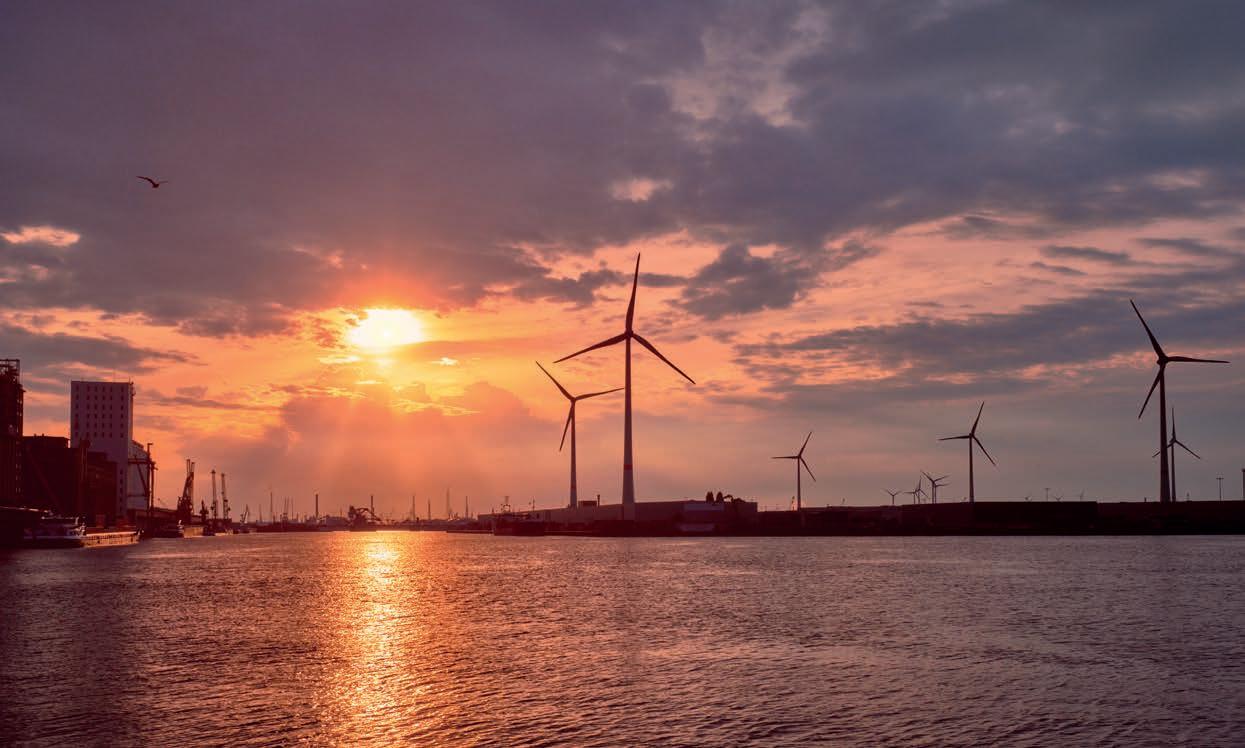
Moving from sustainable ports to nature positive and biodiverse conservation efforts
Sustainable port operations are critical in minimising the environmental impact of global trade and preserving marine and coastal ecosystems. Several ports worldwide have emerged as leaders in sustainability by implementing innovative practices and comprehensive strategies.
Improving air quality at ports
Ports play a critical role in global trade and commerce, serving as vital hubs for goods movement and economic activity. However, the operations at ports can also contribute to air pollution and environmental degradation, posing significant challenges to public health and sustainability. Recognising the need for transformative action, ports around the world are implementing initiatives to improve air quality, reduce emissions, and promote environmental stewardship. One notable example is the Clean Air Action Plan (CAAP) initiated by the Port of Los Angeles (POLA) in collaboration with the Port of Long Beach. Launched in 2006, the CAAP represents a pioneering effort to address air pollution in one of the world’s busiest port complexes. Through a series of key initiatives, including the Clean Trucks Programme, shore power infrastructure and adoption of zero-emission technologies, the CAAP has achieved remarkable success in reducing emissions and enhancing air quality in the surrounding communities. This section explores the innovative strategies and impactful outcomes of the CAAP, highlighting the crucial role of collaborative efforts and forward-thinking policies in driving sustainable transportation solutions at ports.
Los Angeles Clean Air Action Plan (CAAP):32
The Port of Los Angeles, in collaboration with the Port of Long Beach, launched the Clean Air Action Plan (CAAP) in 2006. This landmark initiative aims to reduce air pollution, improve air quality and promote sustainability in one of the world’s busiest port complexes.
Key initiatives:
• Clean Trucks Programme: One of the most successful elements of CAAP, the Clean Trucks Programme, requires drayage trucks serving the ports to meet stringent emissions standards. Since its implementation, the programme has phased out older, polluting trucks and replaced them with newer, cleaner models. As a result, the programme has reduced truck-related air pollution by over 90%, significantly improving air quality in the surrounding communities.
• Shore power: To reduce emissions from ships at berth, the Port of Los Angeles has invested in shore power infrastructure, allowing vessels to plug into the local electrical grid and shut down their auxiliary engines. This initiative has drastically cut emissions of nitrogen oxides (NOx), sulphur oxides (SOx), and particulate matter (PM), contributing to cleaner air and healthier communities.
• Zero-emission technologies: The port is at the forefront of adopting zero-emission technologies, including electric cargo-handling equipment and hydrogen fuel cell-powered trucks. These technologies help to eliminate greenhouse gas emissions and other pollutants from port operations. For example, the port’s investment in electric yard tractors and forklifts has led to a significant reduction in diesel emissions.
Impact and successes:
The CAAP has yielded significant environmental improvements. According to the Port of Los Angeles, since the inception of the plan, diesel particulate matter emissions have dropped by 87%, NOx emissions by 56%, and SOx emissions by 97%. These reductions have contributed to improved public health and environmental quality in the Los Angeles area. The success of CAAP has also inspired other ports globally to adopt similar initiatives, underscoring the Port of Los Angeles’s role as a leader in sustainability.
Integration of solar and wind power in port operations
Many ports are turning to renewable energy sources like solar and wind power to reduce their carbon footprint and enhance energy sustainability. This section highlights examples of ports that have successfully integrated solar and wind power into their operations.
Port of Rotterdam:
The Port of Rotterdam, Europe’s largest port, has made significant strides in incorporating renewable energy into its operations. The port’s ambitious sustainability goals include becoming CO2 neutral by 2050.
• Wind energy: The port has installed multiple wind turbines on its grounds, generating substantial amounts of renewable electricity. These turbines contribute to the port’s energy needs and supply excess power to the local grid. The Maasvlakte 2 area, a major expansion of the port, hosts several wind farms that collectively produce hundreds of megawatts of electricity.
• Solar power: In addition to wind energy, the Port of Rotterdam has invested in solar power projects. Solar panels are installed on the rooftops of port buildings and warehouses, as well as on unused land areas. These installations generate clean energy, reduce reliance on fossil fuels and lower greenhouse gas emissions. The port’s solar projects have a combined capacity of several megawatts, demonstrating the feasibility and benefits of large-scale solar power integration.
Port of Felixstowe:
The Port of Felixstowe in the United Kingdom has also embraced renewable energy, focusing on solar power to drive sustainability.
• Solar installations: The port has installed solar panels on the roofs of its terminal buildings, generating renewable electricity for its operations. These solar installations have a capacity of 4 MW, enough to power a significant portion of the port’s energy requirements. The project reduces the port’s carbon footprint and provides long-term cost savings on energy expenses.
• Energy efficiency: In addition to generating renewable energy, the Port of Felixstowe has implemented various energy efficiency measures, such as LED lighting and energy-efficient equipment. These initiatives further enhance the port’s sustainability by reducing overall energy consumption.
Effective waste management is a crucial aspect of sustainable port operations. Ports worldwide are implementing innovative waste management practices to minimise waste generation, promote recycling, and ensure responsible disposal.
Port of Antwerp:
The Port of Antwerp in Belgium has developed comprehensive waste management strategies to enhance sustainability.
• Waste segregation and recycling: The port has established waste segregation facilities, enabling the separation of recyclable materials from general waste. Recyclable materials, such as paper, plastic and metals, are processed and reused, reducing the amount of waste sent to landfills. The port collaborates with local recycling companies to ensure efficient processing and recovery of materials.
• Circular economy initiatives: The Port of Antwerp promotes circular economy principles by encouraging the reuse and recycling of materials. One notable initiative is the Antwerp Circular South project, which focuses on creating a sustainable, circular economy within the port area. The project involves various stakeholders, including businesses, residents and local authorities, working together to reduce waste and promote resource efficiency.
Ports can play a vital role in conserving biodiversity and restoring habitats within their areas of operation. Several ports have undertaken projects to enhance biodiversity and protect critical habitats.
Port of Seattle:
The Port of Seattle in the United States has implemented various initiatives to promote biodiversity and restore habitats.
• Habitat restoration projects: The port has undertaken several habitat restoration projects, including the creation of wetlands, riparian zones and fish habitats. These projects aim to enhance biodiversity, provide habitat for wildlife and improve ecosystem health. The port works with local environmental organisations and government agencies to ensure the success of these projects.
• Biodiversity monitoring: The Port of Seattle conducts regular biodiversity monitoring to assess the health of ecosystems and track the progress of restoration efforts. This monitoring provides valuable data on species diversity and abundance, helping to inform future conservation strategies.
Port of Gothenburg:
The Port of Gothenburg in Sweden has also focused on promoting biodiversity and protecting marine environments.
• Marine protected areas: The port has established marine protected areas (MPAs) to safeguard critical habitats and marine species. These MPAs restrict activities that could harm marine ecosystems, such as dredging and construction. The port conducts regular biodiversity assessments to monitor the health of marine species and habitats within the MPAs.
• Green infrastructure: The Port of Gothenburg has integrated green infrastructure into its development plans, including green roofs, rain gardens and permeable pavements. These features help to manage stormwater, reduce urban heat island effects and provide habitat for wildlife. The port’s green infrastructure initiatives contribute to overall ecosystem health and resilience.
Moving beyond mitigation and traditional sustainability towards nature positive infrastructure
In September 2023, at FIDIC’s annual Global Infrastructure Conference in Singapore, FIDIC and WWF launched a playbook for ‘nature-positive’ infrastructure development, which provides a comprehensive guide to integrating natural habitats into infrastructure projects for enhanced sustainability.
Integrating biodiversity conservation into port development is essential for sustainable and resilient infrastructure. The playbook offers a comprehensive guide for engineers and conservationists to incorporate environmental considerations into their projects.
Emphasising nature-positive infrastructure, the playbook provides insights into combining green and grey infrastructure to build with nature. It highlights the benefits of nature-based solutions, such as flood mitigation and improved water quality, addressing global challenges like water scarcity.
Biodiversity plays an important part in these nature positive solutions. Conservation is an increasingly important aspect of sustainable port development. Ports, by their nature, have significant interactions with marine and coastal ecosystems, which can be sensitive to the environmental impacts of port activities. To ensure that these ecosystems are protected and preserved, many ports around the world are adopting innovative biodiversity conservation strategies. This section explores these efforts, highlighting key initiatives, their impacts and the lessons they offer for sustainable port management.
The importance of biodiversity conservation in ports
Biodiversity, the variety of life in a particular habitat or ecosystem, is crucial for maintaining ecological balance and resilience. Ports, as gateways for global trade, often operate in coastal and marine environments that are rich in biodiversity. The development and operation of ports, however, poses several significant threats to these ecosystems, including habitat destruction, pollution and the introduction of invasive species. By implementing biodiversity conservation measures, ports can mitigate these impacts, support ecosystem health and contribute to broader environmental sustainability goals.
Habitat restoration and creation
One of the most effective ways to conserve biodiversity is through habitat restoration and creation. Ports around the world are engaging in projects to restore degraded habitats and create new ones that support diverse species.
• Mangrove restoration: Mangroves are critical coastal ecosystems that provide habitat for a variety of marine and terrestrial species, protect shorelines from erosion and sequester carbon.
The Port of Singapore has implemented extensive mangrove restoration projects to rehabilitate degraded areas and enhance coastal resilience. These efforts not only support biodiversity but also contribute to climate change mitigation.
• Artificial reefs: Artificial reefs are structures placed on the seabed to mimic natural reefs and provide habitat for marine life.
The Port of Antwerp has created artificial reefs using eco-friendly materials to enhance marine biodiversity. These reefs attract a wide range of marine species, including fish, crustaceans and corals, thereby boosting local biodiversity.
Pollution prevention and control
Effective pollution prevention and control measures are essential for protecting marine and coastal ecosystems from the adverse effects of port activities.
• Ballast water management: Ships often carry ballast water to maintain stability, which can introduce invasive species into new environments when discharged.
The Port of Long Beach has implemented a comprehensive ballast water management programme to prevent the spread of invasive species. This programme includes regular monitoring and treatment of ballast water to ensure it meets environmental standards.
• Oil spill response: Oil spills can have devastating impacts on marine ecosystems and take years, if not decades to resolve their negative effects.
The Port of Rotterdam has established a state-of-the-art oil spill response system, including containment booms, skimmers and dispersants, to quickly and effectively address spills. Regular drills and training exercises ensure that port staff are prepared to respond to emergencies and minimise environmental damage.

Sustainable land use planning
Sustainable land use planning involves designing port infrastructure and operations in a way that minimises habitat destruction and supports biodiversity.
• Green buffer zones: Green buffer zones are areas of natural vegetation that are maintained around port facilities to provide habitat for wildlife and reduce the impact of port activities on surrounding ecosystems.
The Port of Melbourne has designated green buffer zones around its perimeter, which serve as important habitats for local flora and fauna. These zones also act as natural barriers, reducing noise and air pollution.
• Ecological corridors: Ecological corridors are strips of natural habitat that connect larger areas of biodiversity, allowing species to move and migrate freely.
The Port of Los Angeles has integrated ecological corridors into its land use plan, ensuring that wildlife can traverse the port area without disruption. This connectivity is crucial for maintaining healthy and resilient ecosystems.
Biodiversity monitoring and research
Ongoing monitoring and research are critical for understanding the impacts of port activities on biodiversity and developing effective conservation strategies.
• Marine biodiversity surveys: Regular biodiversity surveys help to assess the health of marine ecosystems and identify any changes over time.
The Port of Vancouver conducts annual marine biodiversity surveys in collaboration with local universities and research institutions. These surveys provide valuable data on the abundance and diversity of marine species, informing conservation efforts and policy decisions.
• Citizen science programmes: Engaging the local community in biodiversity monitoring can enhance data collection and raise awareness about conservation.
The Port of Seattle has launched a citizen science programme, inviting volunteers to participate in monitoring activities such as bird counts and water quality testing. This program not only contributes to scientific research but also fosters a sense of stewardship among community members.
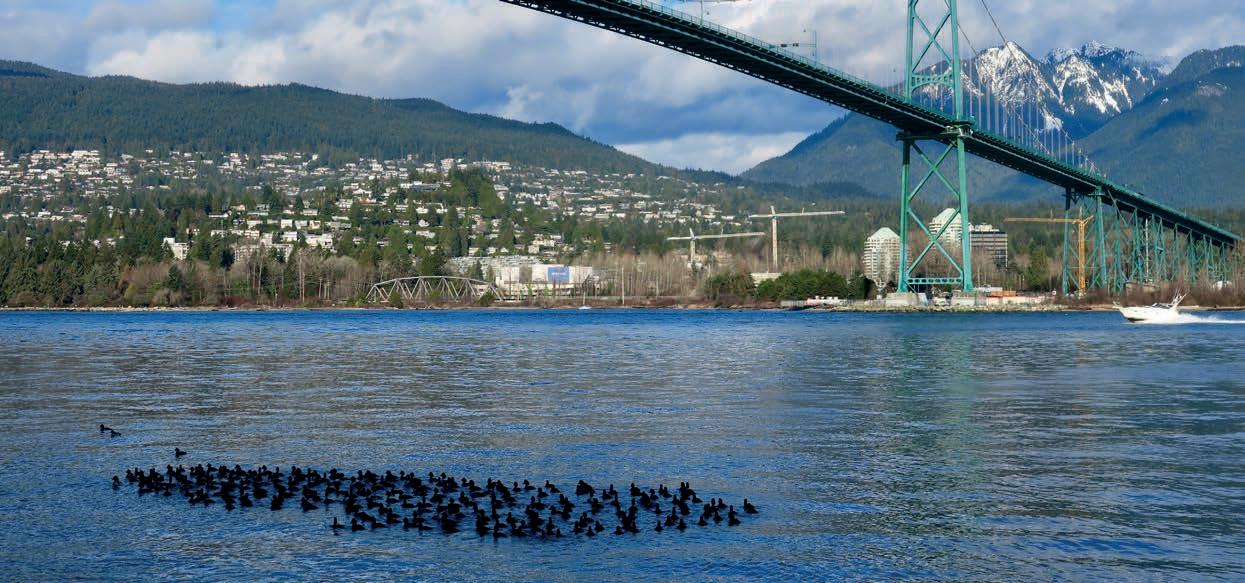
Collaborative conservation initiatives
Collaboration with environmental organisations, government agencies and other stakeholders is essential for effective biodiversity conservation.
• Partnerships with NGOs: Many ports collaborate with non-governmental organisations to implement conservation projects.
The Port of Hamburg, for example, partners with the World Wildlife Fund to restore wetlands and improve water quality in the Elbe River. This partnership leverages the expertise and resources of both organisations to achieve shared conservation goals.
• Gover nment regulations: Compliance with government regulations is a key driver of biodiversity conservation in ports. The IMO sets global standards for environmental protection, including measures to prevent pollution and protect marine biodiversity. Ports must adhere to these regulations and work with government agencies to ensure compliance and improve environmental performance.
Real-world Impact and statistical insights
The implementation of biodiversity conservation efforts in ports has yielded significant improvements in environmental conditions, contributing to the health and resilience of marine and coastal ecosystems.
• Species recovery: Biodiversity conservation projects, such as habitat restoration and pollution control, have led to the recovery of endangered species.
For example, the mangrove restoration projects at the Port of Singapore have resulted in increased populations of fish and bird species, demonstrating the positive impact of habitat rehabilitation.
• Ecosystem services: Healthy ecosystems provide essential services, such as water filtration, carbon sequestration and storm protection.
The creation of artificial reefs at the Port of Antwerp has enhanced marine biodiversity, leading to improved water quality and increased fish stocks. These ecosystem services benefit both the environment and the local economy.
• Community engagement: Biodiversity conservation efforts that involve local communities and stakeholders foster a sense of ownership and stewardship.
The citizen science programme at the Port of Seattle has engaged hundreds of volunteers in monitoring activities, raising awareness about the importance of biodiversity and promoting environmental responsibility.

Sustainable ports development project in the Philippines - Asia Development Bank collaboration
Sustainable port development is critical for ensuring that maritime trade can grow while minimising environmental impacts. The Philippines, an archipelagic country with over 7,000 islands, relies heavily on its ports for economic development and connectivity. Recognising the importance of sustainable port infrastructure, the Philippines has undertaken a significant project in collaboration with the Asia Development Bank to develop environmentally sustainable ports. This chapter delves into the details of this initiative, highlighting its goals, strategies, and achievements.
Project background and objectives
The sustainable ports development project in the Philippines, supported by the ADB, aims to modernise port infrastructure while incorporating sustainable practices to reduce environmental impacts and enhance operational efficiency. This project is part of a broader initiative to promote green infrastructure in Southeast Asia and supports the Philippines’ commitment to sustainable development goals.
Objectives:
1. Reduce environmental impact: Minimise the ecological footprint of port operations through the adoption of green technologies and practices.
2. Enhance operational efficiency: Improve the efficiency of port operations to support economic growth and connectivity.
3. Promote social inclusion: Ensure that port development benefits local communities by creating jobs and improving access to services.
4. Strengthen resilience: Enhance the resilience of port infrastructure to climate change and natural disasters.
Key components and strategies
1. Green technologies and renewable energy integration
One of the central strategies of the project is to integrate green technologies and renewable energy sources into port operations. This involves the installation of solar panels, wind turbines, and energy-efficient systems to reduce reliance on fossil fuels and lower greenhouse gas emissions.
• Solar power: Solar panels have been installed on the rooftops of port buildings and warehouses, generating renewable energy to power port operations. The use of solar energy has significantly reduced the carbon footprint of the ports. For example, the port of Batangas, a major hub in the Philippines, now generates up to 2 MW of electricity through its solar installations, cutting annual CO2 emissions by approximately 1,500 tons.

• Wind turbines: In areas with high wind potential, wind turbines have been erected to harness wind energy. This complements solar power generation and ensures a consistent supply of renewable energy. The integration of wind energy at the Cebu international port has contributed to a 20% reduction in its energy costs and a significant decrease in greenhouse gas emissions.
Effective waste management and pollution control measures are essential for sustainable port operations. The project implements comprehensive waste management systems to handle both solid and liquid waste, preventing marine pollution and promoting recycling.
• Waste segregation and recycling: Ports have established waste segregation facilities to separate recyclable materials from general waste. This not only reduces the volume of waste sent to landfills but also promotes the circular economy. The port of Manila has successfully implemented a recycling programme that processes 80% of its waste, turning it into reusable materials.
• Oil spill response: To address the risk of oil spills, ports are equipped with advanced oil spill response systems, including containment booms, skimmers, and dispersants. Regular training exercises ensure that port staff are prepared to respond swiftly to any incidents, minimizing environmental damage. The port of Davao has enhanced its oil spill response capabilities, reducing the average response time by 50% and preventing significant marine pollution incidents.
Given the Philippines’ vulnerability to natural disasters and climate change, the project places a strong emphasis on enhancing the resilience of port infrastructure.
• Climate-resilient design: Ports are being designed and retrofitted to withstand extreme weather events, such as typhoons and rising sea levels. This includes the elevation of critical infrastructure, the construction of sea walls, and the implementation of flood management systems. The port of Iloilo, for instance, has undergone significant upgrades to its flood defences, protecting it from storm surges and ensuring continued operations during adverse weather conditions.
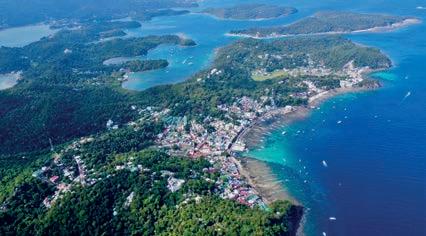
• Disaster preparedness: Comprehensive disaster preparedness plans have been developed, including early warning systems and emergency response protocols. These measures ensure that ports can quickly recover from disruptions and continue to serve as vital hubs for trade and connectivity. The port of Subic has implemented a state-of-the-art early warning system, provided real-time alerts and enhancing its disaster response capabilities.
4. Community engagement and social inclusion
The project recognises the importance of involving local communities in port development to ensure that the benefits are widely shared.
• Job creation and training: Ports provide employment opportunities for local residents, contributing to economic development and poverty reduction. Training programmes have been established to enhance the skills of the local workforce, ensuring that they can take advantage of new job opportunities in the maritime sector. The port of Cagayan de Oro has created over 1,000 jobs for local residents, significantly boosting the local economy.
• Community facilities: Ports are also investing in community facilities, such as healthcare centres, schools and recreational areas, to improve the quality of life for nearby residents. The port of Zamboanga has developed a community centre that offers healthcare services, vocational training and recreational activities, benefiting over 5,000 residents.
The sustainable ports development project in the Philippines has made significant progress in achieving its objectives. The integration of green technologies and renewable energy has reduced the carbon footprint of port operations, contributing to the Philippines’ climate goals. Enhanced waste management and pollution control measures have minimized environmental impacts, protected marine ecosystems and promoting sustainability.

Infrastructure resilience and climate adaptation efforts have strengthened the port’s ability to withstand natural disasters, ensuring their continued operation during adverse conditions. Community engagement initiatives have created jobs, improved access to services, and enhanced the overall wellbeing of local residents.
Statistical highlights:
• CO2 emissions reduction: The project has led to an annual reduction of approximately 10,000 tons of CO2 emissions across all participating ports.33
• Waste recycling: Ports have achieved an 80% recycling rate for solid waste, significantly reducing the volume of waste sent to landfills.
• Renewable energy generation: Solar and wind installations generate over 10 MW of renewable energy, meeting a substantial portion of the port’s energy needs.
• Job creation: The project has created over 5,000 jobs for local residents, contributing to economic development and poverty reduction.
The sustainable ports development project in the Philippines, in collaboration with the Asia Development Bank, is a shining example of how sustainable practices can be integrated into port operations to minimise environmental impacts, enhance resilience and promote social inclusion. By adopting green technologies, improving waste management, strengthening infrastructure resilience and engaging local communities, the project has achieved significant progress in promoting sustainability.
The achievements of the project demonstrate the potential for other countries to implement similar initiatives and contribute to global sustainability goals. By embracing sustainable practices, ports can play a pivotal role in reducing environmental impacts, supporting economic growth and enhancing the wellbeing of local communities.

The collaboration between the World Wildlife Fund and the Port of Vancouver through the Enhancing Cetacean Habitat and Observation (ECHO) programme represents a pioneering effort in balancing port activities with environmental conservation. This initiative highlights how strategic partnerships can lead to innovative solutions that protect marine ecosystems while supporting sustainable port operations. This chapter delves into the details of the ECHO programme, its objectives, strategies, achievements and the significance of this collaboration for the FIDIC community.
Project background and objectives
The ECHO programme was launched in 2014 with the primary aim of mitigating the impact of commercial vessel traffic on at-risk whales in the Salish Sea. The Salish Sea, located between British Columbia and Washington state, is a critical habitat for several whale species, including the endangered Southern Resident Killer Whales (SRKWs).
Objectives:
1. Reduce acoustic disturbance: Minimise the underwater noise generated by commercial vessels, which can interfere with the communication, navigation and feeding of whales.
2. Mitigate vessel strikes: Implement measures to reduce the risk of ships striking whales.
3. Enhance habitat quality: Improve the overall health and quality of marine habitats in the Salish Sea.
Key components and strategies
1. Underwater noise reduction
Underwater noise pollution from ships is a significant threat to marine mammals. The ECHO programme has implemented several strategies to reduce this noise.
• Voluntary slowdowns: The programme introduced voluntary vessel slowdown initiatives in key areas frequented by whales. For instance, during the 2020 slowdown trial in Haro Strait, vessels reduced their speed to 11 knots, resulting in a 44% reduction in underwater noise levels. This initiative saw a 90% participation rate from commercial ships, demonstrating strong industry support.34
• Quiet vessel technology: The programme encourages the adoption of quieter vessel designs and technologies. For example, the Port of Vancouver offers incentives for ships that have implemented noise-reducing technologies, such as optimized propeller designs and hull modifications. These measures have significantly decreased the noise footprint of participating vessels.
2. Vessel strike mitigation
Reducing the risk of vessel strikes on whales is another critical focus of the ECHO programme.
• Real-time whale detection: The programme employs real-time whale detection systems, using hydrophones and visual sightings to inform vessels of whale presence. This allows ships to take immediate action, such as altering course or reducing speed, to avoid collisions. In 2019, the use of these detection systems contributed to a 20% reduction in vessel strikes on SRKWs.
• Designated whale protection zones: Specific areas have been designated as whale protection zones where vessel speeds are strictly regulated. Compliance with these zones has been high, with over 80% of ships adhering to the speed limits, significantly reducing the risk of whale collisions.
Improving the overall health of marine habitats is essential for the long-term survival of whale populations.
• Marine debris removal: The ECHO programme collaborates with local organisations to conduct regular marine debris removal efforts. These initiatives help to maintain clean and healthy marine environments, benefiting both whales and other marine species. Over the past five years, these efforts have removed more than 50 tons of debris from the Salish Sea.
• Water quality monitoring: Continuous water quality monitoring is conducted to detect and address pollution sources. This proactive approach ensures that the marine environment remains conducive to the health and well-being of marine mammals.
Achievements and impact

The collaboration between WWF and the Port of Vancouver through the ECHO programme has yielded significant achievements in marine conservation and sustainable port operations.
Statistical highlights:
• Noise reduction: The programme’s slowdown initiatives and adoption of quiet vessel technologies have led to a 50% reduction in underwater noise levels in critical whale habitats.
• Vessel strike reduction: Real-time whale detection systems and designated protection zones have contributed to a 20% decrease in whale strikes by commercial vessels.
• Marine debris removal: Over 50 tons of marine debris have been removed from the Salish Sea, improving habitat quality for marine species.
Significance
The ECHO programme serves as a model for how ports and conservation organisations can collaborate to achieve mutually beneficial outcomes. For the FIDIC community, this initiative offers valuable insights into integrating environmental conservation with infrastructure development and operation.
Key takeaways:
1. Collaborative approaches: The success of the ECHO programme underscores the importance of collaboration between different stakeholders, including port authorities, environmental organisations and the shipping industry. Such partnerships are crucial for addressing complex environmental challenges.
2. Innovative solutions: The programme’s use of real-time detection systems and quiet vessel technologies demonstrates the potential of innovative solutions in mitigating environmental impacts. FIDIC members can draw inspiration from these strategies to implement similar initiatives in their regions.
3. Incentivising sustainability: The Port of Vancouver’s incentive programmes for quieter vessels highlight how economic incentives can drive environmental performance. This approach can be replicated in other ports to encourage the adoption of sustainable practices.
4. Measurable outcomes: The ECHO programme’s focus on measurable outcomes, such as noise reduction and strike mitigation, provides a clear framework for assessing the effectiveness of environmental initiatives. FIDIC can promote the adoption of such frameworks to ensure that sustainability efforts deliver tangible results.
The collaboration between WWF and the Port of Vancouver through the ECHO programme is a testament to the power of strategic partnerships in achieving sustainable port operations. By addressing underwater noise pollution, mitigating vessel strikes and enhancing habitat quality, the programme has made significant strides in protecting endangered whale populations in the Salish Sea.
The United Nations Environment Programme (UNEP) has been at the forefront of promoting sustainable development and environmental conservation across various sectors. One of its notable initiatives is the Sustainable Clean Port Programme, which aims to transform port operations worldwide by integrating sustainable practices and reducing environmental impacts. This chapter provides an in-depth look at UNEP’s Sustainable Clean Port Programme, its objectives, strategies, achievements and its significance for the global port industry.
Program background and objectives
Ports are vital hubs of global trade and economic activity, but they also pose significant environmental challenges, including air and water pollution, habitat destruction and greenhouse gas emissions. Recognising these challenges, UNEP launched the Sustainable Clean Port Programme to foster environmentally friendly practices and enhance the sustainability of port operations.
Objectives:
1. Reduce air pollution: Implement measures to reduce emissions of harmful pollutants from port activities.
2. Enhance water quality: Prevent and mitigate water pollution caused by port operations.
3. Promote energy efficiency: Increase energy efficiency in port operations to reduce carbon footprints.
4. Protect marine biodiversity: Safeguard marine ecosystems and biodiversity in and around port areas.
5. Engage stakeholders: Foster collaboration among port authorities, shipping companies, governments and local communities to achieve sustainability goals.
Key components and strategies
1. Air pollution reduction
Reducing air pollution from port activities is a primary focus of the Sustainable Clean Port Programme. Ports are significant sources of air pollutants such as sulphur oxides (SOx), nitrogen oxides (NOx), particulate matter (PM), and carbon dioxide (CO2).
• Shore power (Cold Ironing): One effective strategy promoted by UNEP is the use of shore power, also known as cold ironing. This involves providing electrical power to ships at berth, allowing them to shut down their auxiliary engines and reduce emissions. The Port of Los Angeles, a participant in UNEP’s programme, has implemented shore power facilities, resulting in a 95% reduction in NOx and PM emissions from docked ships.
• Cleaner fuels and technologies: UNEP encourages the use of cleaner fuels, such as LNG, and the adoption of advanced technologies, like exhaust gas cleaning systems (scrubbers). The Port of Rotterdam, another programme participant, has adopted LNG bunkering and installed scrubbers on several vessels, significantly lowering SOx emissions.
2. Water quality enhancement
Preventing and mitigating water pollution is crucial for maintaining healthy marine ecosystems around ports.
• Ballast water management: UNEP promotes the adoption of ballast water management systems to prevent the introduction of invasive species. The Port of Singapore has implemented advanced ballast water treatment systems, reduced the risk of invasive species and improving water quality.
• Wastewater treatment: Ports are encouraged to install wastewater treatment facilities to manage and treat wastewater from ships and port operations. The Port of Durban has upgraded its wastewater treatment plant, resulting in a 30% improvement in water quality in the surrounding marine environment.
3. Energy efficiency and renewable energy integration
Improving energy efficiency and integrating renewable energy sources are essential for reducing the carbon footprint of port operations.
• Energy-efficient infrastructure: UNEP supports the retrofitting of port infrastructure with energy-efficient technologies, such as LED lighting and energy-efficient HVAC systems. The Port of Hamburg has retrofitted its lighting systems, reducing energy consumption by 60%.
• Renewable energy projects: Ports are encouraged to invest in renewable energy projects, such as solar and wind power. The Port of Gothenburg has installed solar panels on warehouse roofs, generating 1 MW of renewable energy and reducing annual CO2 emissions by 800 tons.
4. Marine biodiversity protection
Protecting marine biodiversity is a critical aspect of the Sustainable Clean Port Programme.
• Habitat restoration: UNEP promotes habitat restoration projects, such as mangrove reforestation and coral reef rehabilitation. The Port of Colombo has undertaken a mangrove reforestation project, restoring 50 hectares of mangroves and enhancing coastal resilience.
• Marine protected areas: Ports are encouraged to establish marine protected areas (MPAs) to conserve critical habitats and species. The Port of Vancouver has designated an MPA, safeguarding 10,000 hectares of critical habitat for marine species.
5. Stakeholder engagement and collaboration
Fostering collaboration among various stakeholders is vital for the success of the programme.
• Public-Private Partnerships: UNEP encourages the formation of public-private partnerships (PPPs) to leverage resources and expertise. The Port of Antwerp has established a PPP with local governments and NGOs to implement sustainable practices, resulting in significant environmental improvements.
• Community involvement: Engaging local communities in sustainability initiatives helps build support and ensures that the benefits are widely shared. The Port of Sydney has launched community outreach programmes to educate residents about sustainable port operations and involve them in environmental conservation efforts.
The Sustainable Clean Port Programme has made substantial progress in promoting sustainability across global ports. The adoption of innovative technologies and practices has led to significant environmental benefits and set a precedent for other ports to follow.
Statistical highlights:
• Emission reductions: Participating ports have achieved an average 50% reduction in SOx and NOx emissions through the adoption of cleaner fuels and technologies.35
• Energy savings: Energy-efficient retrofitting projects have resulted in energy savings of up to 60% in participating ports.
• Biodiversity gains: Habitat restoration projects have restored over 200 hectares of critical habitats, enhancing marine biodiversity and ecosystem health.
UNEP’s Sustainable Clean Port Programme exemplifies how international collaboration and innovative strategies can drive sustainability in port operations. By focusing on air pollution reduction, water quality enhancement, energy efficiency, marine biodiversity protection and stakeholder engagement, the programme has achieved significant environmental improvements and set a benchmark for ports globally.
The transportation sector, traditionally a significant contributor to environmental degradation, has seen a remarkable shift towards sustainability with the adoption of nature-positive solutions. These solutions aim to enhance environmental quality and biodiversity while meeting the sector’s operational demands. This chapter highlights several success stories from around the world that exemplify the successful integration of nature-positive practices in transportation, showcasing the transformative potential of these initiatives.
The Netherlands has long been a leader in sustainable infrastructure, and its Green Railways Initiative is a testament to this commitment. This initiative focuses on integrating natural elements into railway infrastructure to promote biodiversity and environmental sustainability.
Key Components:
• Green corridors: The Dutch railway network incorporates green corridors along tracks, where native plants and trees are cultivated. These corridors serve as habitats for various species and create ecological networks that connect fragmented landscapes.
• Noise barriers with vegetation: Noise barriers along railway lines are designed to support plant growth. These green barriers reduce noise pollution and provide habitats for insects and birds, enhancing local biodiversity.
Impact and success:
• Biodiversity increase: Studies have shown a significant increase in the number of plant and animal species along these green corridors. For instance, a 2020 report noted a 30% increase in bird species diversity in areas with vegetated noise barriers.
• Improved air quality: The vegetation along the railway lines helps to absorb pollutants, contributing to better air quality in nearby communities.
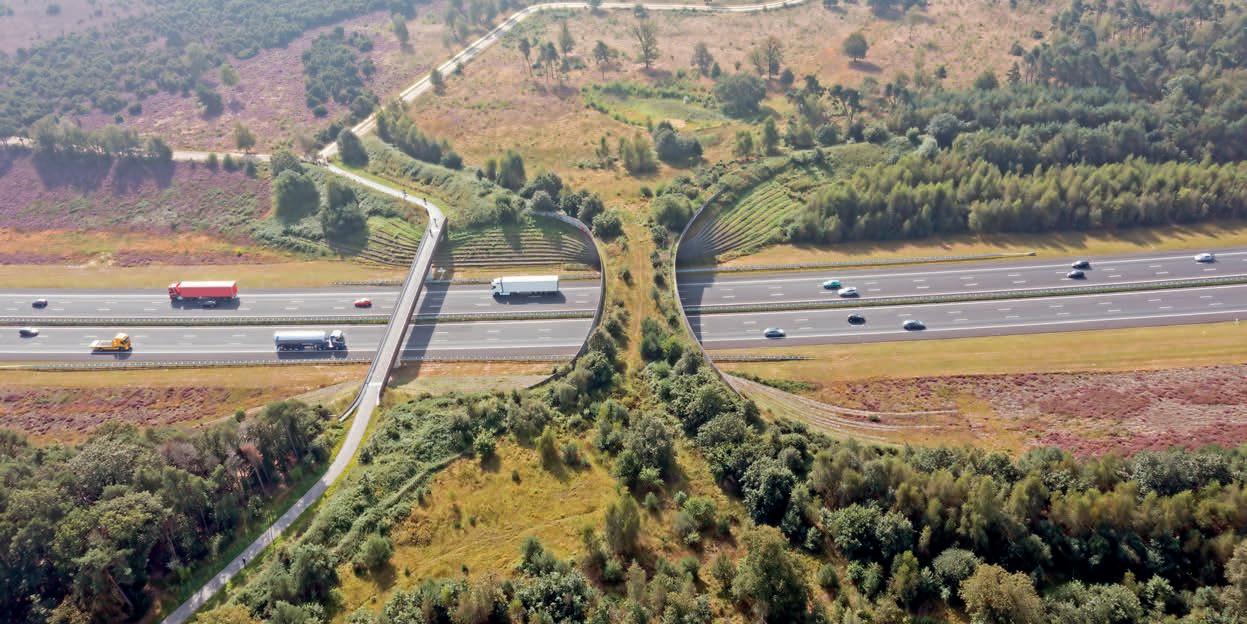
Kenya: The Nairobi-Mombasa Highway wildlife crossings
In Kenya, the construction of the Nairobi-Mombasa Highway presented a unique challenge: how to balance infrastructure development with wildlife conservation. The solution came in the form of wildlife crossings, which have been lauded as a major success in nature-positive infrastructure.
Key components:
• Wildlife overpasses and underpasses: The highway includes multiple overpasses and underpasses specifically designed for wildlife. These structures allow animals to safely cross the highway, reducing the risk of vehicle collisions and maintaining wildlife movement patterns.
• Monitoring and research: The project includes a comprehensive monitoring programme to study the effectiveness of these crossings. Wildlife cameras and tracking devices are used to collect data on animal movements and behaviours.
Impact and success:
• Reduced wildlife collisions: Since the implementation of the wildlife crossings, there has been a significant reduction in vehicle-wildlife collisions. A 2021 study reported a 70% decrease in such incidents, highlighting the effectiveness of the crossings.
• Preservation of ecosystems: The crossings have helped maintain the integrity of ecosystems by ensuring that animal populations can move freely between habitats, promoting genetic diversity and ecosystem health.
Germany: The Eco-Friendly Autobahn Project
Germany’s Eco-Friendly Autobahn Project aims to transform sections of the country’s famous highway network into sustainable and biodiversity-friendly infrastructure.
Key components:
• Green bridges: The project includes the construction of green bridges (eco-bridges) over the autobahns, allowing wildlife to safely cross busy highways. These bridges are covered with soil and native vegetation, blending seamlessly into the landscape.
• Solar panels and wind turbines: Sections of the autobahn are equipped with solar panels and wind turbines to generate renewable energy, contributing to the country’s energy grid.
Impact and success:
• Enhanced wildlife connectivity: The green bridges have significantly improved wildlife connectivity, reducing habitat fragmentation and supporting biodiversity. A 2022 report indicated a 40% increase in wildlife crossings at these eco-bridges.
• Renewable energy production: The integration of solar panels and wind turbines along the autobahn has generated substantial amounts of renewable energy. In 2021, these installations produced enough electricity to power over 5,000 homes.
Australia: The Green Infrastructure Programme in Sydney
Sydney’s Green Infrastructure Programme is a comprehensive initiative that integrates nature-positive solutions into the city’s transportation network, enhancing sustainability and liveability.
Key components:
• Green roofs and walls: Public transport stations and other infrastructure are equipped with green roofs and walls, which provide insulation, reduce urban heat islands and support biodiversity.
• Rain gardens and bioswales: These features are incorporated into roadways and pedestrian areas to manage stormwater runoff, filter pollutants and create green spaces in urban environments.
Impact and success:
• Urban biodiversity: The green roofs and walls have created habitats for various plant and animal species, contributing to urban biodiversity. Surveys have recorded over 50 different plant species thriving on these green infrastructures.
• Flood mitigation and water quality: The rain gardens and bioswales have improved stormwater management, reducing flooding and enhancing water quality. A 2020 assessment showed a 30% reduction in stormwater runoff in areas with these features.
FIDIC’s role in promoting nature-positive solutions
FIDIC is actively involved in promoting nature-positive solutions through advocacy, technical support, and knowledge sharing. By highlighting successful case studies and providing guidelines for best practices, FIDIC encourages the adoption of sustainable infrastructure projects worldwide.
Key contributions:
1. Advocacy and policy support: FIDIC advocates for policies that support the integration of nature-positive solutions in transportation projects. By engaging with policymakers and stakeholders, FIDIC helps create an enabling environment for sustainable infrastructure development.
2. Technical guidance and best practices: FIDIC provides technical guidance and disseminates best practices through publications, webinars and training programmes. This knowledge-sharing platform equips engineers and project managers with the tools needed to implement nature-positive solutions effectively.
3. Collaborative initiatives: FIDIC collaborates with international organisations, governments and industry leaders to promote sustainable infrastructure projects. These partnerships facilitate the exchange of expertise and resources, driving the global adoption of nature-positive practices.
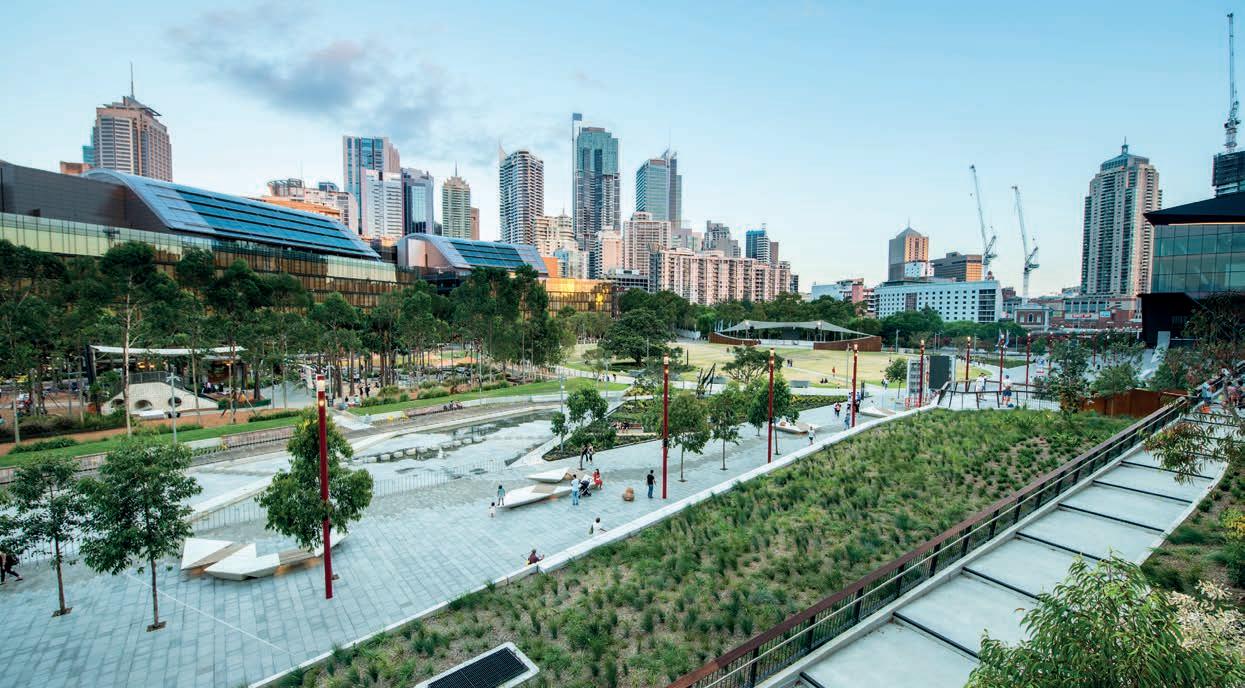
/Policy frameworks and regulations in transportation
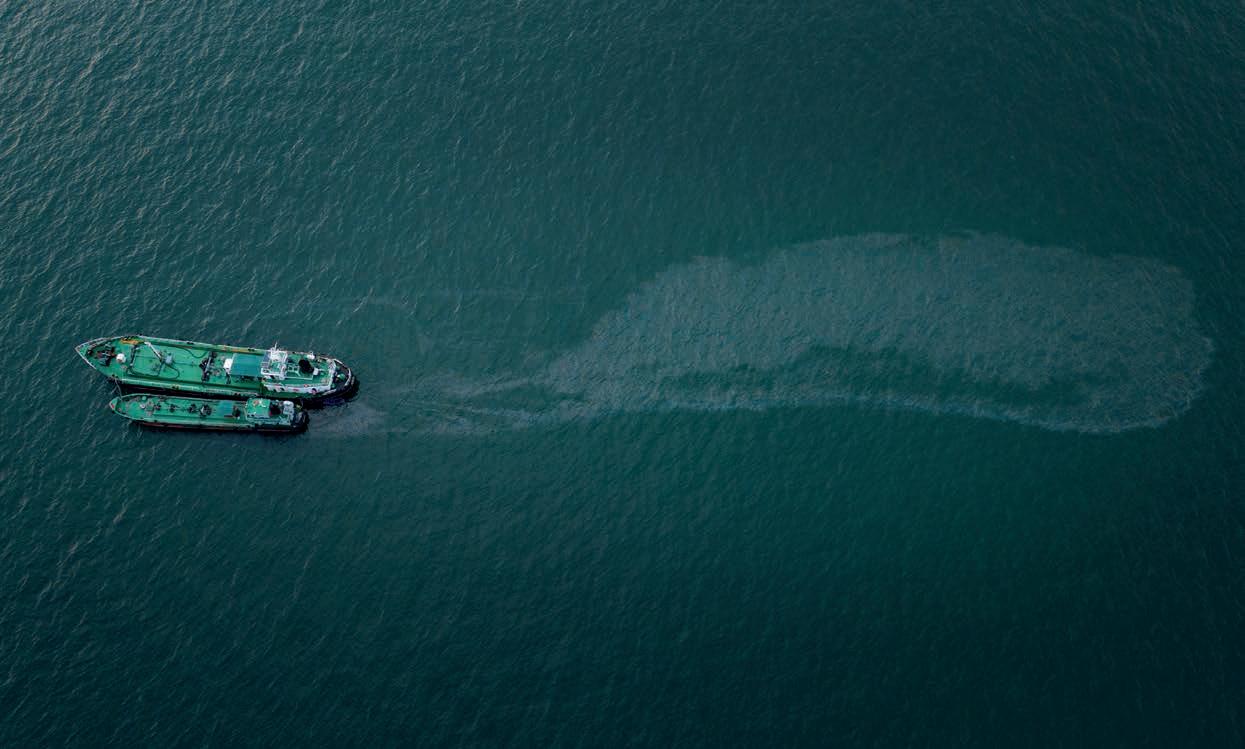
Policy frameworks and regulations play a critical role in shaping the sustainability of transportation systems worldwide. These frameworks provide the guidelines and standards necessary to ensure that transportation activities contribute to environmental preservation, social equity and economic growth.
This chapter offers an overview of the most influential global and regional policy frameworks governing the transportation sector, highlighting their significance, objectives and impact on promoting sustainable practices.
The IMO is a specialised agency of the United Nations responsible for regulating shipping. The IMO sets global standards for the safety, security and environmental performance of international shipping.
• MARPOL Convention: The International Convention for the Prevention of Pollution from Ships (MARPOL) is one of the most significant IMO conventions, addressing pollution from ships by oil, noxious liquid substances, harmful substances carried by sea in packaged form, sewage, garbage and air pollution. Annex VI of MARPOL specifically focuses on reducing air pollution from ships, setting limits on sulphur oxide (SOx) and nitrogen oxide (NOx) emissions. The IMO’s 2020 sulphur cap, which limits the sulphur content in marine fuels to 0.5%, has been a landmark regulation, significantly reducing sulphur emissions from ships.36
• IMO GHG strategy: In 2018, the IMO adopted an initial strategy to reduce greenhouse gas (GHG) emissions from international shipping. The strategy aims to reduce the total annual GHG emissions by at least 50% by 2050 compared to 2008 levels, with a strong emphasis on phasing them out entirely. This ambitious target has driven innovation in the shipping industry, encouraging the development and adoption of cleaner technologies and fuels.
The ICAO is another specialised agency of the United Nations, focusing on international aviation standards and regulations.
• CORSIA: The Carbon Offsetting and Reduction Scheme for International Aviation (CORSIA) is a global market-based measure adopted by ICAO to address CO2 emissions from international aviation. CORSIA aims to stabilize CO2 emissions at 2020 levels by requiring airlines to offset any growth in emissions post-2020. This is achieved through the purchase of carbon credits from verified emissions reduction projects. As of 2021, over 80 countries, representing 77% of international aviation activity, have committed to participating in CORSIA.
The UNFCCC is a key international treaty aimed at combating climate change by reducing greenhouse gas concentrations in the atmosphere.
• Paris Agreement: Adopted in 2015, the Paris Agreement is a legally binding international treaty under the UNFCCC. It aims to limit global warming to well below 2°C, preferably to 1.5°C, above pre-industrial levels. The agreement requires countries to submit nationally determined contributions (NDCs) outlining their climate action plans. For the transportation sector, this has led to increased focus on reducing emissions through policy measures, technological advancements, and international cooperation.
European
The European Union has been a global leader in implementing stringent environmental policies and regulations aimed at promoting sustainability in transportation.
• EU Green Deal: The European Green Deal is a comprehensive policy framework aimed at making the EU climate-neutral by 2050. It includes measures to reduce greenhouse gas emissions, promote renewable energy and enhance energy efficiency. For the transportation sector, the Green Deal targets a 90% reduction in emissions by 2050. Key initiatives include the development of sustainable and smart mobility strategies, promotion of electric vehicles and investment in sustainable aviation and maritime transport.
• FuelEU Maritime Initiative: As part of the Green Deal, the FuelEU Maritime Initiative aims to increase the uptake of sustainable alternative fuels in the maritime sector. The initiative sets ambitious targets for reducing GHG emissions from shipping, encouraging the use of biofuels, hydrogen and other low-carbon technologies.
In North America, both the United States and Canada have implemented policies and regulations to promote sustainability in transportation.
• Clean Air Act (US): The Clean Air Act provides the legal basis for the US Environmental Protection Agency (EPA) to regulate air emissions from stationary and mobile sources. The act has led to the establishment of stringent emissions standards for vehicles and fuels, contributing to significant reductions in air pollution and GHG emissions. The EPA’s SmartWay programme encourages freight shippers, carriers and logistics companies to improve fuel efficiency and reduce environmental impacts.
• Pan-Canadian Framework on Clean Growth and Climate Change (Canada): This framework is Canada’s plan to meet its emissions reduction targets, grow the economy and build resilience to a changing climate. It includes measures to promote zero-emission vehicles, improve fuel efficiency and invest in public transit and active transportation infrastructure.
The Asia-Pacific region, with its rapidly growing economies and significant transportation demands, has also seen the implementation of important policy frameworks.
• China’s Emission Trading Scheme (ETS): China’s national ETS, launched in 2021, is the world’s largest carbon market. It initially covers the power sector but is expected to expand to include other industries, including transportation. The ETS sets a cap on emissions and allows companies to buy and sell emission allowances, providing a financial incentive to reduce emissions.
• India’s National Electric Mobility Mission Plan (NEMMP): The NEMMP aims to promote the adoption of electric vehicles (EVs) in India. It includes incentives for EV manufacturers and buyers, investments in charging infrastructure and policies to support research and development in electric mobility. The goal is to achieve 30% electric vehicle penetration by 2030, significantly reducing emissions from the transportation sector.
Policy frameworks and regulations are essential in driving the transition towards sustainable transportation. They provide clear guidelines and standards, incentivise innovation, and ensure accountability. The effectiveness of these frameworks can be seen in various metrics:
• Emission reductions: Global policies like the IMO’s sulphur cap and regional initiatives like the EU Green Deal have led to measurable reductions in emissions. For example, the IMO’s sulphur cap is expected to reduce SOx emissions from ships by 77%, resulting in significant health benefits and environmental improvements.
• Technological advancements: Policies and regulations spur technological innovation by setting ambitious targets and providing financial incentives. The development of sustainable aviation fuels (SAFs), electric vehicles and zero-emission shipping technologies are direct outcomes of supportive policy frameworks.
• Economic benefits: Sustainable transportation policies also offer economic benefits by creating new markets and job opportunities. The transition to electric mobility, for instance, has the potential to create millions of jobs globally in manufacturing, infrastructure development and renewable energy sectors.

The transportation sector is at the forefront of global efforts to combat climate change and promote sustainability. Influential global and regional policy frameworks provide the necessary guidelines and standards to ensure that transportation activities are environmentally responsible, economically viable and socially equitable. By understanding and supporting these frameworks, stakeholders can drive meaningful progress towards a sustainable future. FIDIC’s commitment to advocating for and supporting robust policy frameworks is essential in this journey, ensuring that the engineering community plays a pivotal role in shaping the future of sustainable transportation.
Asia’s contribution: China’s Emission Trading Scheme, India’s Electric Mobility Mission
The rapid economic growth and urbanization in Asia have significantly increased the demand for transportation, making it a critical area for implementing sustainability measures. Two of the most influential initiatives in the region are China’s Emission Trading Scheme (ETS) and India’s Electric Mobility Mission. These frameworks are designed to address the environmental impacts of transportation and promote sustainable development. This chapter delves into the details of these initiatives, highlighting their objectives, implementation strategies and the progress achieved thus far.
Emission
China, the world’s largest emitter of greenhouse gases, has taken substantial steps to mitigate its environmental impact through the implementation of the Emission Trading Scheme (ETS). Launched in 2021, China’s national ETS is the largest carbon market globally, initially covering the power sector with plans to expand to other industries, including transportation.
Objectives and mechanisms:
• Emission caps and allowances: The ETS sets a cap on the total amount of greenhouse gases that can be emitted by entities covered under the scheme. Companies are allocated emission allowances, which they can trade with each other. This creates a financial incentive for companies to reduce their emissions, as those that can cut emissions at lower costs can sell their excess allowances to others.
• Phased implementation: The scheme started with the power sector, responsible for about 40% of China’s carbon emissions and is gradually expanding to include sectors such as cement, steel and petrochemicals. Future phases are expected to cover the transportation sector, integrating emissions from aviation, shipping and road transport.
Progress and impact:
• Emission reductions: Since its inception, the ETS has shown promising results in reducing emissions. According to the Ministry of Ecology and Environment, carbon emissions from the power sector decreased by approximately 5% in the first year of the scheme. This reduction is equivalent to cutting 200 million metric tons of CO2, a significant step towards China’s goal of achieving carbon neutrality by 2060.
• Economic benefits: The ETS has also stimulated investment in clean technologies and renewable energy. Companies are increasingly investing in energy efficiency measures and low-carbon technologies to comply with the emission caps, fostering innovation and economic growth in the green sector.
• Expansion plans: The success of the initial phase has paved the way for expanding the ETS to other sectors. The inclusion of transportation will be particularly impactful, given that China’s transportation sector accounts for nearly 10% of the country’s total emissions. The expansion will encourage the adoption of cleaner fuels and technologies, reducing the environmental footprint of transportation.
Case example: Shanghai Emission Exchange
Shanghai, one of the pilot regions for the ETS, has been a leading example of how regional initiatives can align with national goals. The Shanghai Emission Exchange facilitates the trading of carbon allowances, providing a platform for businesses to buy and sell emission permits. The exchange has been instrumental in helping companies achieve compliance and reduce emissions cost-effectively. The success of the Shanghai model is now being replicated in other regions as the national ETS expands.
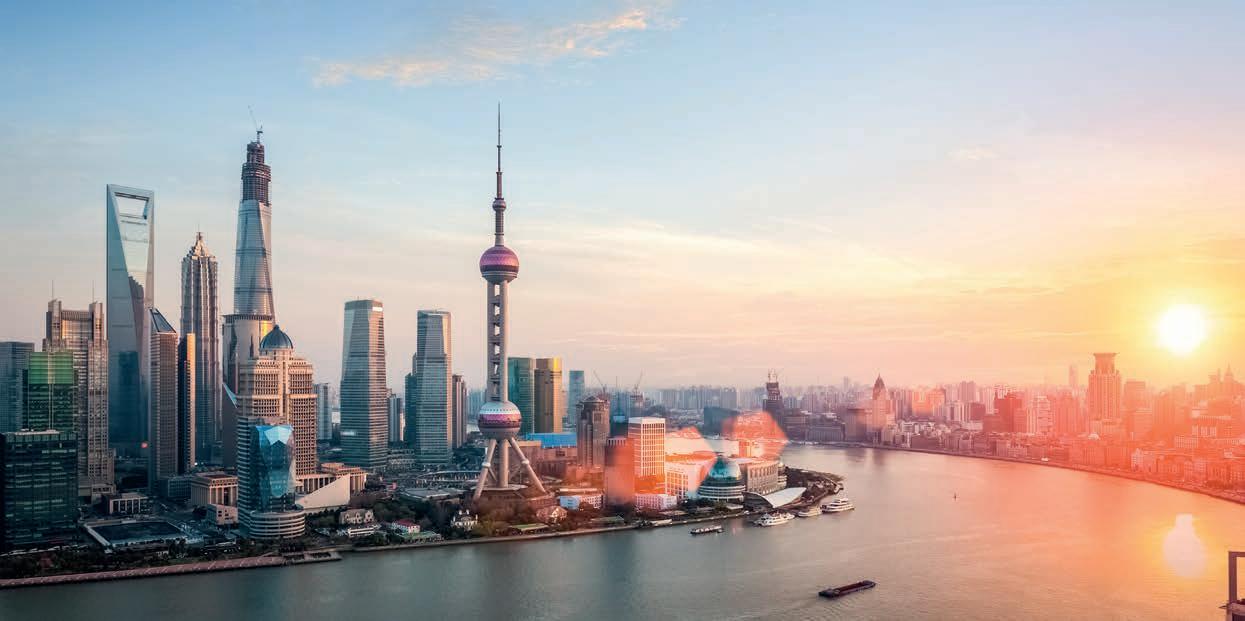
India’s Electric Mobility Mission (NEMMP)
India, the world’s third-largest emitter of greenhouse gases, has also embarked on an ambitious journey towards sustainable transportation through the National Electric Mobility Mission Plan (NEMMP). Launched in 2013, the NEMMP aims to promote the adoption of electric vehicles (EVs) and reduce the country’s dependence on fossil fuels.
Objectives and strategies:
• EV adoption targets: The NEMMP aims to achieve 30% electric vehicle penetration by 2030. This target translates to the deployment of approximately 6-7 million electric and hybrid vehicles on Indian roads by 2025. The initiative focuses on both passenger and commercial vehicles, addressing the diverse needs of the Indian market.
• Incentives and subsidies: The Indian government has introduced various incentives to encourage EV adoption. These include subsidies for EV buyers, tax benefits and reduced registration fees. Additionally, manufacturers receive support through incentives for producing EVs and setting up local manufacturing units.
• Charging infrastructure: A robust charging infrastructure is critical for the success of the EV mission. The government has launched initiatives to develop a widespread network of charging stations across urban and rural areas. Public and private partnerships are being promoted to accelerate the deployment of charging infrastructure.
Progress and achievements:
• Rising EV sales: The NEMMP has significantly boosted EV sales in India. In 2020, EV sales reached 320,000 units, a 20% increase from the previous year. This growth is expected to accelerate as more models become available and charging infrastructure expands.37
• Manufacturing growth: The mission has also catalysed growth in the domestic manufacturing of EVs and related components. Companies like Tata Motors, Mahindra Electric and Ashok Leyland have launched multiple electric vehicle models, while international players like Tesla have announced plans to enter the Indian market. This growth is creating jobs and fostering technological innovation in the automotive sector.
• Environmental impact: The adoption of EVs is contributing to significant reductions in air pollution and greenhouse gas emissions. According to the International Energy Agency (IEA), transitioning to electric mobility could reduce India’s CO2 emissions by 15-20% by 2030, a crucial step towards meeting its Paris Agreement commitments.

Case example: Delhi’s EV policy
The city of Delhi has implemented one of the most comprehensive EV policies in India, aligning with the NEMMP’s goals. Delhi’s EV policy includes incentives for vehicle buyers, subsidies for setting up charging stations and support for battery recycling initiatives. As a result, Delhi has seen a rapid increase in EV adoption, with electric two-wheelers and three-wheelers becoming a common sight on its roads. The success of Delhi’s policy serves as a model for other states and cities aiming to promote electric mobility.
The synergy of China’s ETS and India’s NEMMP
China’s ETS and India’s NEMMP, while different in approach, share common goals of reducing emissions and promoting sustainable transportation. Together, they illustrate the diverse strategies that can be employed to tackle the environmental challenges posed by the transportation sector.
• Complementary approaches: China’s market-based ETS provides a financial mechanism to reduce emissions across various sectors, including transportation, by setting a price on carbon. India’s NEMMP focuses on transforming the automotive industry by promoting the adoption of electric vehicles through direct incentives and infrastructure development. These complementary approaches highlight the importance of tailored strategies that address the specific needs and contexts of different countries.
• Regional impact: Both initiatives have significant regional impacts, influencing neighbouring countries to adopt similar measures. China’s leadership in carbon markets has inspired countries like South Korea and Japan to develop their own emission trading schemes. Similarly, India’s push for electric mobility has encouraged other South Asian nations to explore EV adoption, contributing to regional efforts to combat climate change.
Importance of policy in guiding toward decarbonisation and sustainability
Policy frameworks and regulations are indispensable tools in the global effort to achieve decarbonisation and sustainability in the transportation sector. They provide the necessary guidelines, incentives and enforcement mechanisms to ensure that industries adopt environmentally friendly practices. This chapter explores the crucial role of policy in driving the transition towards a sustainable transportation future, highlighting the various ways policies influence and support decarbonisation efforts.
Setting clear targets and goals
Policies set clear and measurable targets for reducing greenhouse gas emissions, which are essential for guiding industries towards decarbonisation. These targets provide a roadmap for achieving long-term sustainability goals and hold industries accountable.
• Paris Agreement: The Paris Agreement is a prime example of how international policy can set global targets for emissions reduction. By aiming to limit global warming to well below 2°C, and preferably to 1.5°C above pre-industrial levels, the agreement has galvanised nations to set ambitious national targets for reducing their carbon footprints. In the transportation sector, this has translated into policies that promote cleaner fuels, enhanced efficiency and innovative technologies.
• European Green Deal: The European Green Deal sets a target for the EU to become climate-neutral by 2050, with a 90% reduction in transportation emissions by that year. These ambitious targets drive member states to develop and implement policies that support sustainable transportation, such as the promotion of electric vehicles and the development of public transit infrastructure.
Providing incentives and support
Effective policies provide financial incentives and support mechanisms to encourage the adoption of sustainable practices and technologies. These can include subsidies, tax breaks, grants and funding for research and development.
• Subsidies for electric vehicles (EVs): Many countries offer subsidies and tax incentives to promote the adoption of electric vehicles. For instance, the United States provides federal tax credits of up to $7,500 for the purchase of an electric vehicle. Such incentives reduce the initial cost barrier for consumers and accelerate the transition to cleaner transportation options.
• Research and development funding: Governments around the world allocate significant funding for research and development in sustainable transportation technologies. The Japanese government, for example, has invested heavily in hydrogen fuel cell technology, supporting companies like Toyota in developing hydrogen-powered vehicles and infrastructure.
Implementing standards and regulations
Standards and regulations are essential for ensuring that industries comply with environmental goals. They establish minimum requirements for emissions, fuel efficiency and other sustainability metrics, driving industries to innovate and improve.
• Corporate average fuel economy (CAFE) standards: In the United States, CAFE standards set fuel efficiency requirements for new vehicles. These regulations have pushed automakers to develop more fuel-efficient and lower-emission vehicles, contributing to overall reductions in transportation emissions.
• IMO’s sulphur cap: The International Maritime Organization’s 2020 sulphur cap limits the sulphur content in marine fuels to 0.5%, down from the previous 3.5%. This regulation has led to significant reductions in sulphur oxide emissions from ships, improving air quality and reducing environmental impacts.
Norway’s electric vehicle revolution
Norway is a global leader in electric vehicle adoption, thanks to a comprehensive set of policies that promote EVs. The Norwegian government offers substantial incentives for EV buyers, including tax exemptions, reduced tolls and free parking. These policies have resulted in EVs accounting for over 54% of new car sales in 2020, making Norway the country with the highest per capita EV ownership. Norway’s success demonstrates the power of well-designed policies in driving rapid decarbonisation in the transportation sector.

California’s ZEV Programme mandates that a certain percentage of automakers’ sales must be zero-emission vehicles. This policy has spurred significant investments in EV technology and infrastructure, both within the state and nationwide. As a result, California has become a hub for electric vehicle innovation, with a robust market for EVs and a comprehensive network of charging stations. The ZEV Programme showcases how state-level policies can influence national trends and drive substantial environmental benefits.
Policies that set ambitious targets and provide financial incentives can drive technological innovation. By creating a demand for cleaner technologies, policies encourage research and development, leading to advancements that make sustainable transportation more feasible and cost-effective.
• Battery technology: Government policies promoting electric vehicles have spurred significant advancements in battery technology, resulting in higher energy densities, longer ranges, and lower costs. These improvements have made electric vehicles more competitive with traditional internal combustion engine vehicles.
Clear and stable policy frameworks create a conducive environment for private sector investment. Companies are more likely to invest in sustainable technologies and infrastructure when they have confidence in the regulatory environment and see opportunities for economic returns.
• Renewable energy investments: Policies promoting renewable energy sources, such as wind and solar power, have attracted substantial private sector investment. For instance, Germany’s Energiewende (energy transition) policy has led to billions of euros in private investment in renewable energy projects, transforming the country’s energy landscape.
Policies play a crucial role in raising public awareness about environmental issues and encouraging behaviour change. Public campaigns, educational programmes and incentives can shift consumer preferences towards more sustainable options.
• Public transit initiatives: Policies promoting public transit, such as investments in infrastructure and subsidies for users, can reduce reliance on private vehicles. Cities like Copenhagen and Amsterdam have successfully increased public transit use and cycling rates through comprehensive policy measures, reducing congestion and emissions.

/The road ahead - Addressing technological, financial, and regulatory challenges

The transition to sustainable transportation is fraught with numerous challenges that span technological, financial, and regulatory domains. Overcoming these obstacles is crucial to achieving the global decarbonisation goals set by international agreements and national policies.
This chapter explores the intricacies of these challenges, highlighting the barriers to progress and the strategies needed to address them effectively.
Technological challenges
Innovation and implementation gaps
While significant advancements have been made in sustainable transportation technologies, there remains a gap between innovation and large-scale implementation. Technologies such as EVs, SAFs and hydrogen fuel cells are still in various stages of development and adoption.
• Electric vehicles: Despite the growth in EV adoption, challenges such as limited driving range, long charging times and inadequate charging infrastructure persist. For example, in many parts of the world, the availability of fast-charging stations is still limited, making long-distance travel difficult for EV owners. The IEA reports that as of 2021, there were only 1.3 million public charging points worldwide, a fraction of what is needed to support the growing number of EVs.
• Sustainable aviation fuels: The production and scalability of SAFs are hindered by high costs and limited feedstock availability. Currently, SAFs account for less than 0.1% of total aviation fuel consumption, according to the International Air Transport Association (IATA). Scaling up production to meet industry demand requires significant investment in research, development, and infrastructure.
Technological integration
Integrating new technologies into existing transportation systems poses another significant challenge. Legacy systems, especially in infrastructure, often lack the compatibility to support modern technologies seamlessly and retrofitting can be expensive.
• Railways and shipping: The modernisation of railway systems and shipping ports to accommodate new technologies such as electrification and digitalisation requires substantial upgrades. For instance, the electrification of railways involves not only installing new power lines but also updating locomotives and signalling systems, which can be both costly and time-consuming.

Financial challenges
High initial investment costs
The transition to sustainable transportation demands substantial initial investments in technology development, infrastructure upgrades and new business models. These costs can be prohibitive for both public and private sector stakeholders.
• Infrastructure investments: Developing the necessary infrastructure for electric vehicles, such as charging stations, requires significant capital. Similarly, upgrading airports and ports to support sustainable fuels and technologies involves large financial outlays. According to a report by McKinsey & Company, achieving the necessary infrastructure for EVs in the United States alone could require investments of up to $50bn by 2030.38
Economic viability and return on investment (ROI)
Ensuring the economic viability of sustainable transportation solutions is crucial for their long-term success. Investors and stakeholders need to be convinced of the potential ROI to commit the necessary funds.
• Electric mobility: While the operational costs of EVs are lower than traditional vehicles, the high upfront costs and uncertain resale values pose economic challenges. Financial incentives, such as subsidies and tax breaks, are often necessary to make EVs financially attractive to consumers and businesses.
• Aviation and shipping: The transition to sustainable fuels and technologies in aviation and shipping sectors involves considerable financial risks. Airlines and shipping companies must balance the costs of adopting new technologies with competitive pricing pressures and fluctuating fuel prices.
• Biodiversity schemes: Implementing biodiversity schemes within transportation projects presents a unique challenge in terms of earning ROI. While these initiatives are essential for environmental conservation and mitigating the impacts of transportation on ecosystems, they often require significant upfront investments without immediate financial returns. Convincing investors of the economic viability of biodiversity schemes can be challenging due to the intangible nature of their benefits and the lack of established pricing mechanisms for ecosystem services. Moreover, future revenue flows from biodiversity initiatives, such as carbon offset credits or eco-tourism opportunities, may be uncertain or difficult to quantify. As a result, stakeholders must carefully evaluate the potential financial risks and rewards associated with incorporating biodiversity schemes into transportation projects, and innovative financing mechanisms may be needed to ensure their long-term sustainability and attractiveness to investors.
Regulatory challenges
Regulatory frameworks and standards
Developing and harmonising regulatory frameworks and standards across different regions is essential for the widespread adoption of sustainable transportation solutions.
• Inter national regulations: The transportation sector is inherently global, with vehicles, ships and aircraft crossing multiple jurisdictions. Aligning international regulations, such as emissions standards and safety protocols, is complex. The IMO and the ICAO have made strides in this area, but discrepancies remain that hinder seamless global operations.
• National policies: National policies can vary significantly, creating a patchwork of regulations that companies must navigate. For instance, while the European Union has stringent emissions regulations for vehicles, other regions may have less rigorous standards, complicating compliance for multinational companies.
Standardised contracts and global standards: Utilising standardised contracts and adhering to established global standards could significantly accelerate the adoption of sustainable transportation solutions. By implementing standardised contracts for procurement, construction and operation of transportation infrastructure, stakeholders can streamline the negotiation process and reduce transaction costs associated with legal complexities. Adhering to globally recognised standards for vehicle emissions, safety protocols and infrastructure specifications can also facilitate interoperability and ensure compatibility across different regions. Organistions such as the International Organisation for Standardisation and the International Electrotechnical Commission develop and maintain these standards, providing a framework for harmonisation and regulatory compliance. Embracing standardised contracts and global standards can help overcome regulatory challenges by providing clear guidelines and promoting consistency in sustainable transportation practices worldwide.
Policy support and incentives
Effective policy support and incentives are crucial to drive the adoption of sustainable transportation technologies. Inconsistencies and uncertainties in policy frameworks, however, continue to deter investment and slow progress.
• Subsidies and incentives: Governments play a critical role in providing subsidies and incentives to promote sustainable transportation. However, these measures need to be consistent and long-term to give investors and manufacturers confidence. Sudden policy changes or reductions in subsidies can disrupt markets and stall progress.
• Public-Private Partnerships (PPPs): Effective collaboration between the public and private sectors is essential for overcoming regulatory and financial challenges. PPPs can leverage the strengths of both sectors, combining public policy support with private sector innovation and efficiency.
1. Norway’s electric vehicle success
Norway is a global leader in EV adoption, with EVs accounting for over 54% of new car sales in 2020. The country’s success can be attributed to a combination of technological readiness, financial incentives and robust regulatory support.
• Technological readiness: Norway invested early in charging infrastructure, ensuring that EV owners have access to a comprehensive network of charging stations.
• Financial incentives: The Norwegian government offers substantial incentives, including tax exemptions, reduced tolls and free parking for EVs.
• Regulatory support: Strong government policies and targets have provided a clear framework for EV adoption, fostering consumer confidence and industry investment.
California’s ACT regulation mandates that manufacturers sell an increasing number of zero-emission trucks from 2024 onwards. This regulation addresses technological, financial and regulatory challenges through a comprehensive approach.
• Technological innovation: The regulation has spurred innovation in electric and hydrogen fuel cell truck technologies.
• Financial incentives: California provides incentives for manufacturers and fleet operators to adopt zero-emission trucks.
• Regulatory certainty: The ACT regulation provides a clear and consistent policy framework, encouraging long-term investments in clean transportation technologies.
The transportation sector stands at the precipice of a transformative era, driven by innovations and collaborations that promise to reshape the industry towards a sustainable future. Among the most promising developments are hydrogen and electric-powered solutions, which are gaining traction as viable alternatives to traditional fossil fuels. There are several technologies that are emerging that could be significant game-changers in the path to a sustainable future.
Hydrogen fuel cells have emerged as one of these potential game-changers in the quest for sustainable transportation, offering a clean alternative to conventional fuels. Hydrogen-powered vehicles produce zero emissions, with water vapour being the only byproduct, making them an attractive option for reducing greenhouse gas emissions.
Hydrogen fuel cell vehicles are gaining momentum as a sustainable solution for both passenger and commercial transport. Companies like Toyota, Hyundai, and Honda are leading the charge with their hydrogen-powered models, such as the Toyota Mirai and the Hyundai Nexo.
• Toyota Mirai: The Mirai, one of the most popular hydrogens FCVs, boasts a range of over 400 miles on a single tank of hydrogen. Since its launch, Toyota has sold more than 10,000 units globally, contributing to significant reductions in CO2 emissions.
• Hyundai Nexo: Hyundai’s Nexo offers a similar range and has been well-received in markets like South Korea and California. Hyundai aims to produce 700,000 hydrogen FCVs annually by 2030, underlining its commitment to a hydrogen-based future.39
The heavy-duty transport sector, which includes buses and trucks, is also seeing significant advancements in hydrogen technology. These vehicles benefit from hydrogen’s high energy density, enabling longer ranges and faster refuelling times compared to battery-electric alternatives.
• Hyzon Motors: Hyzon Motors, a leading manufacturer of hydrogen-powered commercial vehicles, has delivered hydrogen trucks to clients in Europe, North America and Asia. Their trucks can cover up to 500 miles on a single refuelling, making them ideal for long-haul transportation.
• European Hydrogen Backbone: A consortium of European companies is developing the Hydrogen Backbone, a network of hydrogen pipelines that will facilitate the widespread adoption of hydrogen-powered vehicles across the continent.
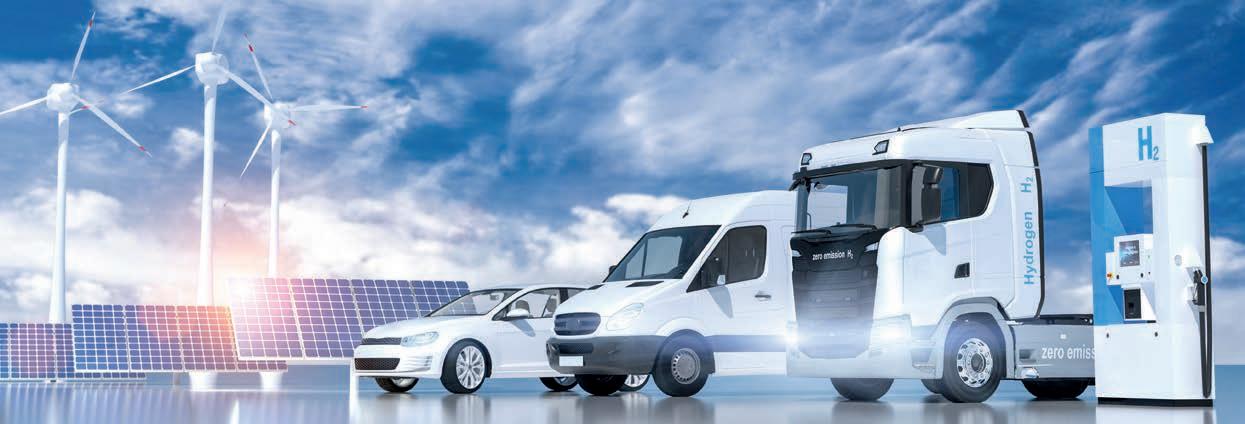
Electric vehicles (EVs) continue to gain traction as a cornerstone of sustainable transportation. Advances in battery technology, coupled with supportive policies and growing consumer demand, are driving the rapid expansion of the EV market.
The passenger EV market has seen exponential growth, with companies like Tesla, Nissan and Volkswagen leading the way. EVs offer the advantage of zero tailpipe emissions, reducing urban air pollution and contributing to climate goals.
• Tesla Model 3: The Tesla Model 3 remains one of the best-selling EVs worldwide, with over 500,000 units sold annually. Its success has encouraged other automakers to accelerate their EV programmes.
• Volkswagen ID.4: Volkswagen’s ID.4 is a versatile electric SUV that has been well-received in both the European and North American markets. Volkswagen aims to produce 1.5 million EVs annually by 2025, illustrating its commitment to an electric future.
Electric buses and trucks are transforming urban and regional transportation by offering clean and efficient alternatives to diesel-powered vehicles. These vehicles are particularly beneficial for reducing emissions in densely populated areas where the number of individuals/goods you can move for a given amount of space is also critical to reducing congestion.
• BYD electric buses: Chinese manufacturer BYD has delivered over 50,000 electric buses globally, making it a leader in this sector. Cities like Shenzhen have fully electrified their bus fleets, significantly improving air quality.
• Tesla Semi: Tesla’s electric semi-truck, the Tesla Semi, is designed for long-haul freight transport. With a range of up to 500 miles and lower operating costs, it is set to revolutionise the trucking industry.
The advancement and adoption of hydrogen and electric-powered solutions are bolstered by collaborative efforts among governments, industries and research institutions. These partnerships are crucial for overcoming technological, financial and infrastructural challenges.
Public-private partnerships (PPPs) are essential for funding and implementing large-scale sustainable transportation projects. Governments provide regulatory support and incentives, while private companies bring innovation and operational expertise.
• Hydrogen Mobility Europe (H2ME): H2ME is a PPP aimed at expanding hydrogen refuelling infrastructure across Europe. The initiative has deployed over 1,400 hydrogen vehicles and established 45 refuelling stations, making hydrogen transport more accessible.40
• Electrify America: Funded by Volkswagen as part of its emissions settlement, Electrify America is investing $2bn over ten years to expand EV charging infrastructure across the United States. The initiative has already installed over 500 charging stations, with plans for more.
Collaborative research and development efforts are driving innovations in sustainable transportation technologies. These collaborations bring together the best minds from academia, industry and government to tackle complex challenges.
• The Hydrogen Council: The Hydrogen Council is a global coalition of leading companies committed to advancing hydrogen technologies. Its members include major automakers, energy companies and industrial firms, all working together to accelerate the hydrogen economy.
• Battery 2030+: This European initiative aims to develop next-generation battery technologies through collaborative R&D. The project involves universities, research institutes, and companies working on breakthroughs in battery performance, safety and sustainability.
Japan’s Hydrogen Society vision
Japan is pioneering the transition to a hydrogen-based society, with the government setting ambitious targets for hydrogen production and utilisation. The country’s Basic Hydrogen Strategy aims to install 200,000 residential fuel cells and 320 hydrogen refuelling stations by 2025.41
• Tokyo’s hydrogen projects: Tokyo has implemented several hydrogen projects, including hydrogen-powered buses and a hydrogen supply chain for the 2020 Olympic Games. These initiatives have demonstrated the viability of hydrogen as a clean energy source for urban transport.
Norway’s electric vehicle adoption
Norway’s success in EV adoption serves as a model for other countries. With substantial government incentives, including tax exemptions, free parking and access to bus lanes, Norway has achieved the highest per capita EV ownership in the world.
• Oslo’s electric transport: The city of Oslo is on track to become the first city with a zero-emission public transport system by 2028. The city’s fleet of electric buses, ferries and trams significantly reduces urban emissions and sets a benchmark for sustainable urban transport.
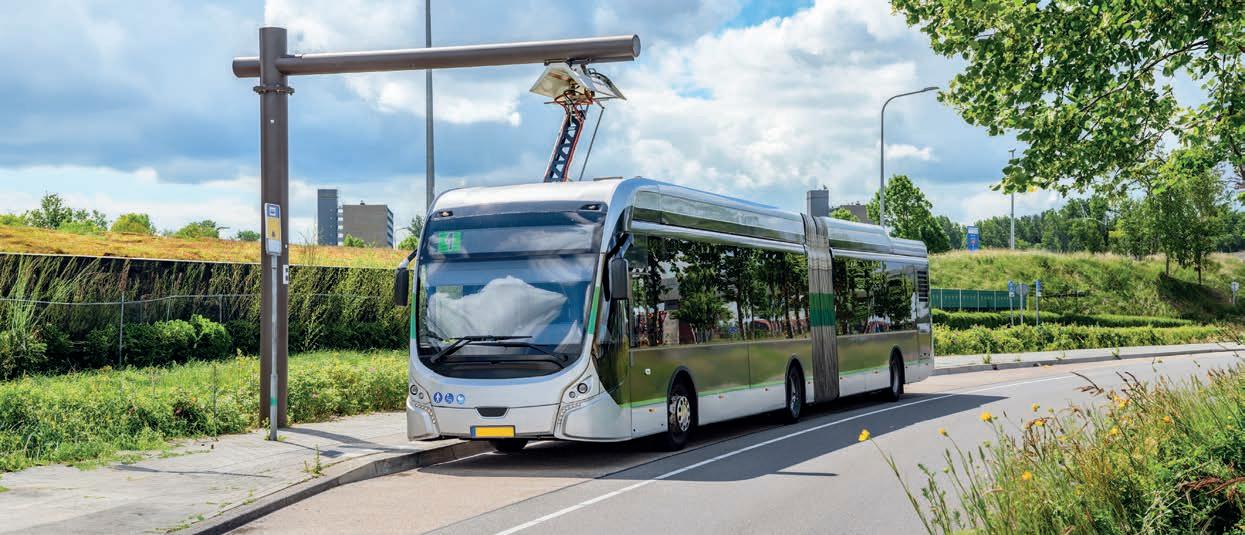
/FIDIC’s role in facilitating global engineering dialogue for sustainable solutions

In the face of mounting environmental challenges and the urgent need for sustainable development, the International Federation of Consulting Engineers (FIDIC) plays a pivotal role in facilitating global engineering dialogue. By fostering collaboration, advocating for best practices and providing a platform for knowledge exchange, FIDIC is instrumental in driving the transition towards sustainable transportation solutions. This chapter section explores FIDIC’s initiatives and impact, highlighting its commitment to promoting sustainable engineering practices worldwide.
FIDIC’s vision and mission
FIDIC’s mission is to represent the global consulting engineering industry and promote best practices in the engineering and construction sectors. Central to this mission is the organisation’s commitment to sustainability, which is embedded in its vision to create a resilient and sustainable built environment. FIDIC recognises that achieving this vision requires a collaborative, multidisciplinary approach that leverages the expertise of engineers, policymakers and industry leaders worldwide.
Key objectives:
1. Promote sustainable engineering practices: Advocate for the adoption of sustainable engineering solutions that minimize environmental impact and enhance societal wellbeing.
2. Foster global collaboration: Facilitate international dialogue and cooperation among engineers, policymakers and industry stakeholders to address global sustainability challenges.
3. Provide leadership and guidance: Offer leadership in developing and disseminating best practices, standards and guidelines for sustainable engineering.
Facilitating global dialogue
1. International conferences and workshops
FIDIC organises international conferences and workshops that serve as platforms for engineers, industry leaders and policymakers to share insights, discuss challenges and explore innovative solutions. These events are crucial for fostering a global dialogue on sustainability.
• FIDIC Global Infrastructure Conference: Held annually, this flagship event brings together thousands of professionals from around the world to discuss pressing issues in infrastructure development. The conference features sessions on sustainable transportation, highlighting the latest advancements in technology and best practices. For example, the 2023 conference in Singapore focused on the theme Resilient Infrastructure for a Sustainable Future, featuring keynote speeches and panel discussions on hydrogen and electric-powered transportation solutions.

• The Global Leadership Forum (GLF) Summit: The GLF Summit is one of FIDIC’s premier events, bringing together leaders from across the global infrastructure and engineering sectors. The exclusive GLF brings together some 100 leaders from across the globe to play a key role in helping to address global challenges and creating a united, influential, international voice for the infrastructure industry. The forum provides a powerful global network for leaders to discuss these issues. Through their discussions, deliberations and actions, a solid coalition of support and buy-in is being built for what needs to be done to address the key global challenges the world faces and, crucially, how we collaborate to solve them.
• Regional conferences: FIDIC also supports regional conferences that address local sustainability challenges. These events provide a platform for engineers to share region-specific knowledge and collaborate on solutions tailored to their unique contexts.
2. Knowledge sharing and best practice
FIDIC is dedicated to disseminating best practice and promoting knowledge sharing among its members and the broader engineering community. Through publications, webinars, and training programmes, FIDIC ensures that engineers have access to the latest information and tools needed to implement sustainable solutions.
• Publications and reports: FIDIC publishes a range of reports and guidelines on sustainable engineering practices. The State of the World report series, for example, provides in-depth analyses of critical sustainability issues and showcases successful projects and initiatives. These reports serve as valuable resources for engineers and policymakers alike.
• Webinars and online courses: FIDIC offers webinars and online courses on various aspects of sustainable engineering, from renewable energy integration to sustainable urban planning. These educational programmes enable professionals to stay informed about the latest developments and enhance their skills. FIDIC plans to significantly expand its educational offerings through the FIDIC Academy, which plays a crucial role in providing high-quality training and resources. The academy offers a wide range of online courses and workshops on various sustainability topics. These programmes are designed to equip engineers with the latest knowledge and skills needed to tackle emerging sustainability challenges. By leveraging the expertise of industry leaders and practitioners, the FIDIC Academy ensures that participants gain practical insights and cutting-edge tools to implement sustainable solutions effectively.
3. Policy advocacy and leadership
FIDIC plays a crucial role in advocating for policies that support sustainable engineering practices. By engaging with governments, international organisations, and industry bodies, FIDIC ensures that the voice of the engineering community is heard in policy discussions.
• Engagement with inter national organisations: FIDIC collaborates with organisations such as the United Nations and the World Bank to promote sustainability in infrastructure development. These partnerships facilitate the exchange of knowledge and best practice and support the implementation of global sustainability goals.
• Development of standards and guidelines: FIDIC contributes to the development of international standards and guidelines for sustainable engineering. These standards provide a framework for implementing best practices and ensuring consistency in sustainability efforts across different regions and sectors.
The importance of cross-sectoral partnerships in achieving global decarbonisation goals
Achieving global decarbonisation goals requires a multifaceted approach that transcends individual sectors and industries. Cross-sectoral partnerships are essential in leveraging the strengths, resources, and expertise of diverse stakeholders to drive the transformative changes needed. This chapter explores the critical role of these partnerships in advancing decarbonisation efforts, highlighting key collaborations, successful initiatives and the potential benefits of such integrative approaches.
The need for cross-sectoral collaboration
The complexity and scale of the decarbonisation challenge necessitate collaboration across various sectors, including energy, transportation, finance, technology and government. Each sector brings unique capabilities and perspectives, which, when combined, can create comprehensive and effective strategies for reducing carbon emissions.
1. Integrating expertise and resources
Cross-sectoral partnerships allow for the pooling of knowledge, technical expertise and financial resources. This integration is crucial for developing innovative solutions that can be scaled and adapted across different contexts.
• Example: The European Green Deal is a prime example of cross-sectoral collaboration, involving governments, private companies and civil society organisations. This ambitious initiative aims to make Europe the first climate-neutral continent by 2050. By integrating efforts across energy, transportation, agriculture and industry the European Green Deal addresses decarbonisation in a holistic manner.
2. Facilitating innovation and technology transfer
Collaborative efforts between sectors can accelerate the development and deployment of cutting-edge technologies. By sharing insights and best practices, partners can overcome technological barriers more efficiently.
• Example: The Hydrogen Council, a global initiative of leading energy, transport, and industrial companies, works to promote hydrogen as a key solution for clean energy transitions. This partnership facilitates the exchange of technological advancements and supports the commercialisation of hydrogen technologies across sectors.
Successful cross-sectoral partnerships
1. The C40 Cities Climate Leadership Group
The C40 Cities Climate Leadership Group exemplifies how cross-sectoral partnerships can drive urban decarbonisation. This network of the world’s megacities collaborates with businesses, governments and civil society to implement sustainable urban practices and policies.
• Achievements: C40 cities have committed to ambitious climate action plans, resulting in significant reductions in greenhouse gas emissions. For instance, London has implemented the Ultra Low Emission Zone (ULEZ), which has reduced vehicle emissions by 44% since its introduction.42
The Clean Energy Ministerial is a high-level forum that promotes policies and programmes to advance clean energy technologies. It brings together energy ministers from the world’s major economies, along with stakeholders from the private sector and international organisations.
• Achievements: CEM initiatives, such as the Electric Vehicles Initiative (EVI) and the Global Lighting Challenge, have facilitated the global adoption of clean technologies. The EVI has supported the deployment of over ten million electric vehicles worldwide, significantly contributing to emission

Financial institutions play a pivotal role in supporting decarbonisation efforts through investments and funding mechanisms. By collaborating with various sectors, these institutions can direct capital towards sustainable projects and innovations.
Green bonds and sustainable finance mechanisms enable the funding of projects that have positive environmental impacts. Financial institutions work with governments and businesses to develop and promote these financial instruments.
• Example: The World Bank has issued green bonds to finance renewable energy projects, energy efficiency improvements, and sustainable transportation initiatives. Since 2008, the World Bank has raised over $15bn through green bonds, supporting numerous decarbonisation projects worldwide.
PPPs are critical for mobilising private sector investments in public infrastructure projects. These partnerships combine public policy support with private sector efficiency and innovation, facilitating the development of sustainable infrastructure.
• Example: The Thames Tideway Tunnel in London is a notable PPP that addresses environmental challenges in urban areas. This project, designed to prevent sewage overflows into the River Thames, involves collaboration between the UK government, private investors and engineering firms. The tunnel, once completed, will significantly improve water quality and contribute to urban sustainability.43
Benefits of cross-sectoral partnerships
Cross-sectoral partnerships offer numerous benefits, making them indispensable for achieving global decarbonisation goals.
By bringing together diverse stakeholders, cross-sectoral partnerships can develop comprehensive solutions that address multiple aspects of decarbonisation. These solutions are more likely to be effective and sustainable in the long term.
Increased innovation
Collaboration fosters innovation by combining different perspectives and expertise. This can lead to the development of novel technologies and practices that might not emerge within siloed sectors.
Partnerships enhance resilience by creating systems that can adapt to changing conditions and challenges. By working together, sectors can develop more robust strategies that are better equipped to handle uncertainties.
Cross-sectoral partnerships can accelerate the pace of decarbonisation by leveraging the strengths of each partner. This synergy enables faster implementation of solutions and greater impact.
Cross-sectoral partnerships are essential for achieving global decarbonisation goals. By integrating expertise, resources and innovation from diverse sectors, these partnerships can develop comprehensive and effective solutions to address the pressing challenges of climate change. FIDIC’s role in promoting and facilitating these partnerships underscores its commitment to sustainability and its vision of a resilient and sustainable built environment. Through continued collaboration and dialogue, the global community can accelerate the transition towards a decarbonised future, ensuring a sustainable legacy for generations to come.
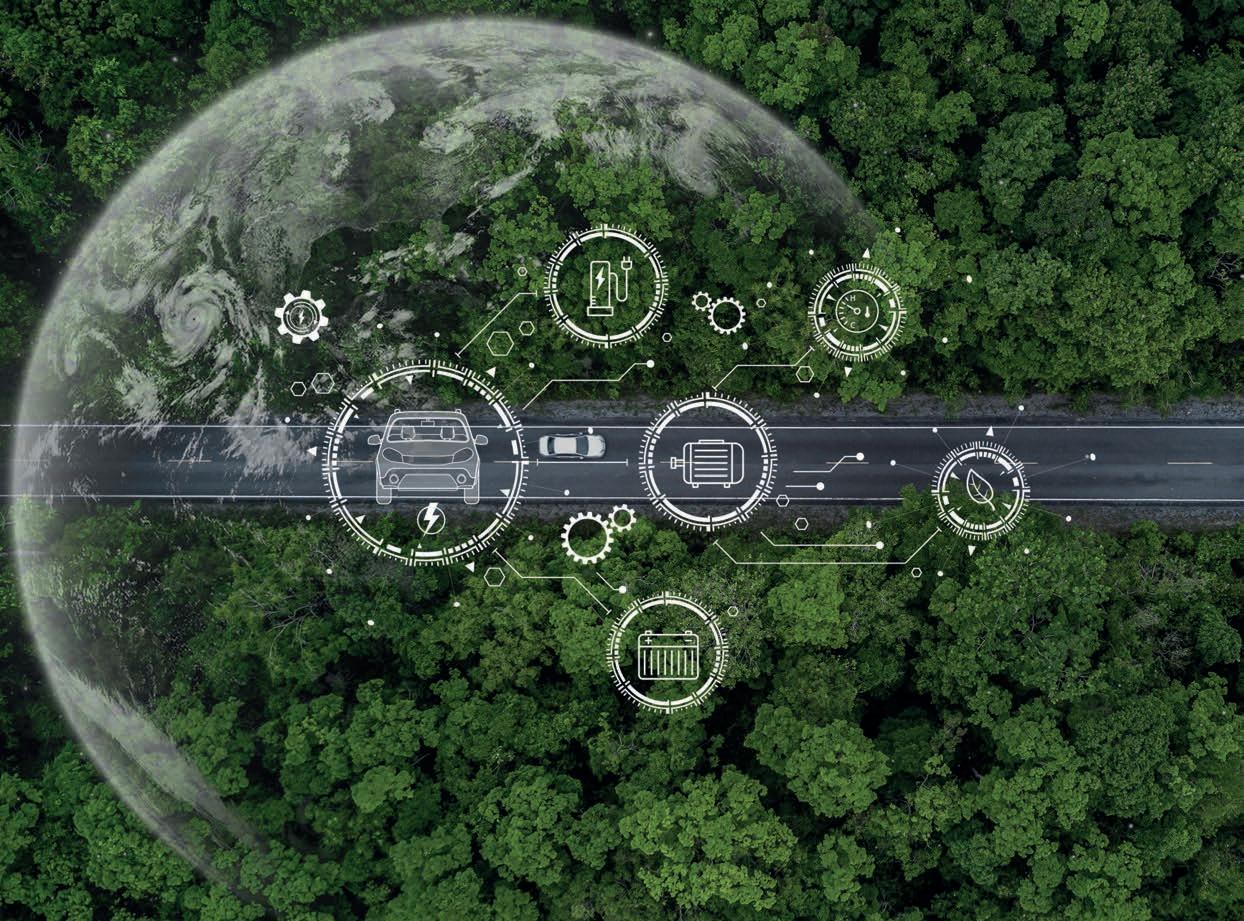

As we draw the insights and analyses of this comprehensive report on Tomorrow’s Transportation and the Decarbonisation Challenge to a close, the imperative for an integrated approach to solving the environmental challenges posed by the transportation sector is abundantly clear.
The journey towards sustainable transportation necessitates the collective effort of engineers, policymakers, industry leaders and the global community. This report has highlighted the multifaceted strategies and innovations essential for reducing carbon emissions and promoting sustainability within aviation, shipping and marine transportation.
The path forward is challenging, but the potential for positive impact is immense. The transportation sector’s transition to sustainability is not just a necessity, it is an opportunity to innovate, collaborate and lead by example. FIDIC’s commitment to sustainability and its efforts to promote integrated solutions highlight the crucial role of the entire FIDIC community in this journey.
As we move forward, let us embrace the imperative for an integrated approach, support ongoing innovation, foster collaboration and advocate for policies that drive sustainable transportation. By doing so, we can build a resilient, efficient and environmentally friendly transportation sector that meets the needs of today and ensures a sustainable future for generations to come.

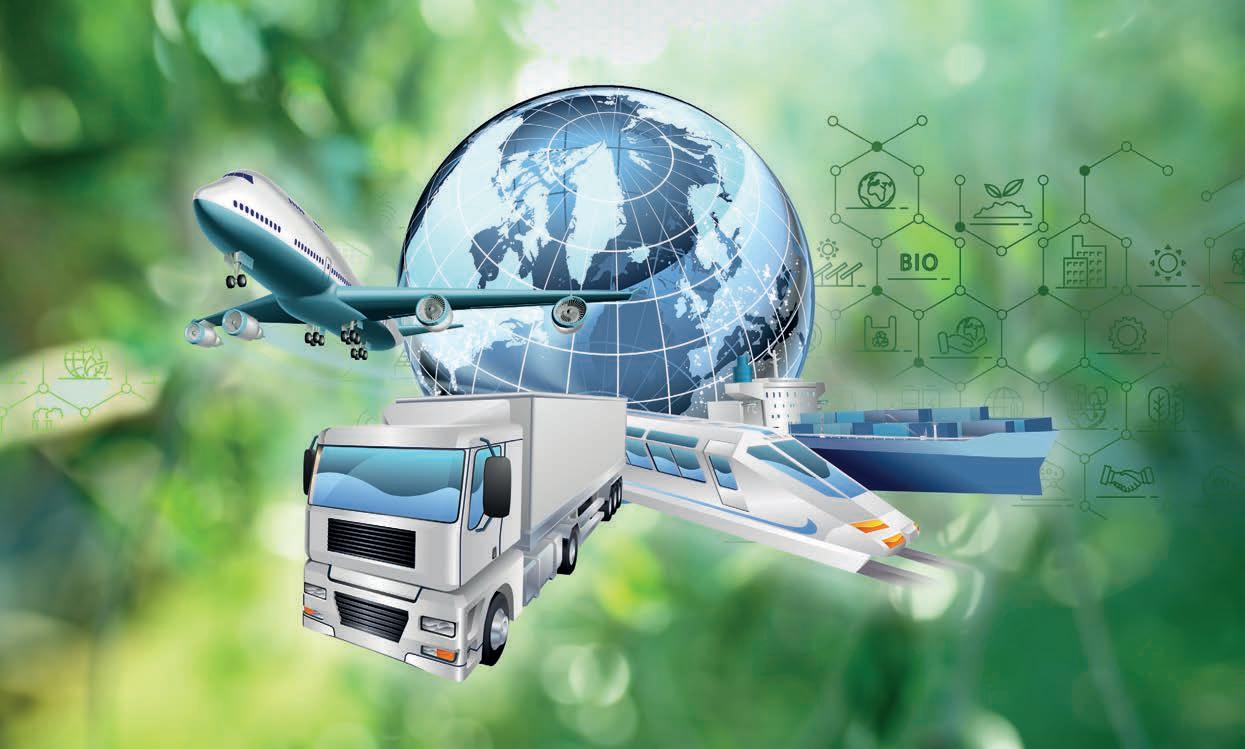
FIDIC in the production of the State of the World series would like to thank the following groups and individuals for their contributions to this publication.
As with all document and research produced by FIDIC the board play a vital role in ensuring that quality, integrity, and direction of such publications, as such the report thanks the board members for their contribution to this publication.
FIDIC is only possible because of the hard work of its staff team and this report would like to recognise the efforts of the individuals within the FIDIC secretariat to make this report possible. The FIDIC board will continue to support and endorse the actions of the secretariat to deliver for its members and the wider infrastructure sector.
Author
• Basma Eissa, Head of Policy, ESG & Sustainability, FIDIC.
Reviewers
FIDIC’s research is important and covers a global stage. As such, FIDIC research is peer reviewed by several independent individuals and a selected board member to help ensure its quality. FIDIC would therefore like to take this opportunity to thank the following.
• Catherine Karakatsanis, President, FIDIC.
• Graham Pontin, Director Policy, External Affairs & Communications, FIDIC.
Contributors
FIDICs reports do not only focus on FIDIC’s objectives, but by their nature are a culmination of industries’ expertise and professionalism and as such there are always contributors to FIDIC’s reports. In this one we wish to recognise the following:
• Tracey Ryan, Managing Director, Aurecon.
• Andy Walker, Communications Advisor and Contributing Editor (Infrastructure Global), FIDIC.
We would also like to thank all the FIDIC member associations that generously contributed to this report.
Thanking our member association partners
FIDIC would like to thank its global member associations, without which FIDIC would not exist. Their support in all that FIDIC does is very much appreciated, including where we have engaged with member associations during the compilation of this report.
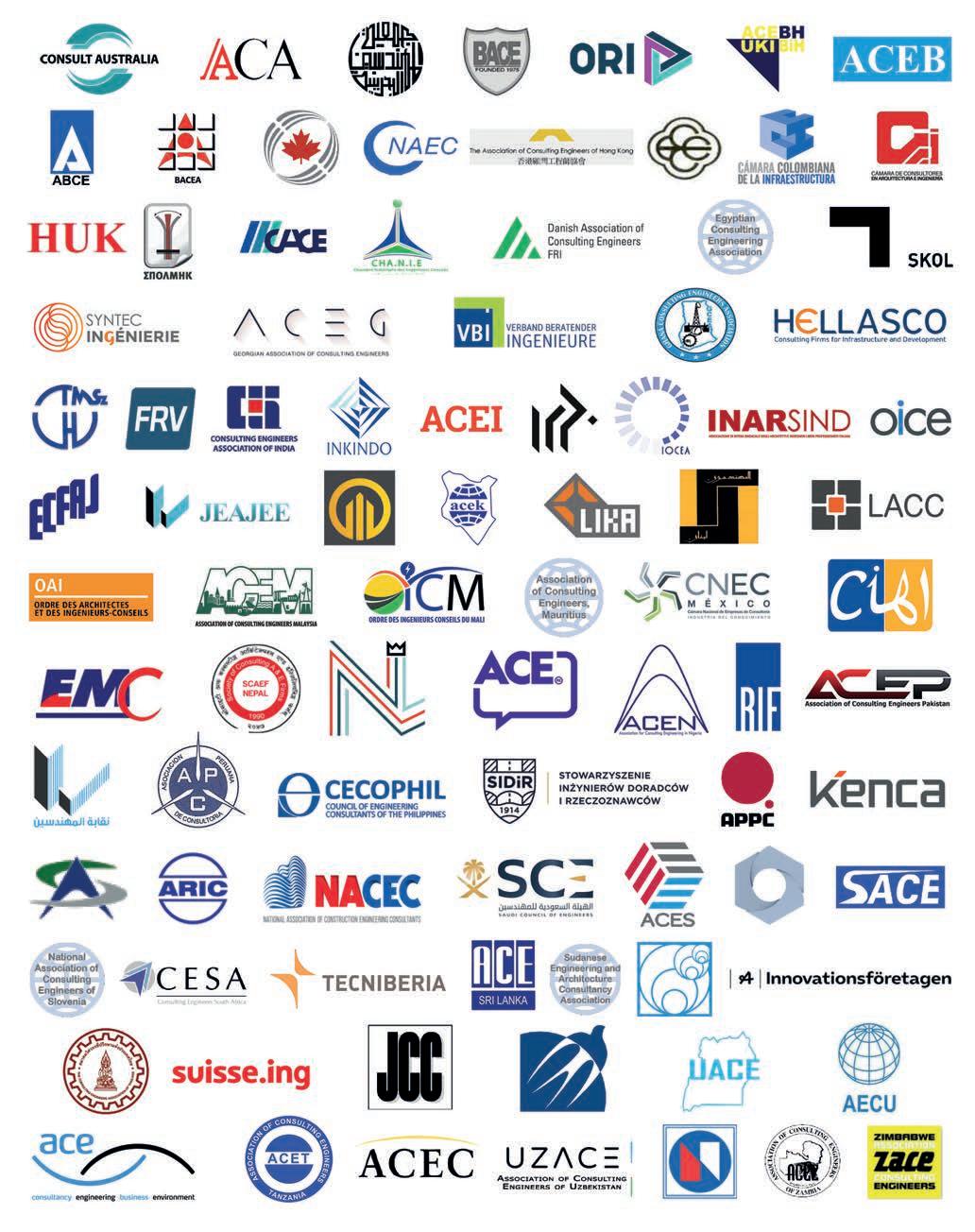
FIDIC, the International Federation of Consulting Engineers, is the global representative body for national associations of consulting engineers and represents over one million engineering professionals and 40,000 firms in around 100 countries worldwide.
Founded in 1913, FIDIC is charged with promoting and implementing the consulting engineering industry’s strategic goals on behalf of its member associations and to disseminate information and resources of interest to its members.
FIDIC, in the furtherance of its goals, publishes international standard forms of contracts for works and for clients, consultants, sub-consultants, joint ventures and representatives, together with related materials such as standard pre-qualification forms.
FIDIC also publishes business practice documents such as policy statements, position papers, guidelines, training manuals and training resource kits in the areas of management systems (quality management, risk management, business integrity management, environment management, sustainability) and business processes (consultant selection, quality-based selection, tendering, procurement, insurance, liability, technology transfer, capacity building).
FIDIC organises the annual FIDIC Global Infrastructure Conference and an extensive programme of seminars, capacity building workshops and training courses.
FIDIC 2020-2024 priorities
Lead the consulting and engineering industry visibly and effectively:
• Being the industry’s credible global voice
• Providing the nexus for all stakeholders
• Facilitating improvement and growth in business
• Addressing global challenges
All of the above is for the benefit of society, FIDIC members and their member firms.
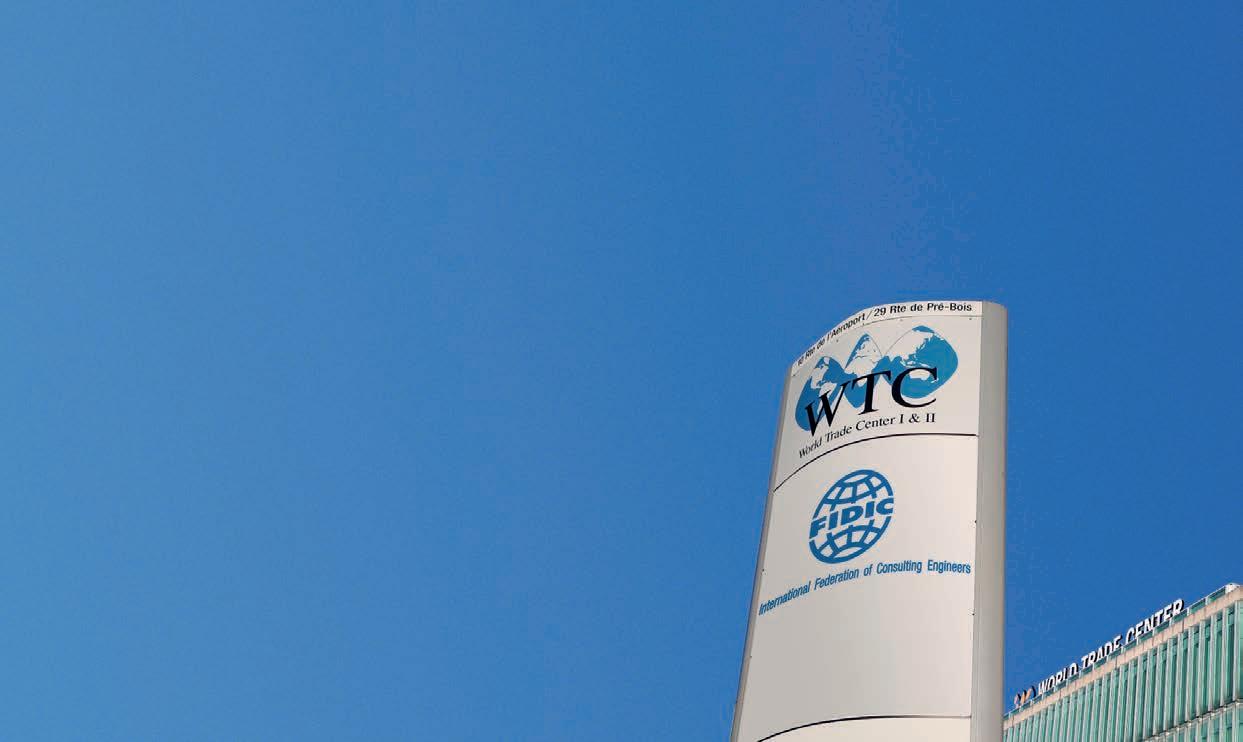

We are pleased to present the first update to the recently relaunched State of the World series. In 2022 we produced the first State of the World anti-corruption report and it reminded us that corruption is still a real and significant issue.As evidenced by international public law and the domestic laws made according to the public policy of nation states, corruption is not and should not be acceptable. This State of the World report update uses the latest information to update our 2022 analysis and outlines figures on its effects, considers the relationships between economic, industry and Foreign Direct Investment (FDI) flows and the perceptions of corruption.
Click here to download

In 2023, FIDIC celebrates its 110-year anniversary and this milestone is one to celebrate but it is also a reminder that, whilst history is important, we also need to continue to look forward.In this report, FIDIC, the International Federation of Consulting Engineers, underscores its pivotal position in the realm of sustainable infrastructure and engineering solutions. FIDIC takes a staunch stance on the role of infrastructure in advancing global sustainability, emphasising the importance of aligning projects with the UN sustainable development goals (SDGs). The organisation advocates for an approach that engages engineers in the earliest stages of project conception, with a heightened focus on societal and community impact.
Click here to download
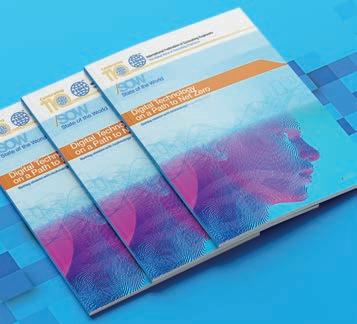
In 2022 FIDIC produced its Digital disruption and the evolution of the infrastructure sector State of the World report. This report outlined not only the pace of change but also the role of technology as a potential disrupter to industries changing their business model as a result of shifts in technology, data and/or how a combination of how customers/clients and the sector can access and use such information. It is, however, not only important to recognise that change is constant, but also that if we are going to meet challenges such as net zero, it is inevitable. In this latest State of the World report, we explore the practical role technology currently has in the development of infrastructure and also how this will change as we move forward with increased retrofitting, carbon reduction and increasing cooperation.
Click here to download
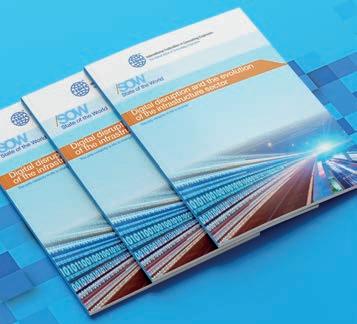
This report explores the pace of this technological change and shows that not only is the pace of change significant, but that many of the technology companies we use today for day-to-day activities in the grand scheme of time are actually very young and company longevity is continuing to decline. This suggests that not only is the pace of change faster, but the companies and people we deal with today may not be the ones we are dealing with in ten years’ time. We also discuss the role of technology as a potential disrupter to industries changing their business model as a result of shifts in technology, data and/or how a combination of how customers/ clients and the sector can access and use such information. It is then also important to look at the role of technology as an innovator and as something which drives real changes and improvements. What does it mean in terms of big data, artificial intelligence, customer lead data and more devolvement of smart devices?
Click here to download
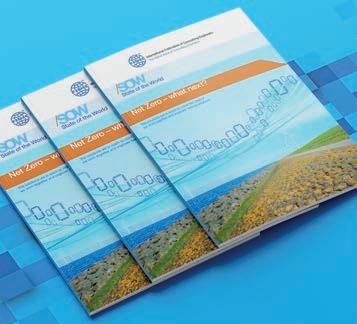
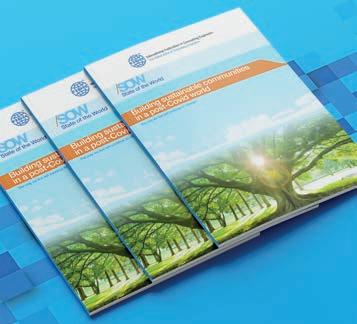
Net Zero. It could be argued that we have only just begun, but such ambitions were set decades ago. Yes, to hit a target you first have to create one and to reach that target you have to gain acceptance, political support, industry support and then delivery through all related activity. FIDIC, as the global voice of engineering and infrastructure, asks not only what is next but we also provide the next global target. This target not only helps to achieve our current trajectory but also sets the kind of ambitions the engineering sector and humanity should be proud to achieve. We go beyond Net Zero and ask “what next?” Find out more about what comes next after Net Zero by attending the launch of “Net Zero... so, what next?”, the fifth report in the FIDIC State of the World series.
Click here to download
The world is gradually learning what it means to be sustainable as we march towards achieving the 2030 UN Sustainable Development Goals and approach net zero, but should we simply be adapting our current way of living or thinking about a new way of life? The Covid pandemic has demonstrated that remote working is not just the digital dream of IT professionals and visionaries, but is and can be real life. Do we need cities? Is urbanisation going to continue? Alternatively, should we be looking at the airline industry and the ‘hub and spoke’ model as the future for communities where most activity can happen locally in a more sustainable way via serviced offices, with only occasional visits to major hubs? The world is changing and this State of the World report asks: “are we changing quick enough to match the way communities want to live not only tomorrow, but today?”
Click here to download
World Trade Center II, Geneva Airport P.O. Box 311 CH-1215 Geneva 15 - Switzerland
Tel. +41 22 568 0500
Email: fidic@fidic.org
Website: www.fidic.org
Disclaimer
This document was produced by FIDIC and is provided for informative purposes only. The contents of this document are general in nature and therefore should not be applied to the specific circumstances of individuals. Whilst we undertake every effort to ensure that the information within this document is complete and up to date, it should not be relied upon as the basis for investment, commercial, professional, or legal decisions.
FIDIC accepts no liability in respect to any direct, implied, statutory and/or consequential loss arising from the use of this document or its contents. No part of this report may be copied either in whole or in part without the express permission of FIDIC in writing.
[1] United Airlines. (n.d.). Roadmap to net zero. United Airlines Corporate Responsibility Report. Retrieved from https://crreport.united.com/environmental-sustainability/roadmap-to-net-zero
[2] Linde. (n.d.). Aviation : Hydrogen applications. Linde. Retrieved from https://www.linde.com/clean-energy/ h2-applications/aviation
[3] World Economic Forum. (2021). Clean skies for tomorrow: Sustainable aviation fuels as a pathway to net-zero aviation for India. World Economic Forum. Retrieved from https://www3.weforum.org/docs/WEF_ Clean_Skies_for_Tomorrow_India_Report_2021.pdf
[4] United Airlines. (2021). CDP climate change 2021 response. United Airlines. Retrieved from https:// crreport.united.com/documents/United-Airlines-CDP-2021.pdf
[5] Lufthansa Group. (2011). Sustainability report 2011. Lufthansa Group. Retrieved from https://www. lufthansagroup.com/media/downloads/en/responsibility/LH-sustainability-report-2011.pdf
[6] International Air Transport Association. May 2024. Fact sheet - Alternative fuels. Retrieved from https:// www.iata.org/en/iata-repository/pressroom/fact-sheets/fact-sheet---alternative-fuels/
[7] SkyNRG. (n.d.). Technology basics. Retrieved from https://skynrg.com/sustainable-aviation-fuel/ technology-basics/
[8] Li, X., Zhang, Y., & Chen, Z. (2023). Sustainable aviation fuel production from biomass: Technologies, challenges, and prospects. Journal of Cleaner Production, 407, 136983. Retrieved from https://www. sciencedirect.com/science/article/pii/S2214914723002581
[9] Sustainable Aviation Futures. (n.d.). E-fuels & PtL. Retrieved from https://www.sustainableaviationfutures. com/training-courses/efuels-ptl
[10] LanzaTech. (2022, October). LanzaTech produces ethylene from CO2, changing the way we make products today. Retrieved from https://lanzatech.com/lanzatech-produces-ethylene-from-co2-changingthe-way-we-make-products-today/
[11] International Civil Aviation Organization. (n.d.). Sustainable aviation fuels (SAF). Retrieved from https:// www.icao.int/environmental-protection/pages/SAF.aspx
[12] World Economic Forum. (2021, November). Clean skies for tomorrow: Sustainable aviation fuel policy toolkit. Retrieved from https://www.weforum.org/publications/clean-skies-for-tomorrow-sustainable-aviation-fuel-policy-toolkit/
[13] International Council on Clean Transportation. (2020, January). The climate implications of using LNG as a marine fuel. Retrieved from https://theicct.org/sites/default/files/publications/Climate_implications_LNG_ marinefuel_01282020.pdf
[14] CMA CGM. (October, 2020). The CMA CGM Jacques Saadé, the world’s largest liquefied natural gas-powered containership, has set a new world record for the number of full containers loaded on a single vessel. Retrieved from https://www.cma-cgm.com/news/3337/the-cma-cgm-jacques-saade-theworld-s-largest-liquefied-natural-gas-powered-containership-has-set-a-new-world-record-for-the-numberof-full-containers-loaded-on-a-single-vessel
[15] Stena Line. (2023, May). Stena Line boosts freight capacity on Irish Sea with two all-new NewMax hybrid vessels. Retrieved from https://stenaline.com/media/stories/stena-line-boosts-freight-capacity-on-irishsea-with-two-all-new-newmax-hybrid-vessels/
[16] Shippax. (June, 2022). Fully electric Ellen ferry establishes world record: 90-kilometer voyage on a single battery charge. Retrieved from https://www.shippax.com/en/press-releases/fully-electric-ellen-ferry-establishes-world-record-90-kilometer-voyage-on-a-single-battery-charge.asp
[17] Yara International. (2024). Yara Birkeland press kit. Retrieved from https://www.yara.com/ news-and-media/media-library/press-kits/yara-birkeland-press-kit/
[18] Maritime and Port Authority of Singapore. (2022, May). Enhancement of the Maritime Singapore Green Initiative: Green Port Programme (GPP). Retrieved from https://www.mpa.gov.sg/media-centre/details/enhancement-of-the-maritime-singapore-green-initiative-green-port-programme-(gpp)
[19] Zhu, S., Lv, S., Chen, K., Fang, W., & Cao, L. (2024). Research progress on intelligent optimization techniques for energy-efficient design of ship hull forms. arXiv. Retrieved from https://arxiv.org/ html/2403.05832v1
[20] Enevoldsen, P., & Sovacool, B. K. (2021). Examining the social acceptance of wind energy: Practical guidelines for onshore wind project development in France. Renewable and Sustainable Energy Reviews, 145, 111067. Retrieved from https://www.sciencedirect.com/science/article/abs/pii/S1364032120304366
[21] International Maritime Organization. (2000). First IMO GHG study 2000. Retrieved from https://wwwcdn. imo.org/localresources/en/OurWork/Environment/Documents/First%20IMO%20GHG%20study.pdf
[22] Smartr. (2023). The business case for smart building solutions. Retrieved from https://lp.smartr.build/business-case-for-smart-building-solution
[23] Marine Digital. (n.d.). Smart ships: The future of maritime industry. Retrieved from https://marine-digital. com/article_smartship
[24] Maersk. (n.d.). Implement predictive data analytics. Retrieved from https://innovation.maersk.com/implement-predictive-data-analytics
[25] Business Reporter. (n.d.). Artificial intelligence helps ships reduce fuel consumption. Retrieved from https:// www.business-reporter.co.uk/technology/artificial-intelligence-helps-ships-reduce-fuel-consumption
[26] European Maritime Safety Agency. (n.d.). New technologies. Retrieved from https://www.emsa.europa.eu/ sustainable-shipping/new-technologies.html
[27] Sustainable World Ports. (2021). Port of Colombo GHG emission reduction project. Retrieved from https:// sustainableworldports.org/project/port-of-colombo-ghg-emission-reduction-project/
[28] Sustainable World Ports. (2021). North Sea Port solar park. Retrieved from https://sustainableworldports. org/project/north-sea-port-solar-park/
[29] WindEurope. (September, 2023). Offshore wind ports. Retrieved from https://windeurope.org/policy/ topics/offshore-wind-ports/
[30] Aquatera. (February, 2024). PORTWASTE II: Blue innovation in the Canaries to improve waste management in ports. Retrieved from https://www.aquatera.co.uk/news/portwaste-ii-blue-innovation-inthe-canaries-to-improve-waste-management-in-ports
[31] Ellen MacArthur Foundation. (n.d.). The circular economy in detail: Deep dive. Retrieved from https://www. ellenmacarthurfoundation.org/the-circular-economy-in-detail-deep-dive
[32] Port of Los Angeles. (2006). San Pedro Bay Ports Clean Air Action Plan. Retrieved from https://www. portoflosangeles.org/environment/air-quality/san-pedro-bay-ports-clean-air-action-plan
[33] Philippine Ports Authority. (2022). PPA prioritizes ‘green port’ initiatives, bats for sustainable port operations. Retrieved from https://www.ppa.com.ph/content/ppa-prioritizes-%E2%80%98green-port%E2 %80%99-initiatives-bats-sustainable-port-operations
[34] WWF Canada. (2022, June 1). WWF ship speed report. Retrieved from https://wwf.ca/wp-content/ uploads/2022/06/WWF_Ship_Speed_Report_v2.2_2022-06-01.pdf
[35] United Nations Environment Programme. (n.d.). Global clean ports. Retrieved from https://www.unep.org/ explore-topics/transport/what-we-do/global-clean-ports
[36] International Maritime Organization. (n.d.). International Convention for the Prevention of Pollution from Ships (MARPOL). Retrieved from https://www.imo.org/en/about/Conventions/Pages/International-Convention-for-the-Prevention-of-Pollution-from-Ships-(MARPOL).aspx
[37] Bureau of Energy Efficiency. (n.d.). Department of Heavy Industry (DHI). Retrieved from https://evyatra. beeindia.gov.in/central-govt-initiative-details/dhi-2/
[38] McKinsey & Company. (January, 2021). How charging in buildings can power up the electric-vehicle industry. Retrieved from https://www.mckinsey.com/industries/electric-power-and-natural-gas/ our-insights/how-charging-in-buildings-can-power-up-the-electric-vehicle-industry
[39] MHA. (March, 2024). Sustainability & ESG: The future of transportation. Retrieved from https://www.mha. co.uk/insights/sustainability-esg-the-future-of-transportation
[40] Hydrogen Mobility Europe. (n.d.). Hydrogen Mobility Europe (H2ME). Retrieved from https://h2me.eu/
[41] World Economic Forum. (2024, April). Hydrogen: Japan’s ambitious plans for a green energy future. Retrieved from https://www.weforum.org/agenda/2024/04/hydrogen-japan/
[42] Climate & Clean Air Coalition. (2020). C40 Cities Climate Leadership Group. Retrieved from https://www. ccacoalition.org/partners/c40-cities-climate-leadership-group
[43] European Bank for Reconstruction and Development. (2023). Public-private partnerships for promoting sustainable development goals. In Law in transition 2023. Retrieved from https://www.ebrd.com/ documents/ogc/law-in-transition-2023-publicprivate-partnerships-for-promoting-sustainable-development-goals.pdf